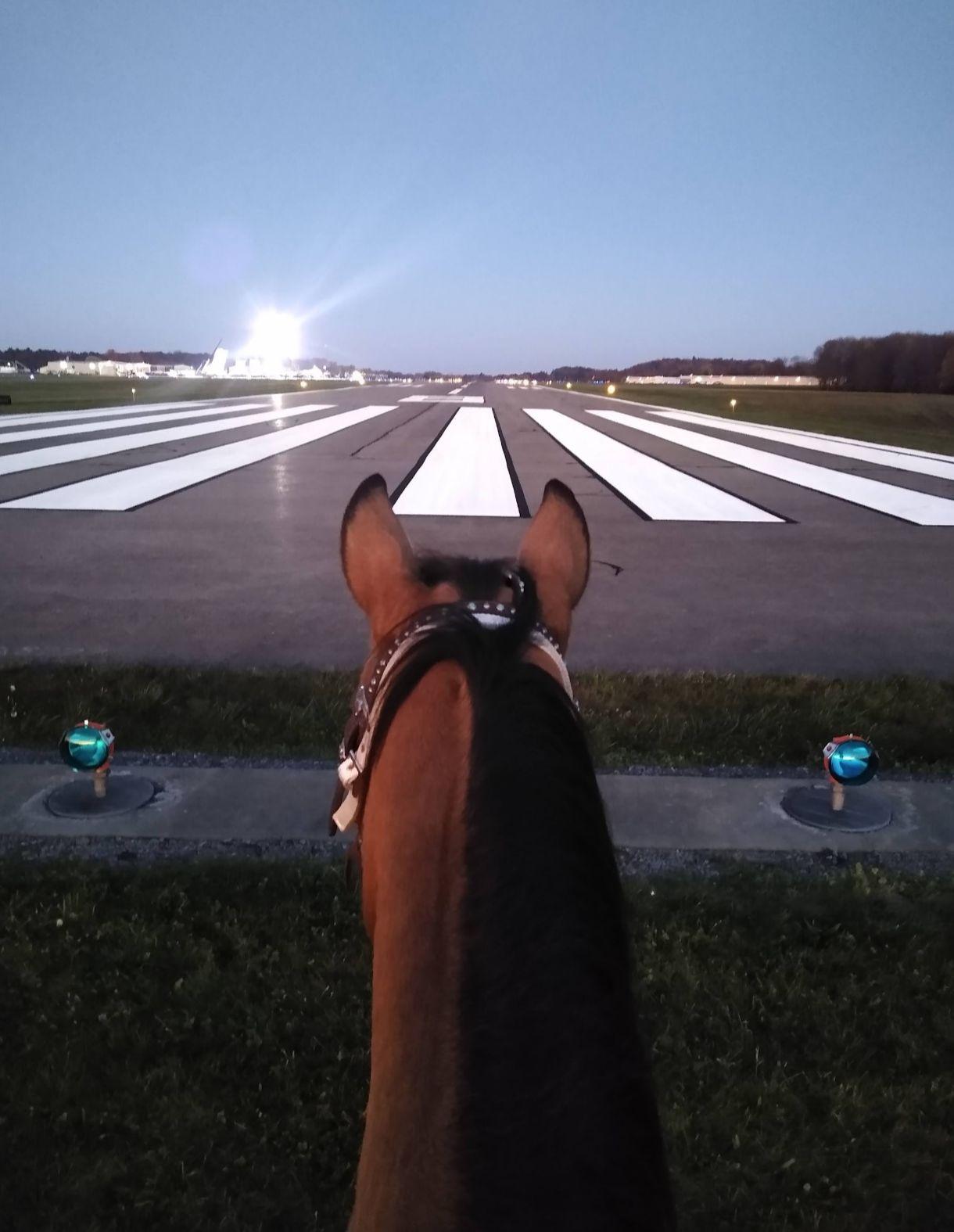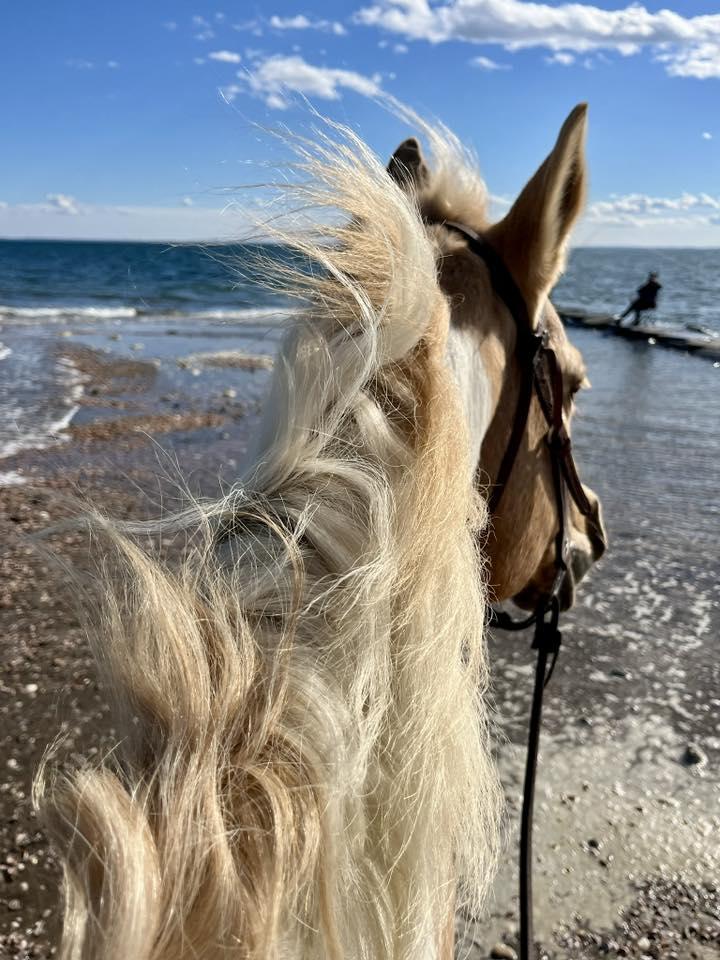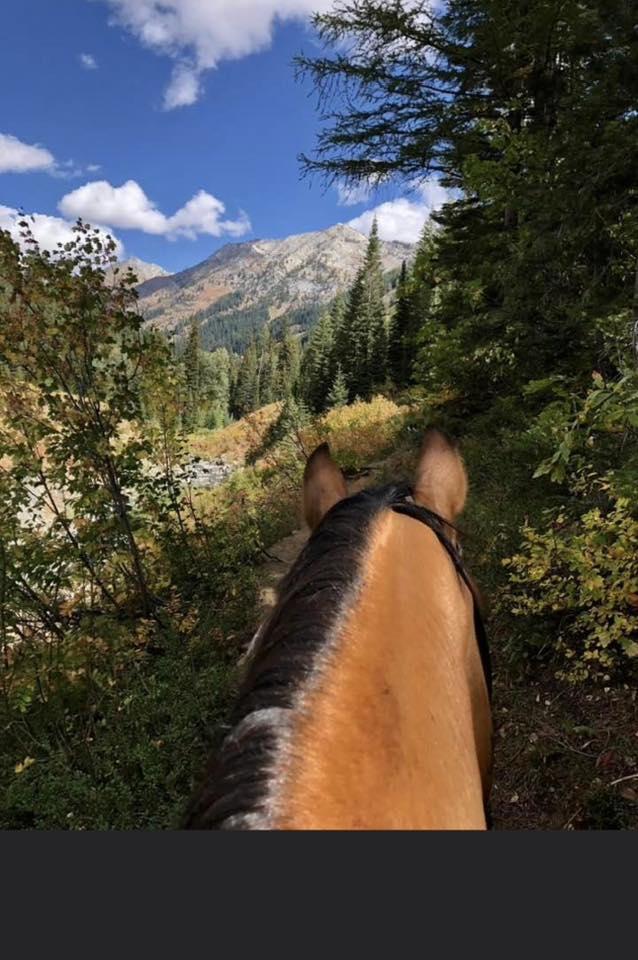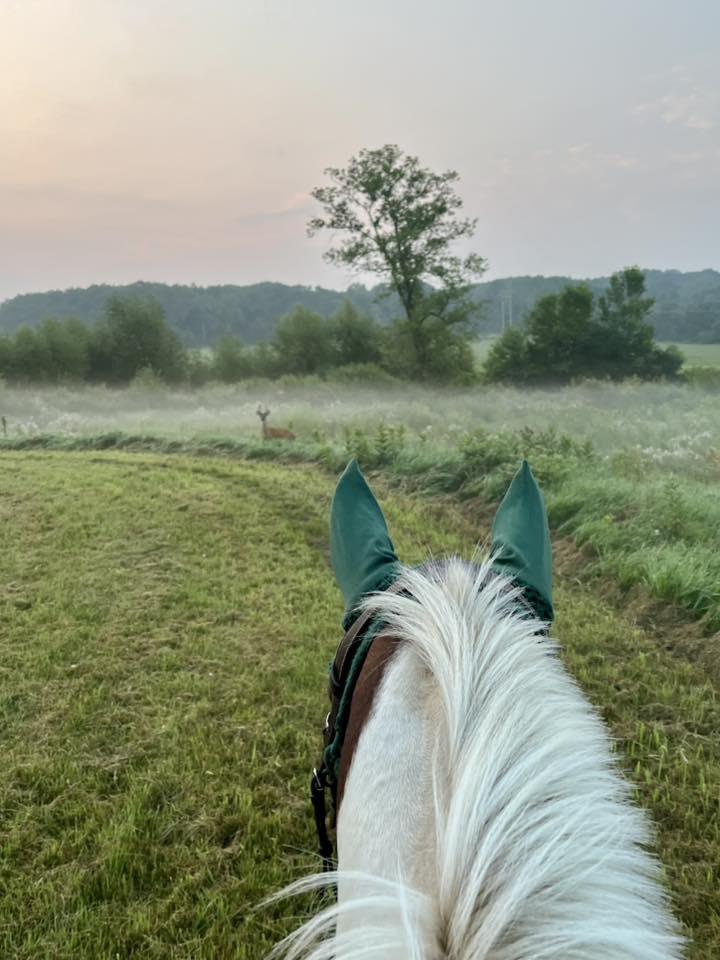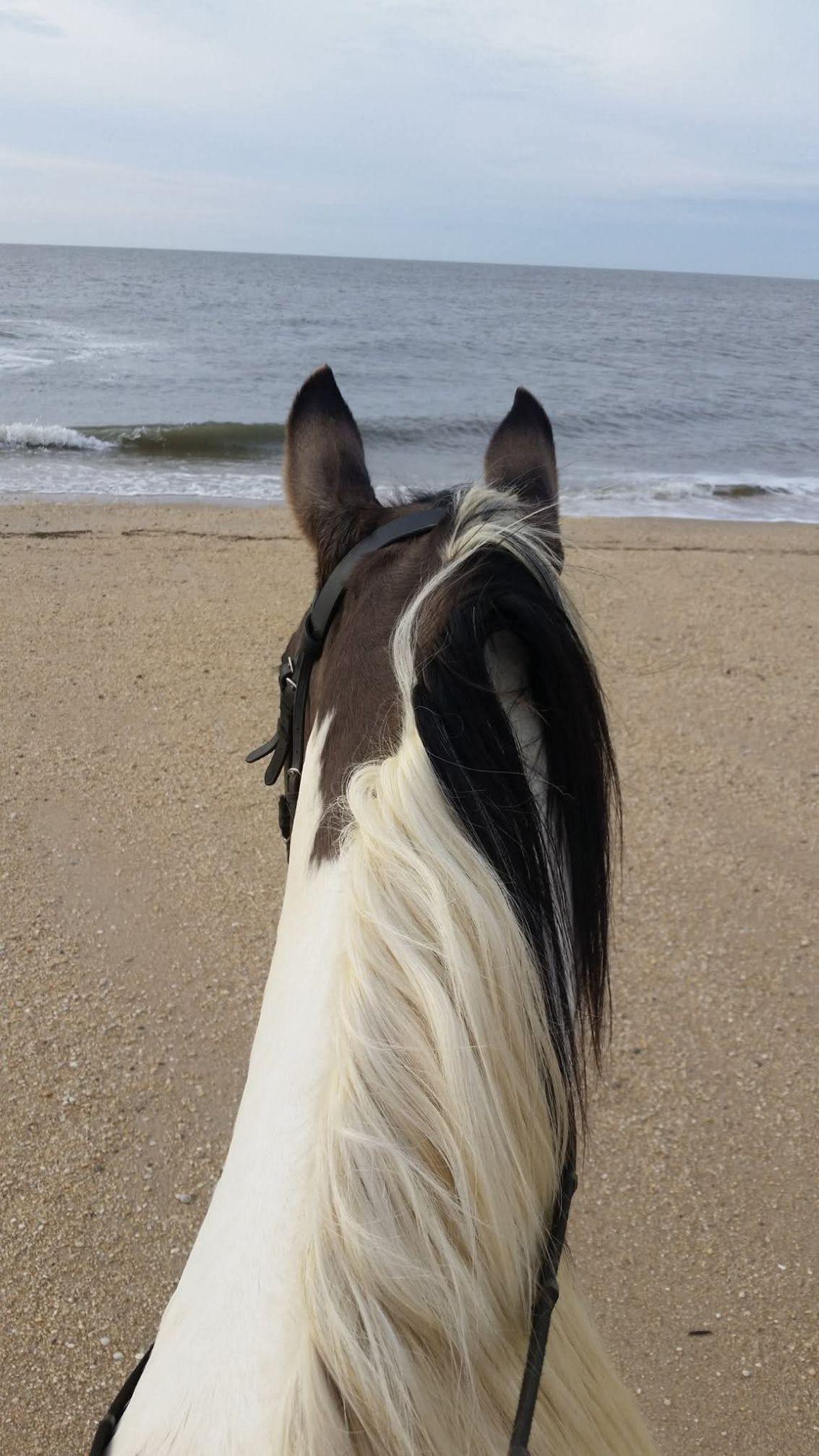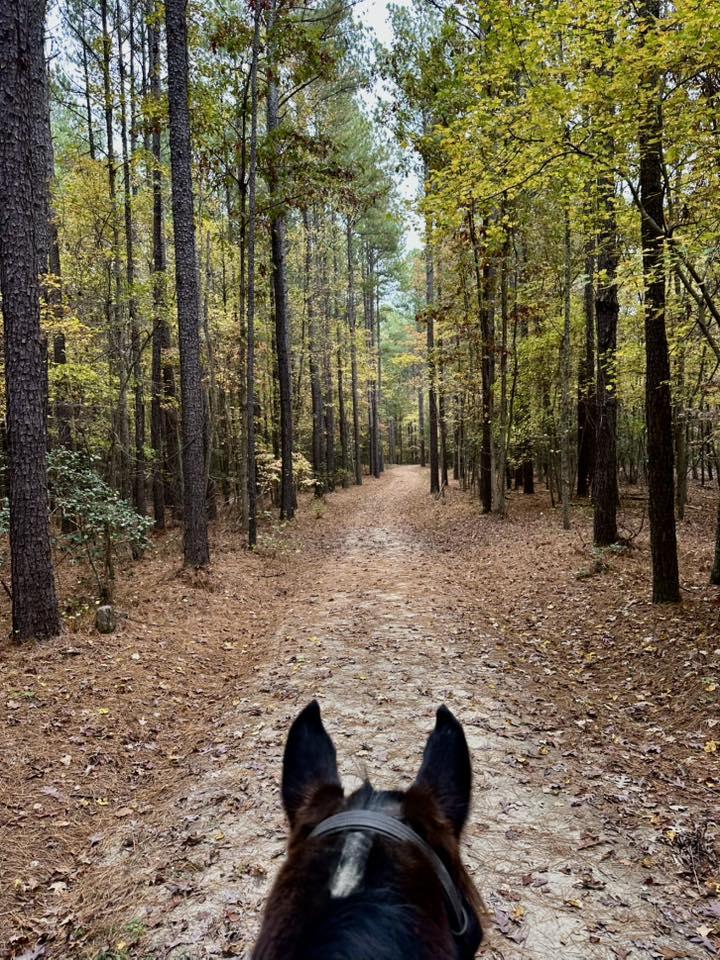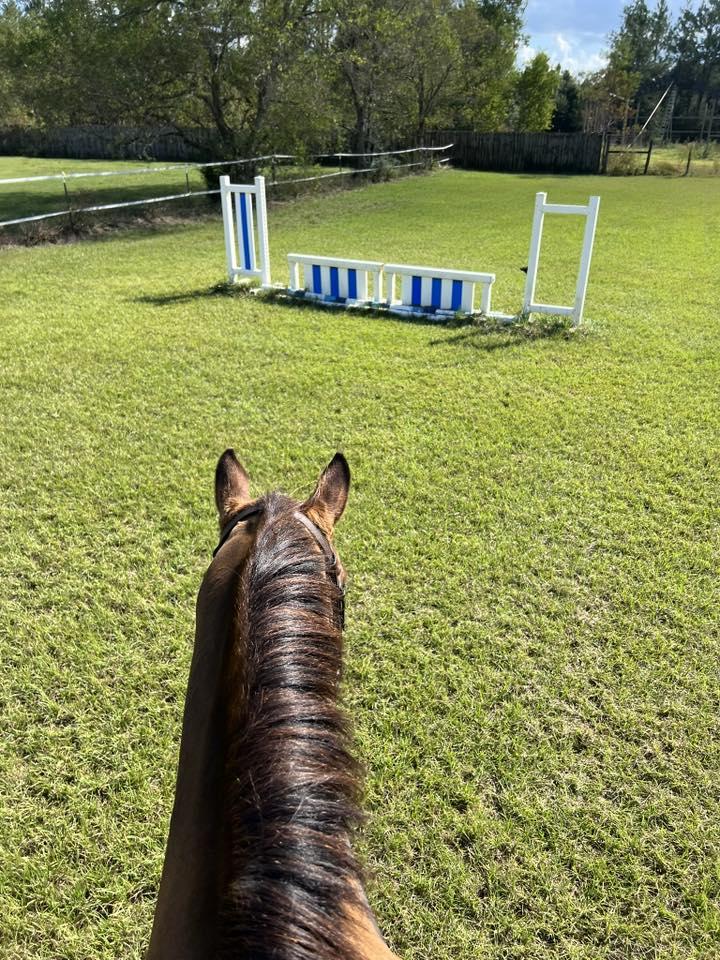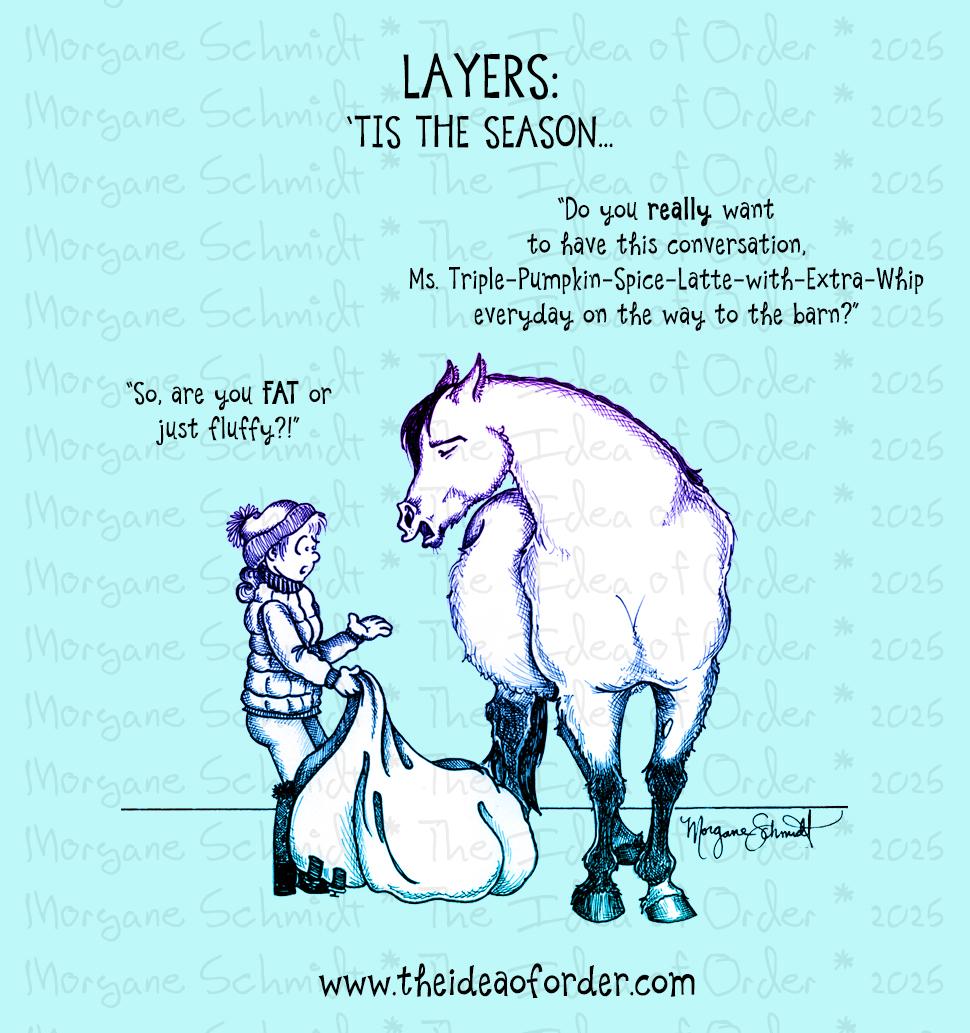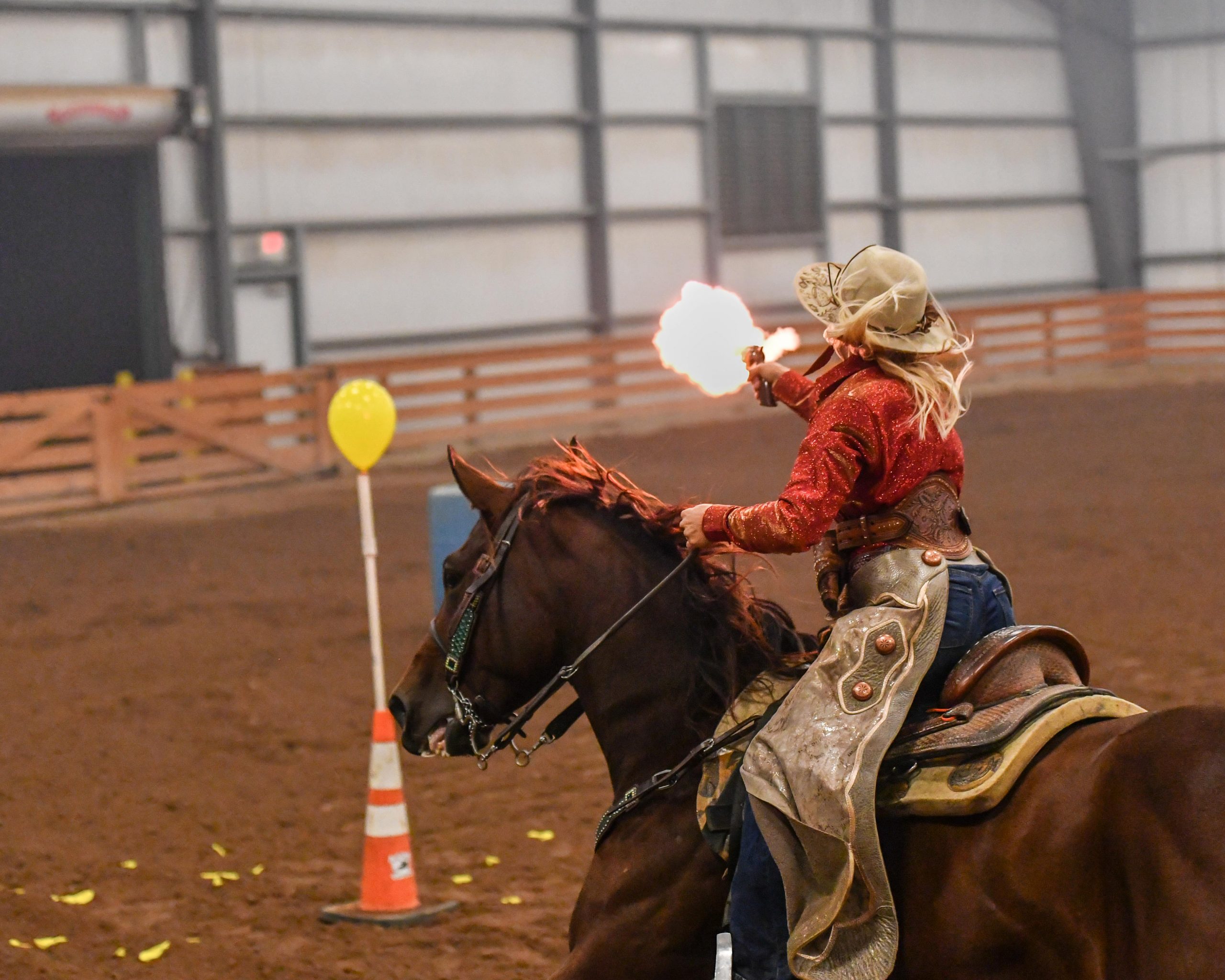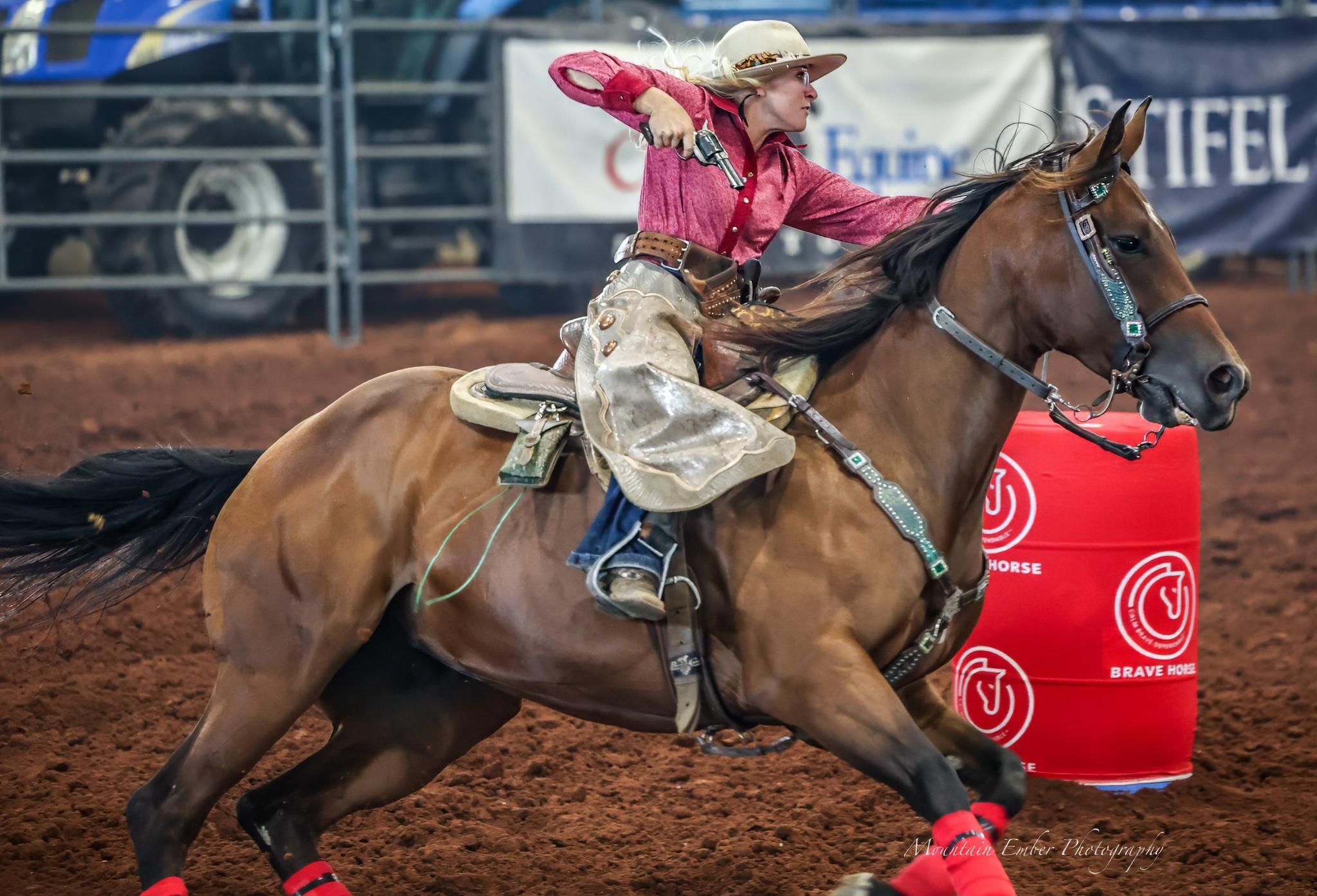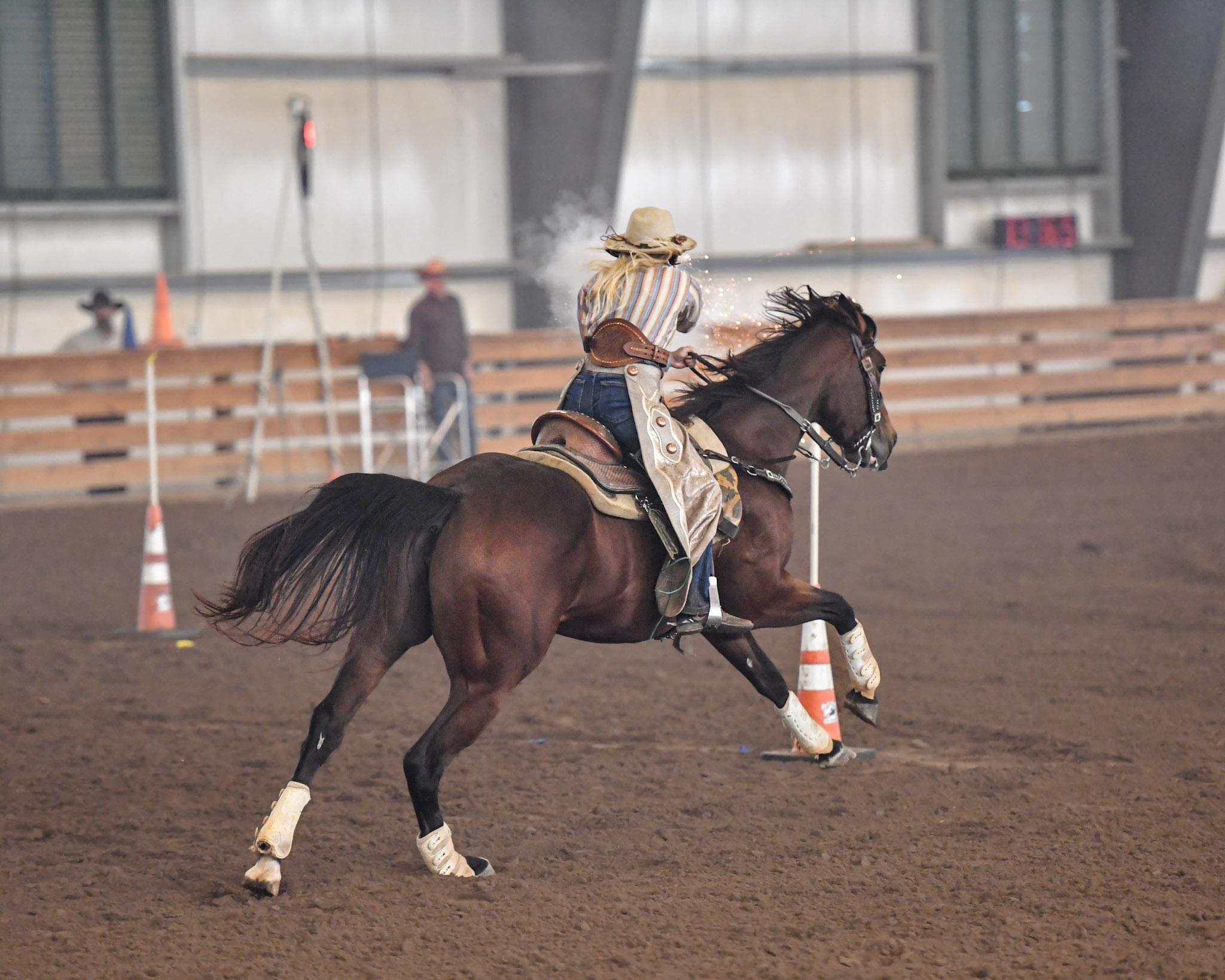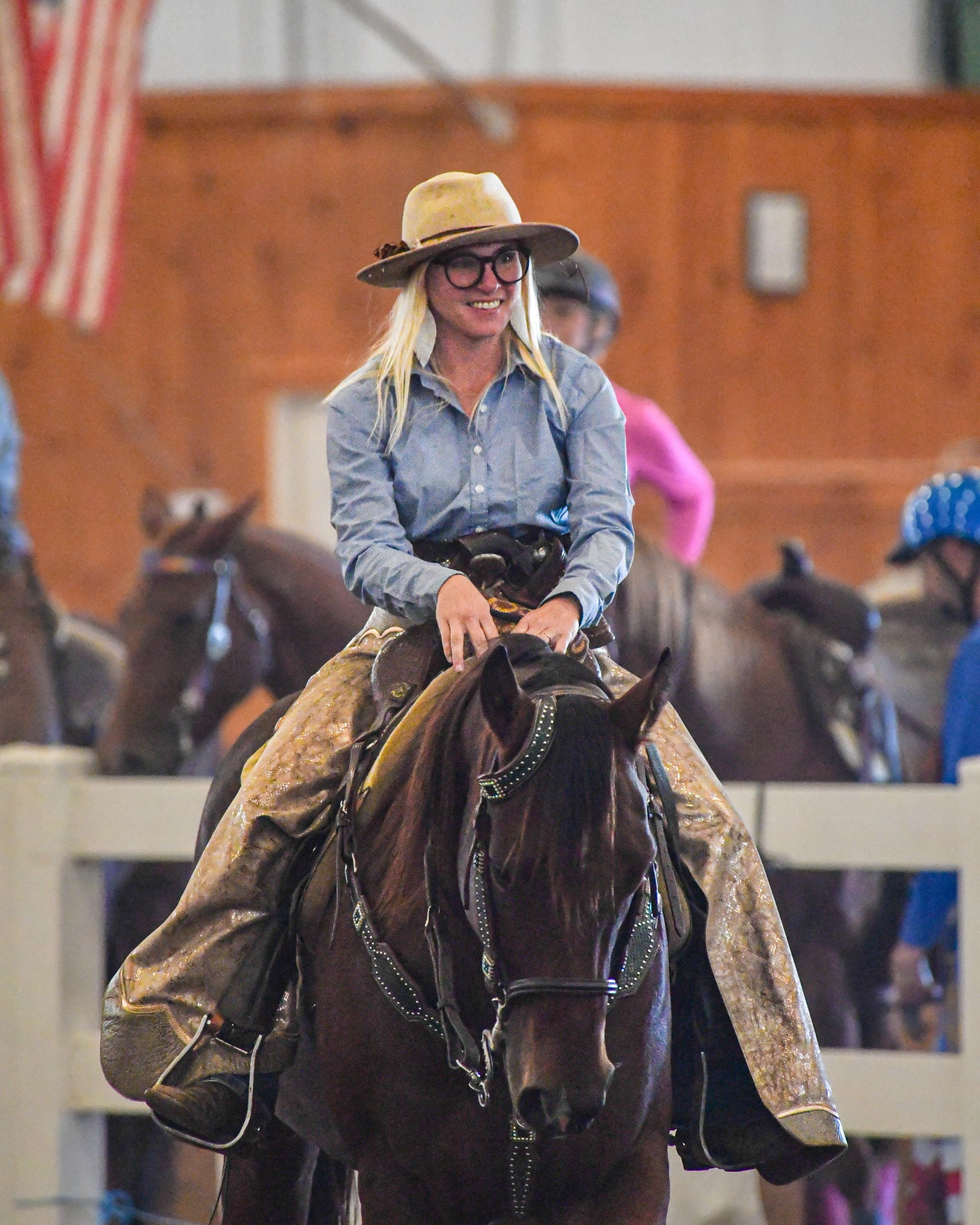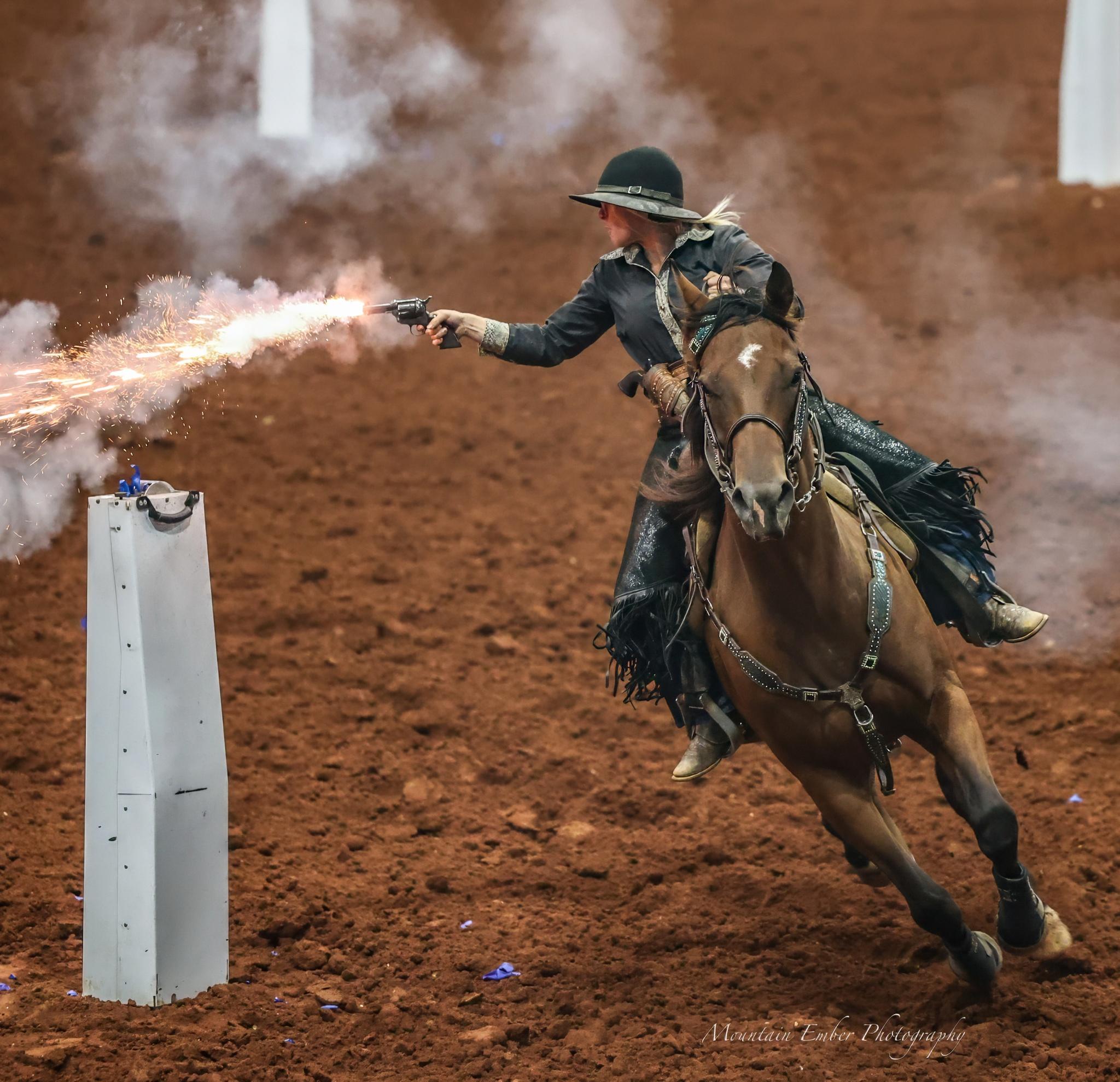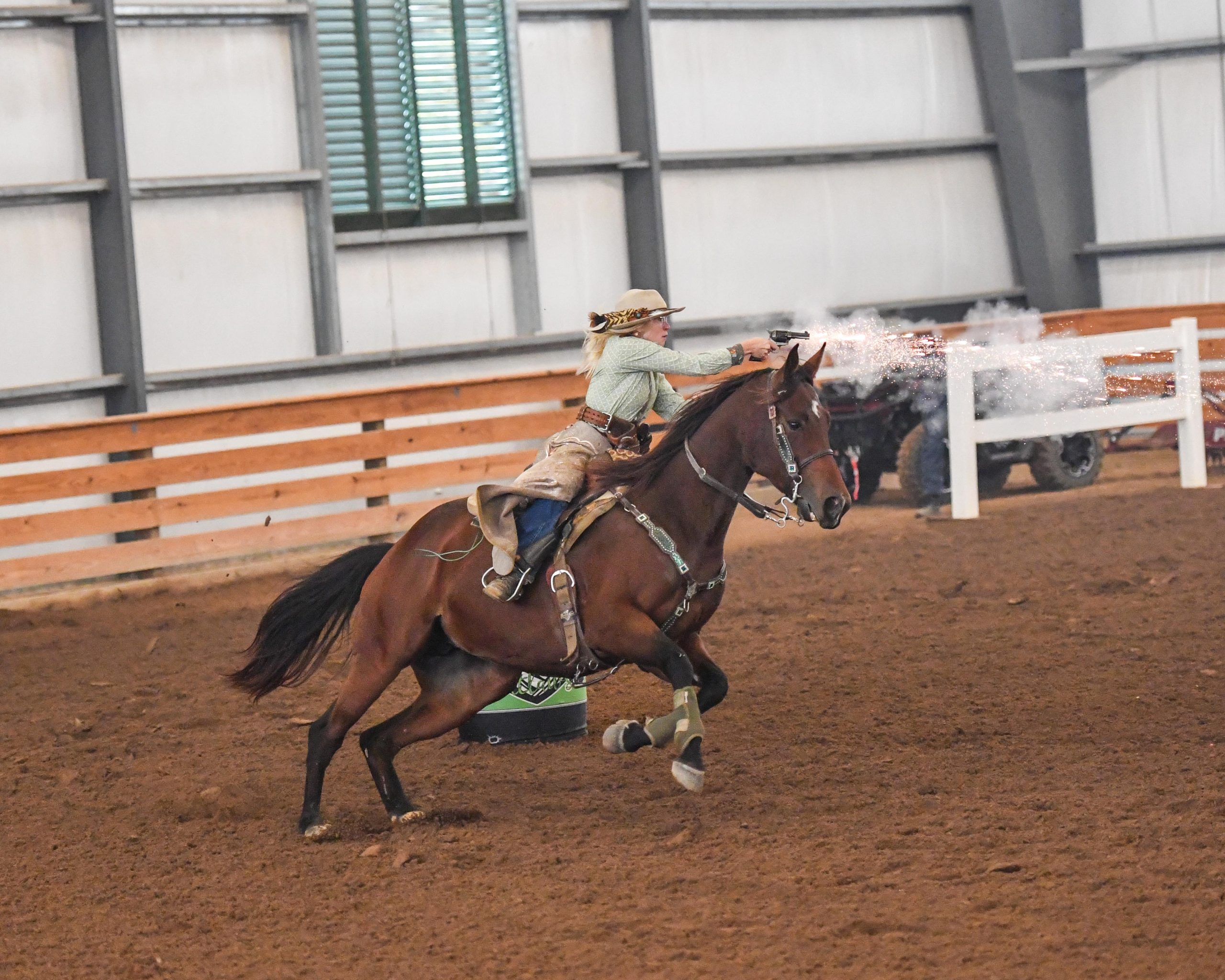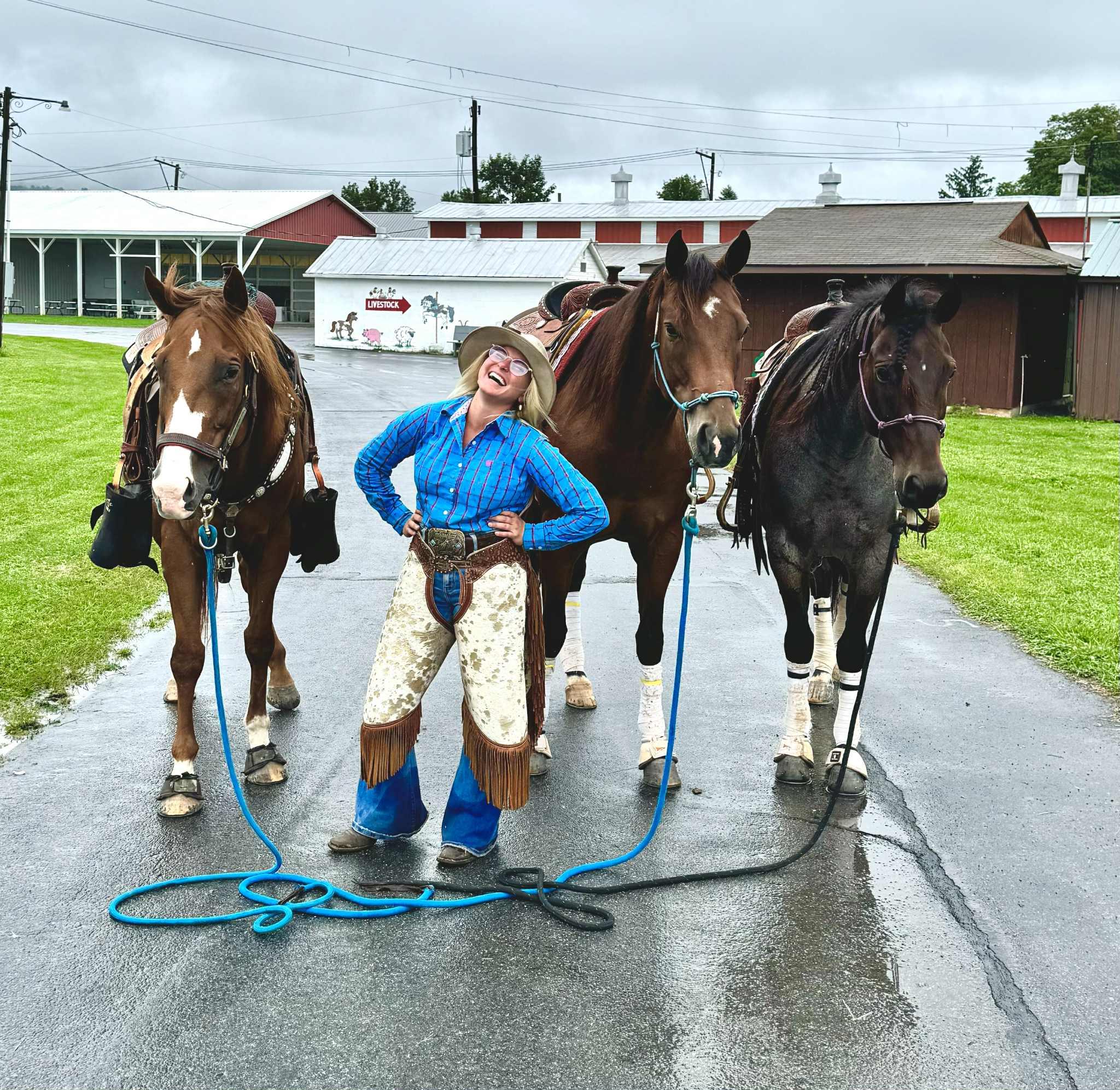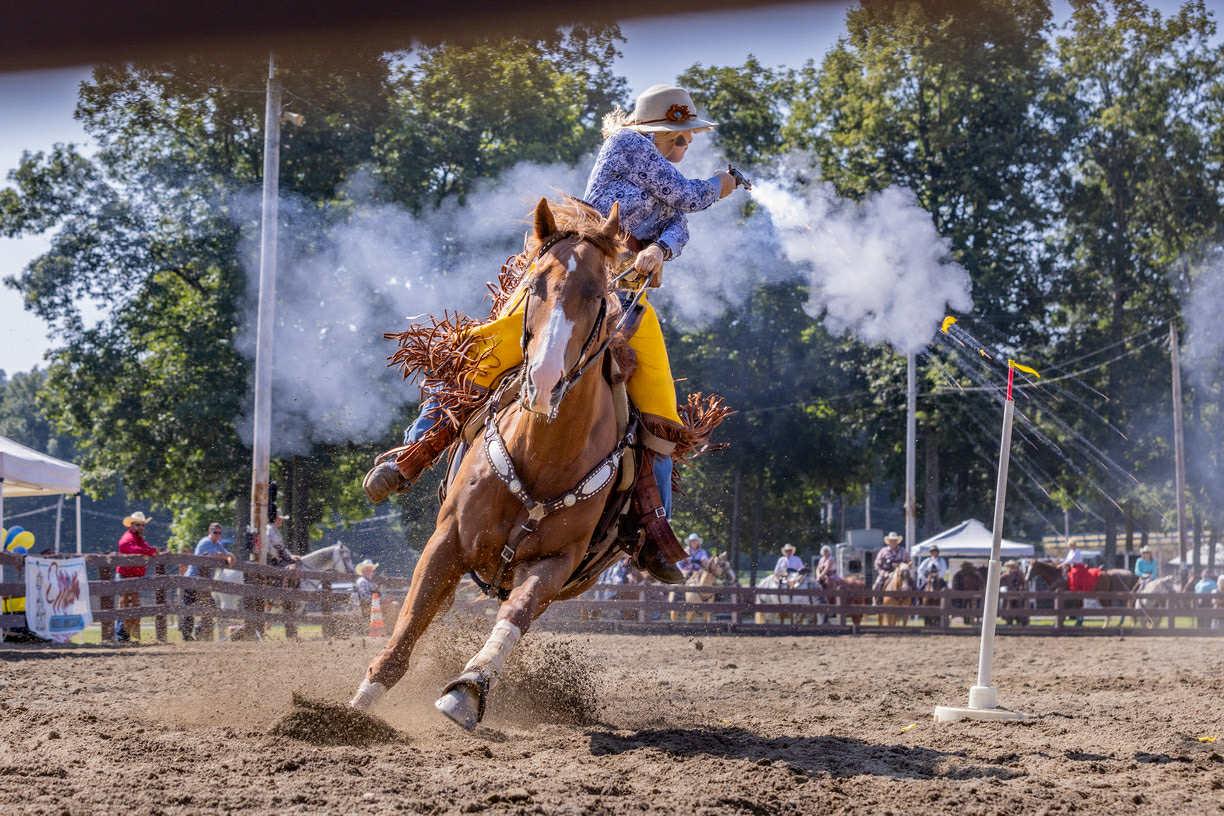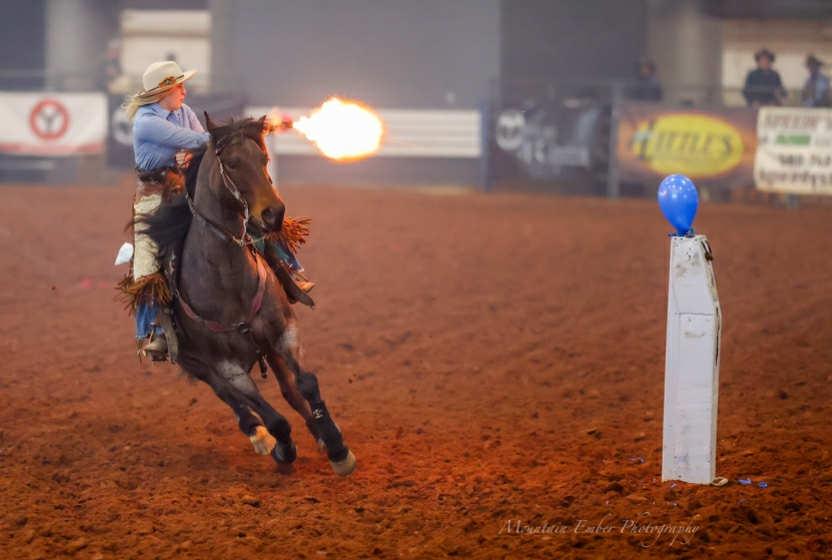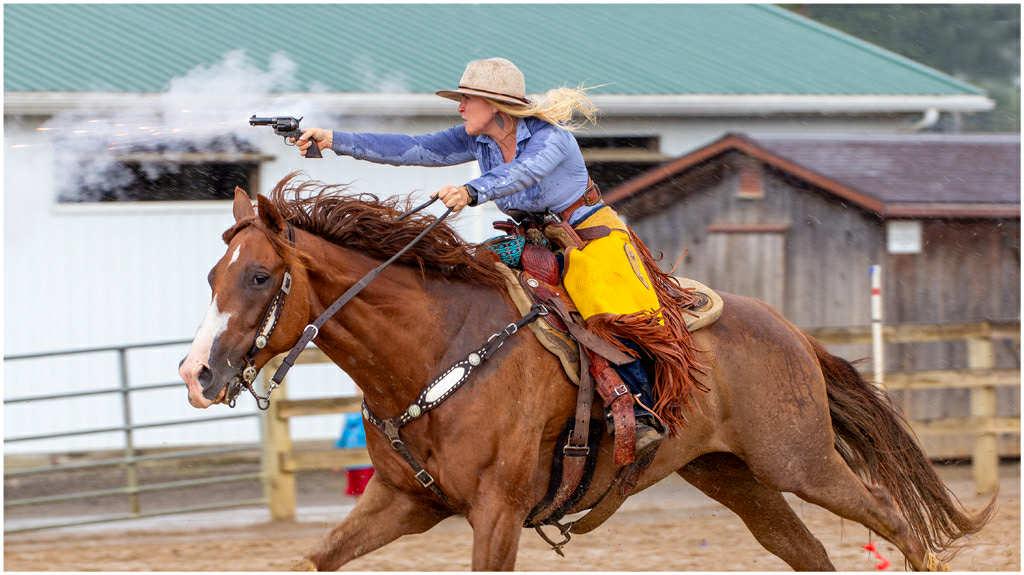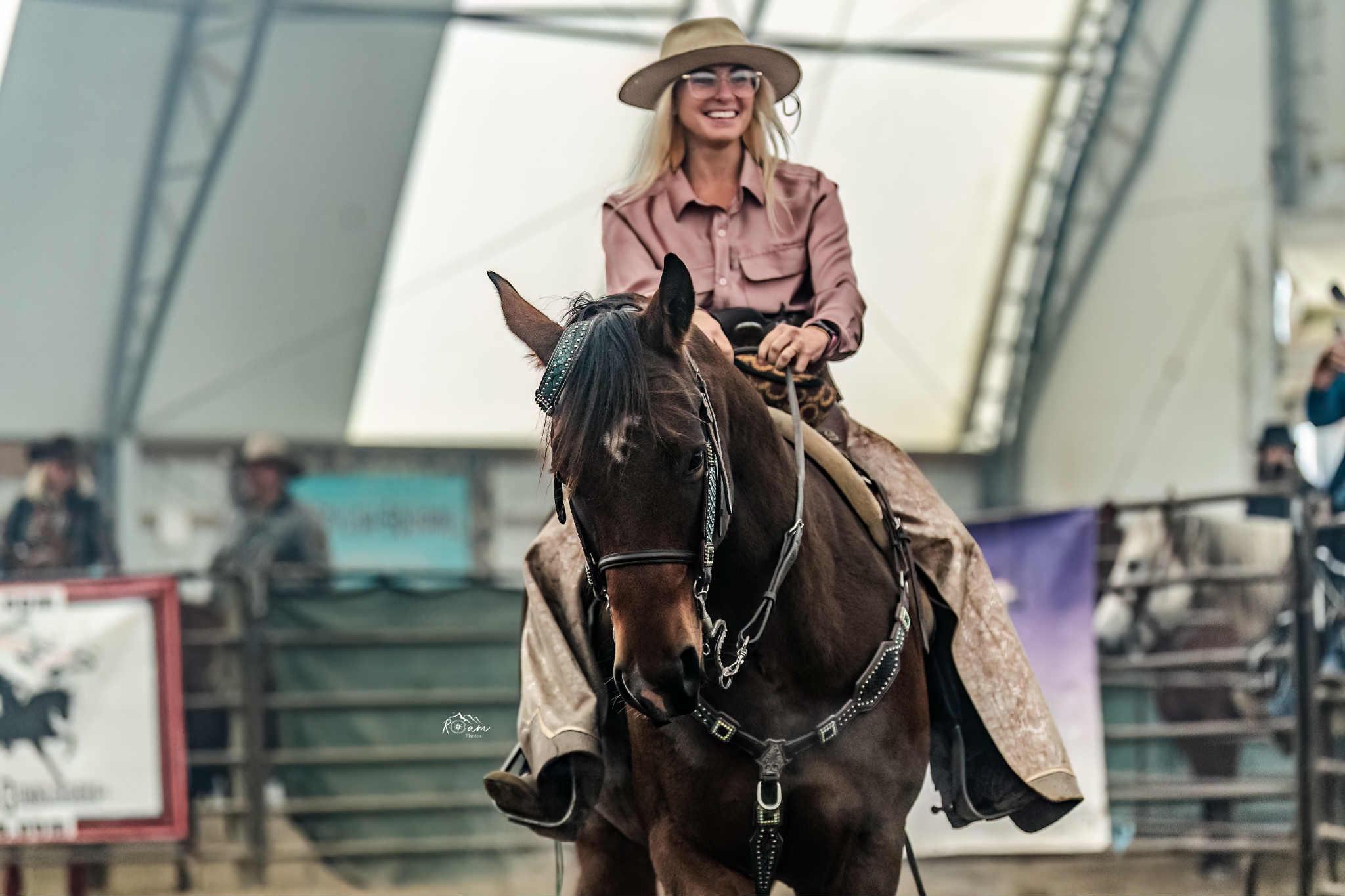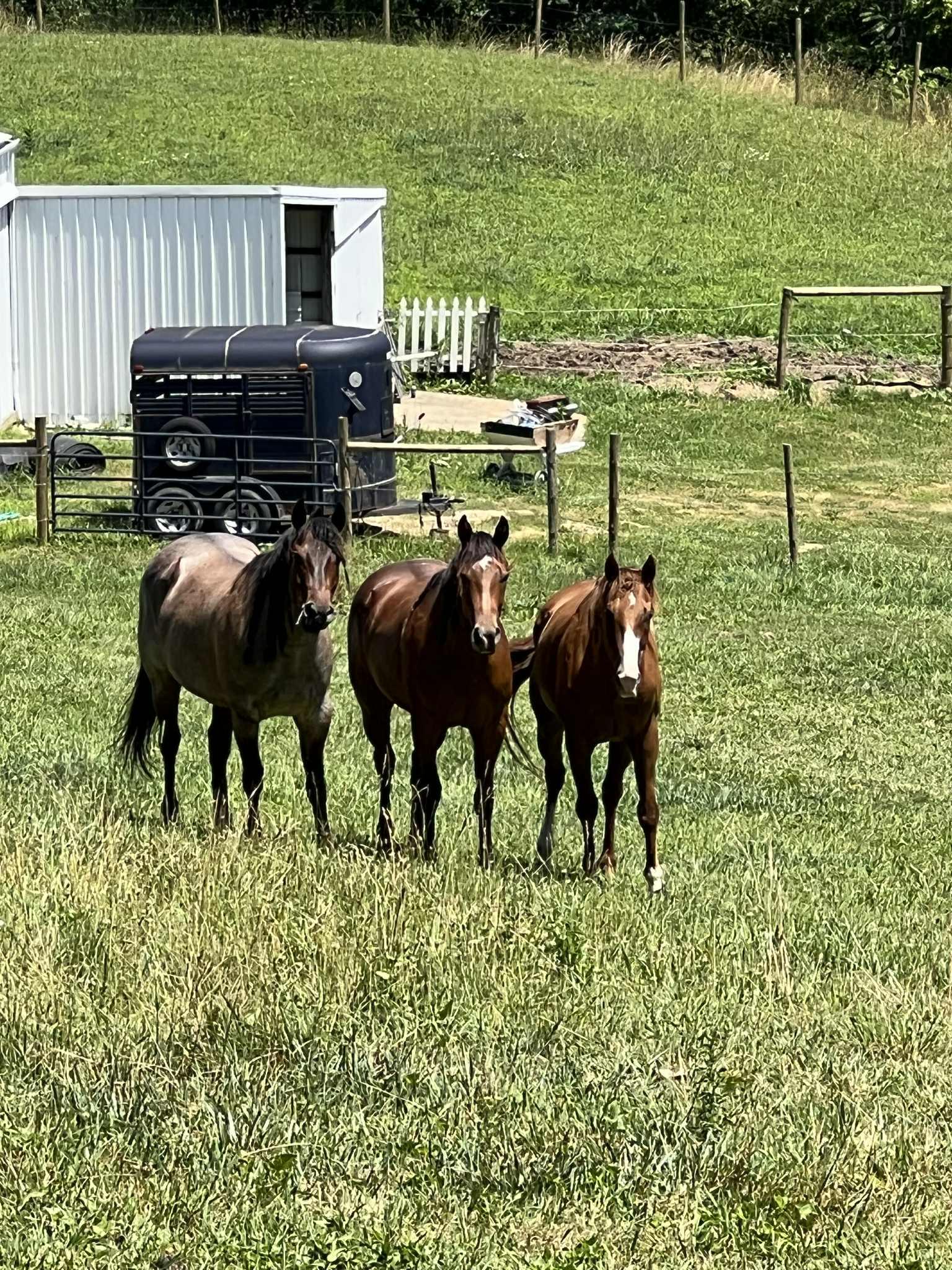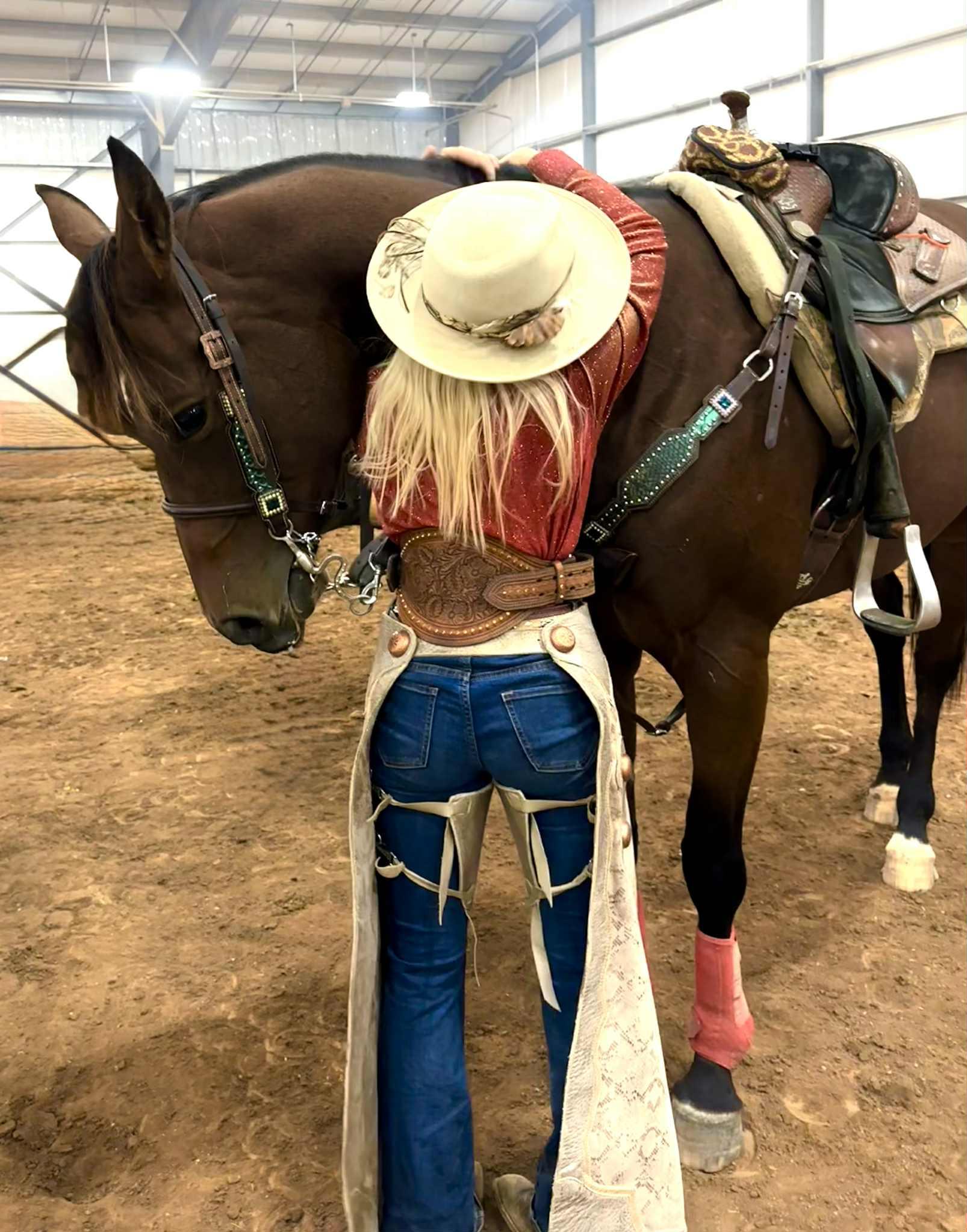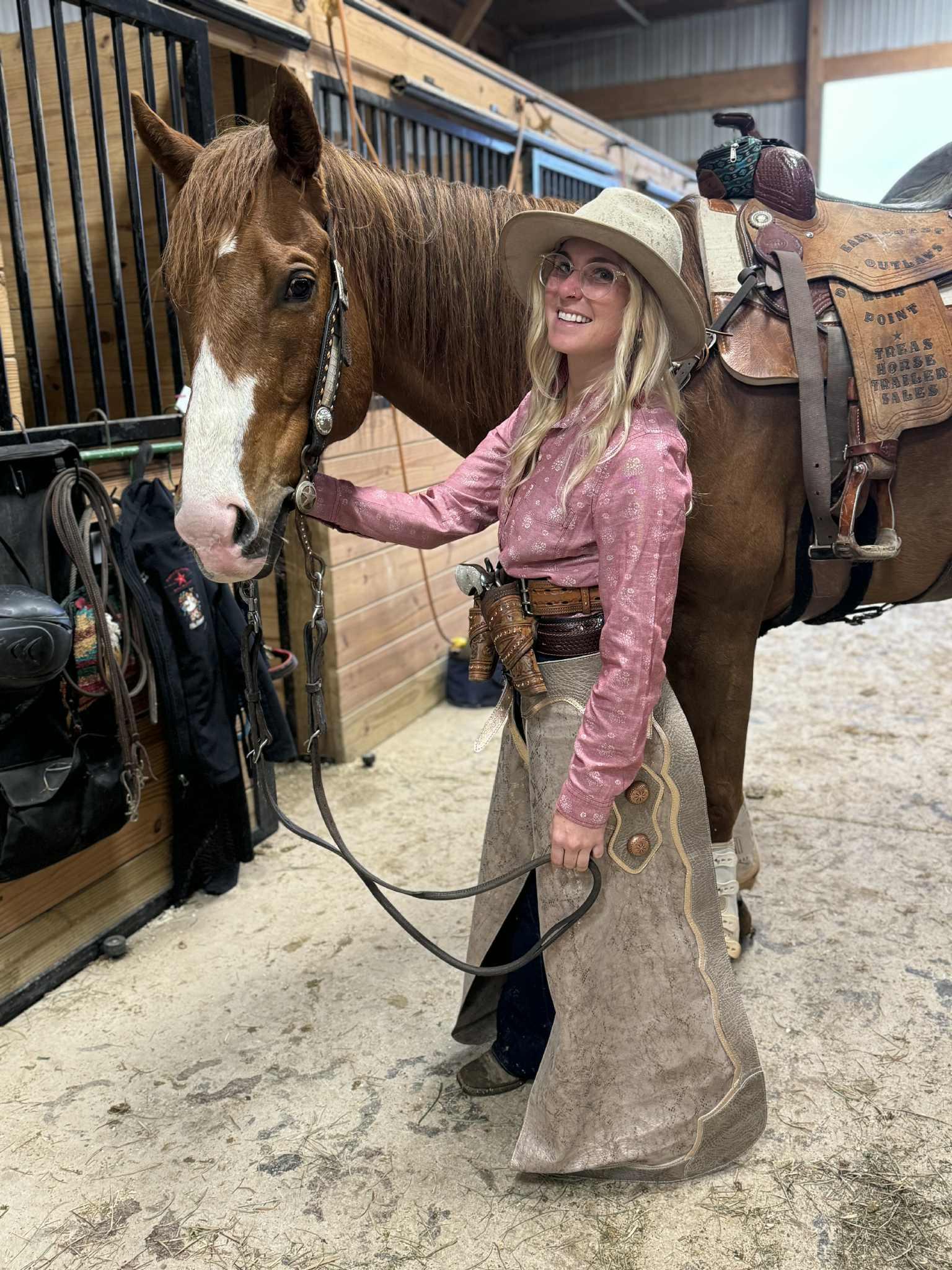HORSE NATION
horsing around the worldReader Photo Challenge: Between the Ears 20 Nov 2025, 5:06 pm
Enjoy these 10 between the ears photos!
This week we asked to see your best photo from between the ears. Here are 10 photos of exactly that!
Keep an eye out for next week’s photo challenge! We announce challenge subjects on Monday around the end of the day on both Instagram and Facebook.
The Puddle Monster Ghost Case, Part II: A Pony Detective story 20 Nov 2025, 12:51 pm
What starts as a sloppy-track spill quickly turns into a case of fog, folklore, and a missing favorite. Read on for the conclusion to the Puddle Monster Ghost Case.
By N. A. Souer

You can catch the first part of “The Puddle Monster Ghost Case” here.
An hour later, M and Mousy stood in an underground tunnel.
“What’s above?” M asked, staring upward.
“The backstretch,” an old gelding in charge of track maintenance answered.
“And what’s this for?” M asked, motioning with his nose to a long hatch-like door above their heads.
“That’s an emergency evacuation door.”
Mousy glanced back at the semi dark tunnel, which led to a maintenance building near the center of the track.
“All the valve controls for the drainage panels are back there,” the old gelding said, pointing to the distant maintenance building. “But for this door, there’s also a release on the wall.” He walked over to a large rocker switch and inspected it. “That’s strange,” he said, more to himself.
“What?” Mousy asked.
“This switch is supposed to have a plastic tie through it.”
“So you’re saying this switch has been tampered with it?” M asked.
The old gelding nodded.
“The only time this plastic cable should ever be removed is if there’s an emergency requiring this door to be opened,” he said.
“What’s that up there?” Mousy asked, pointing a paw up at one of the high-powered springs above their heads.
M and the old gelding looked up.
“Well, if the door was recently opened,” M said, “I suppose a few cobwebs got disturbed.”
Mousy didn’t respond. Instead, he kept staring upward.
“I think it’s a snag of hair,” he finally said.
M wasn’t sure, but he knew Mousy’s younger; kitty vision was sharper than his.
“Think you can get a closer look?” M asked.
Mousy nodded, then climbed a nearby ladder, and called down, “I was right! It is hair!”
“And I bet it’s from Charmie,“ M said.
“Either that,” Mousy said with a grin, “or puddle monsters get hairballs.”
***
The next morning M’s phone rang early. “Charm Bracelet’s grandmother has received a ransom note,” a voice said.
M was barely awake. He glanced out the barn door into the early darkness.
“What time is it?” he asked, vaguely recognizing old Sollie Joe’s voice.
“It’s already six,” he answered excitedly, “and she just told me during workouts.”
“Don’t handle it,” M instructed. “I’ll get someone down there to dust it for prints.”
By the time M got to the track, Mousy was already there. Not for the first time M was thankful he had a nocturnal employee on his team that operated better than he did in the early morning hours.
“We already have a match on the prints,” Mousy reported to his boss. “They belong to Little Big Hoof, a juvenile punk POA from the reservation. At least, he must have delivered the note, but I don’t think he wrote it.”
“Why? Were there any other prints?” M asked.
“Yeah, there’s one set we can’t rule out,” Mousy said. “I’d be willing to bet it’s whoever wrote the note.”
“And what are the demands?” M asked.
“Well, it’s a strange one,” Mousy explained. “The note demands mineral rights for the land the track sits on to be signed over to some bogus land development firm in exchange for Charmie’s safe return.”
It sounds like something the TB mob would do,” M said.
Mousy thought for a moment. “Yeah,'” he said “but why would they use some juvenile colt off the reservation.”
“It’s hard to say,” M said, “But I think it’s time we run the prints through the NPSS database, and see what comes up. Let me make some phone calls.”
***
Back at the barn, everyone gathered in the tack room.
“What is the latest?” M asked.
“I talked to Old Zeke Tanner,” Tweak said, “the track farrier. He said there was something odd about Charmie’s shoes.”
“What do you mean?” M asked.
“For starters, he couldn’t get them from the usual vendor and was directed by one of the sales reps to another company. The strange thing is it was a vendor he had never heard of before, and when he tried to order more supplies a week later it was like the company had never existed.”
“What does this have to do with our case?” Sasha asked. “Equine supply vendors come and go all the time.”
“Yeah, but why would someone set up a temporary company for just farrier supplies? It makes me think there was something different about Charmie’s shoes that might have to do with how she was kidnapped.”
“You might be onto something,” Mousy said, holding up a paw. He glanced at his notes. “I did some looking into this Little Big Hoof character, and besides being a punk pony, he’s also a techie whiz. It turns out the model of door hatch that we seen under the back stretch can be opened remotely by computer, as long as the plastic cable tie on the latch itself is cut.” Mousy paused and looked over at M, then added, “A techy colt like that could easily hack into the track’s maintenance computer system and do some reprograming.”
***
“That’s an Interesting theory,” M said, “but it doesn’t tell us where Charmie is.”
“Maybe it can,” Mousy said. “Remember old Sollie Joe said there had been another incident? I went out on the tracks website and looked up archive video. It was raining that day too, but unlike today it was really hot.”
“Why is that important to our case?” Tweak asked.
“Because I am starting to think the two incidents are connected, and it’s no coincidence it was foggy both days.”
“I don’t follow,” M said.
“After doing a bit of research,” Mousy explained, “I learned if a drainage system is installed incorrectly it can cause inversion fog under certain condition.”
“So, you think the drainage tiles were installed improperly?” Tweak asked.
“Yes, but on purpose. I also suspect the first incident was some kind of practice run.”
“But what would that have to do with Charmie’s shoes?” Sasha asked.
“The shoes don’t have anything to do with the drainage system,” Mousy said, “but there could be some kind of a device implanted in them that emits a frequency to suddenly release the evacuation door we seen in the tunnel under the back stretch.”
***
M smiled a big, pony grin, then said, “And that would look like Charmie was swallowed by the great puddle monster in the mud.”
“You got it,” Mousy said.
“But if the door was opened,” Tweak asked, “why didn’t any of the others fall down in the tunnel?”
“The door has extremely high powered, pneumatic springs and can be both opened and closed almost instantaneously. Whoever planned this out must have studied Charmie’s running style and knew she’d lead on the back stretch.”
“Why didn’t any of the other horses see this?” M asked.
“Zina Lite did,” Mousy said. “She seen Charmie go down, but by the time she got to the same spot the door was closed.
“Why didn’t anyone hear it?” Tweak asked.
“I can only speculate, but I would guess with all the fog, mud, and panic, no one heard the air springs discharge a second time.”
“This still doesn’t tell us where Charmie is,” Sasha said.
“If we can figure out the frequency used to open the evacuation door, it might lead us to Charmie.”
“What I don’t understand is why Charmie was singled out,” Tweak said, as M’s phone began to ring back in his stall.
“I wondered about that too,” Mama Kitty said. “So I did some digging into her family history.” Mama Kitty paused and glanced at her notes. “Did you know Charmie’s grandfather was one of the founding owners of the track? Now that he has passed, his will states she will inherit his voting rights on the board of directors.”
***
“They’ve matched the second set of prints,” M announced, coming back from his stall. “The NPSS database shows it’s someone called Vignetti, a small time thug from the TB mob. From his criminal history I doubt he’s too high up in the organization. Fortunately for us, he’s been under surveillance for the past several months.”
“I don’t get it,” Mosey said. “Why is NPSS involved? “
“Apparently this guy has a whole list of charges against him,” M went on. “Things like betting and investment scams at tracks all over the country. NPSS agents have already picked him up and they’re sweating him out.”
“How long before he tells us what he did with Charmie?” Tweak asked.
“That’s a problem,” M said. “The guy lawyered up right away and he’s not talking.”
“So how do you know what he’s charged with?” Sasha asked.
“An old buddy that’s still in the service worked the case,” M explained. “It turns out Little Big Hoof was the foreman for the excavation crew Vignetti arranged to install the drainage system. The plan was to submit a bogus soil test report to the board of directors, which indicated the presence of large amounts of rare earth minerals.”
“What do earth minerals have to do with drainage?” Tweak asked.
“It sounds like they were using a fake report to convince the board of directors the land the track sits on is more valuable than the track itself,” Mousy said.
“Right,” M said, “only they never planned on discovering skeletal remains. When the Appaloosa Horse Council voted to relocate the remains, Little Big Hoof got an idea. Being from the reservation, he knew the generational folklore about the Great Puddle Monster Spirit. So he and Vignetti simply made up a modernized version to cover the kidnapping of a founding track owner’s granddaughter in order to blackmail away the land.”
“Okay,” Sasha said, “it’s starting to make sense. But we still don’t know where Charmie is.”
M turned to Mousy. “Think you can find her?” he asked. “After this long without food and water she might be in tough shape.”
“As long as she still has her shoes on,” Mousy said, “I think so.”
***
Hours later, Tweak and Mousy were searching the tunnel under the backstretch with a frequency detection device.
“What makes you so sure Charmie is here?” Tweak asked.
“We’ve searched everywhere else,” Mousy said, staring down at the gadget in his paws. “I’m starting to get a reading on this thing.”
“How do we know if it’s detecting Charmie?” Tweak asked.
“We don’t, but if she still has the bar shoes on we will find her. Otherwise,“ Mousy paused, not wanting to finish his sentence out loud, “we will only find the shoes without Charmie.”
Suddenly the gadget in Mousy’s paws began to buzz. “It’s reading a strong, nearby frequency.”
“Meaning? Tweak pressed.
“We are close to something,” Mousy said. “What’s back there?” Mousy asked, motioning further back in the dark recces of the tunnel.
Tweak cautiously trotted ahead and took a look with his halter head lamp. “It looks like where they store a bunch of old maintenance and barn stuff”.
“Tweak?” a weak voice whispered from somewhere nearby. “Is that you? “
“Charmie? Where are you?”
“Over here, the voice whispered, “in the corner.”
Mousy and Tweak worked their way through the piles of ladders, leftover construction debris, and miscellaneous barn junk. In the dark corner they found Charmie, in a makeshift pen, tied to the wall with a gag-bit, and shackled with hobble chains on all four legs.
Tweak heard Charmie begin to cry softly, fearful and exhausted tears.
“I thought no one would ever find me,” she sobbed, barely audible.
“It’s okay,” Tweak said to his friend. “We’re going to get you out of here.”
Behind him, Tweak heard Mousy on his cell phone, reporting to M.
“She is scared, weak, and probably dehydrated,” Mousy said, “but she’s alive.”
***
Two months later, the whole team from the M&T Pony Detective Agency cheered from the rail.
Overhead, the announcer’s voice called out from the loudspeaker.
“At the far turn, Charm Bracelet has broken away from the pack. Down the home stretch, it is Charm Bracelet at the wire. Charm Bracelet has won the Charmed Life Memorial Charity Stakes race.”
Sollie Joe looked down at M.
“Wow!” he said in excitement, “That little filly has heart! What a race!”
“She is amazing,” M said.
“She’s awesome!” Sasha added. “And, she still plans to donate her winnings for colic research.” Sasha turned to Sollie Joe. “Thank you for hosting a second charity race this year.”
Sollie Joe smiled.
“Well, I was only a small part of the decision,” he said. “The board of directors felt it was fitting to host a second race in memory of Sir Charmed Life. And,” Sollie Joe added, motioning to Charmie trotting over to the winner’s circle, “it’s even more fitting his granddaughter is our first winner. “ Sollie Joe looked back at M and said, “I predict big things for that little red filly. Really big things!”
N.A Souer (Nancy) got talked into submitting the first Pony Detective story by her miniature horse, M&M, who fancies himself a writer. When Nancy explained to M that no one would believe a miniature horse could write, he told her if she did not submit his stories under her name he’d dump her out of the cart on the next trail drive. LOL M (and Nancy) live in the south-metro area of MLPS-St. Paul. Although semi-retired now at age 26, when he is not writing M enjoys an occasional trail drive, but mostly these days he takes Nancy out on walks because the “people vet” told him he should exercise her more.
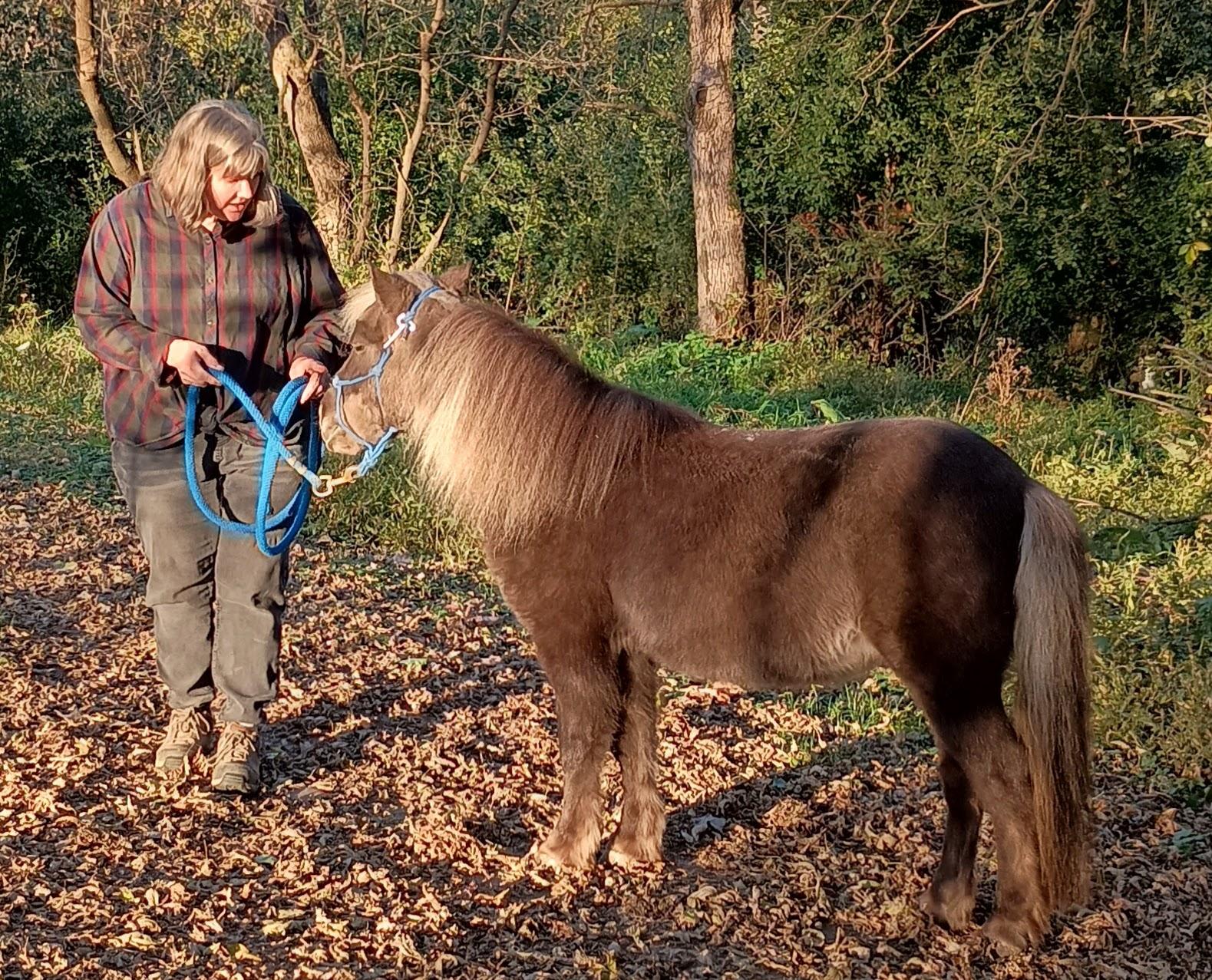
The real M. Photo by N.A. Souer.
Thursday Video: Conveniently Lame 20 Nov 2025, 9:36 am
We’ve all seen our horses pull this stunt, have we not?
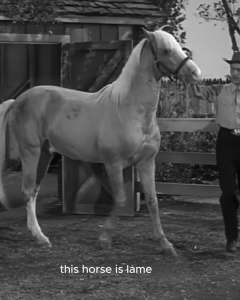
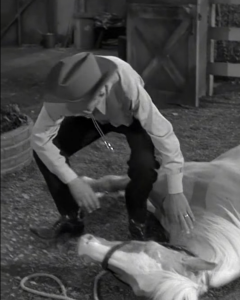
If horses are good at anything (besides destroying blankets, detecting the faintest crinkle of a peppermint wrapper from three counties away, and spooking at spots of sunlight), it’s strategic lameness. You know the drill:
Two days before the big show? Head-bobbing like a metronome.
Pre-purchase exam tomorrow? Suddenly the trot looks like it’s powered by square wheels.
The farrier finally has an opening? Congratulations, you now own a three-legged giraffe.
Call it intuition, call it emotional intelligence, call it a finely tuned understanding of veterinary bill timing—whatever it is, horses always seem to pick exactly the wrong (or right?) moment to go mysteriously, miraculously off.
And today’s Exhibit A in Convenient Equine Lameness: Mr. Ed, the palomino icon himself. When a potential buyer shows up and starts listing off things to look for, Ed is mysteriously lame. And when the buyer seems convinced the horse is fine and insists that a really sick horse would show more symptoms —stiffness, head down, lying down — Ed suddenly develops every symptom in real time like he’s reading from the world’s most dramatic vet textbook.
Thankfully, in this case, Ed avoids an unwanted sale. But in our lives? Good old Spirit is just ensuring we don’t manage to make it to the next event. Sigh… 
Enjoy this masterclass in equine theatrics. If your own horse ever pretends to be lame for convenience, just remember: Mr. Ed walked so they could limp.
Happy Thursday, Horse Nation. May your horses stay sound and your sanity remain intact. Go riding!
Thoroughbred Logic: Aboard a Dragon? Ride Into the Bend 19 Nov 2025, 9:31 am
Presented by Kentucky Performance Products.
Welcome to the next installment of Thoroughbred Logic. In this weekly series, Anthropologist and trainer Aubrey Graham, of Kivu Sport Horses, offers insight and training experience when it comes to working with Thoroughbreds (although much will apply to all breeds). This week ride along as Aubrey shares her logic on setting the usefulness of keeping a fresh OTTB slightly bent.
This weekend, I had the pleasure of escaping the sleet and snow and heading south for a clinic. Can’t beat sunny and 75 and seeing old friends. Beyond the weather and company, clinics provide handy insight and inspiration for these articles. For this clinic, the trends were “Go FORWARD!” (yelled affectionately but loudly) and “ride into the bend.”
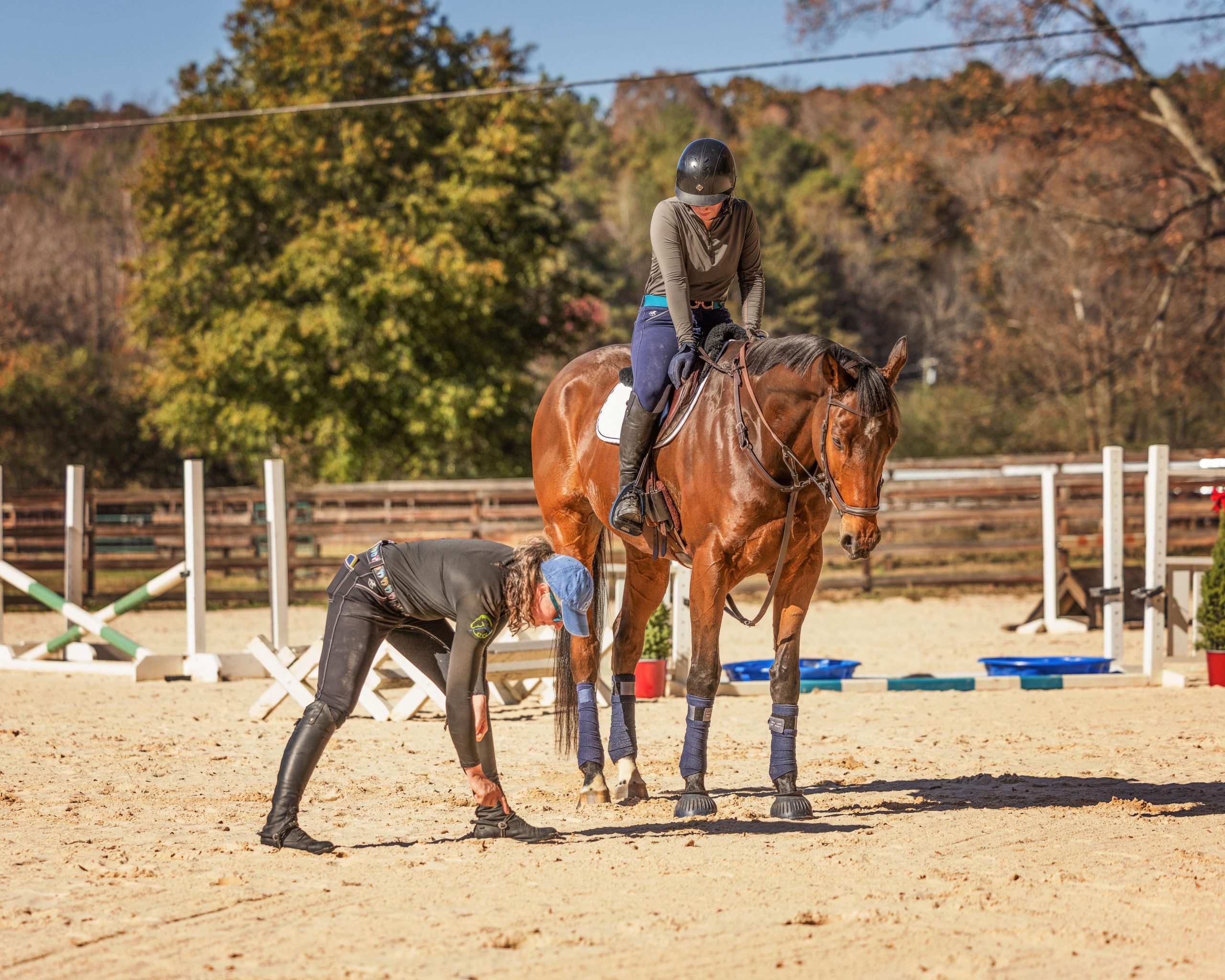
Explaining why forward works with diagrams at the recent Kivu Clinic at Simmons Sporthorses. Photo of Adela Narovich astride Beau (Hyperbolist) by Dawn Light Photography.
The first is no surprise — getting horses out in front of your leg is about the best thing that can happen to them and you, even if you have to really kick on and get going for a minute to be able to do it. OK great, but I have talked about that here.
The second is a critical piece of being able to ride the horse, regardless of their mood, “enthusiasm,” and level of dragon. The idea is that riding straight is not always your friend. When shenanigans abound, one of the key ways that I manage to keep a horse together, work through whatever they’re feeling, and get back to what we were trying to do, is to keep them slightly bent. This works even on the greenest of off-track Thoroughbred to the most seasoned packer.
So…
- It wants to bolt through its chest? Deepen the bend and go forward.
- It wants to stand up and show off its Black Stallion impression. Deepen the bend and go forward.
- It wants to see how successfully you lawn dart over its head in a fun little bucking spree. Deepen the bend and go forward.
- It wants to get super spooky in a corner that it has seen every day for the last year. Deepen the bend and go forward.
- It is not sure which way it is going to unzip and come out of its skin in the warmup. Deepen the bend and go forward.

Putting a first ride at home on this talented filly required a bit of bend to get everyone to settle and relax (Photo of Funnystastic by Lily Drew).
Riding in a bend and/or deepening that bend seems to universally increase a rider’s ability to not just manage — but get beyond — the chaos. The concept relies on the notion that when they are gently bent, the horse is far less capable of overriding the rider and the situation. And as such, the rider is able to be more confident and overall softer and less reactive, when they simply set a gentle bend, kick on, and (try to) relax.
To rear, buck, bolt, or spook at their most effective volume, a horse needs to be straight. When straight, they can lock their jaw, lock their neck-to-shoulder, and get above the bit to take off — or pull below it to play bronco. Either way, when straight, all stars and body points align to let them put their whole body to use however they see fit, regardless of the human on their back.
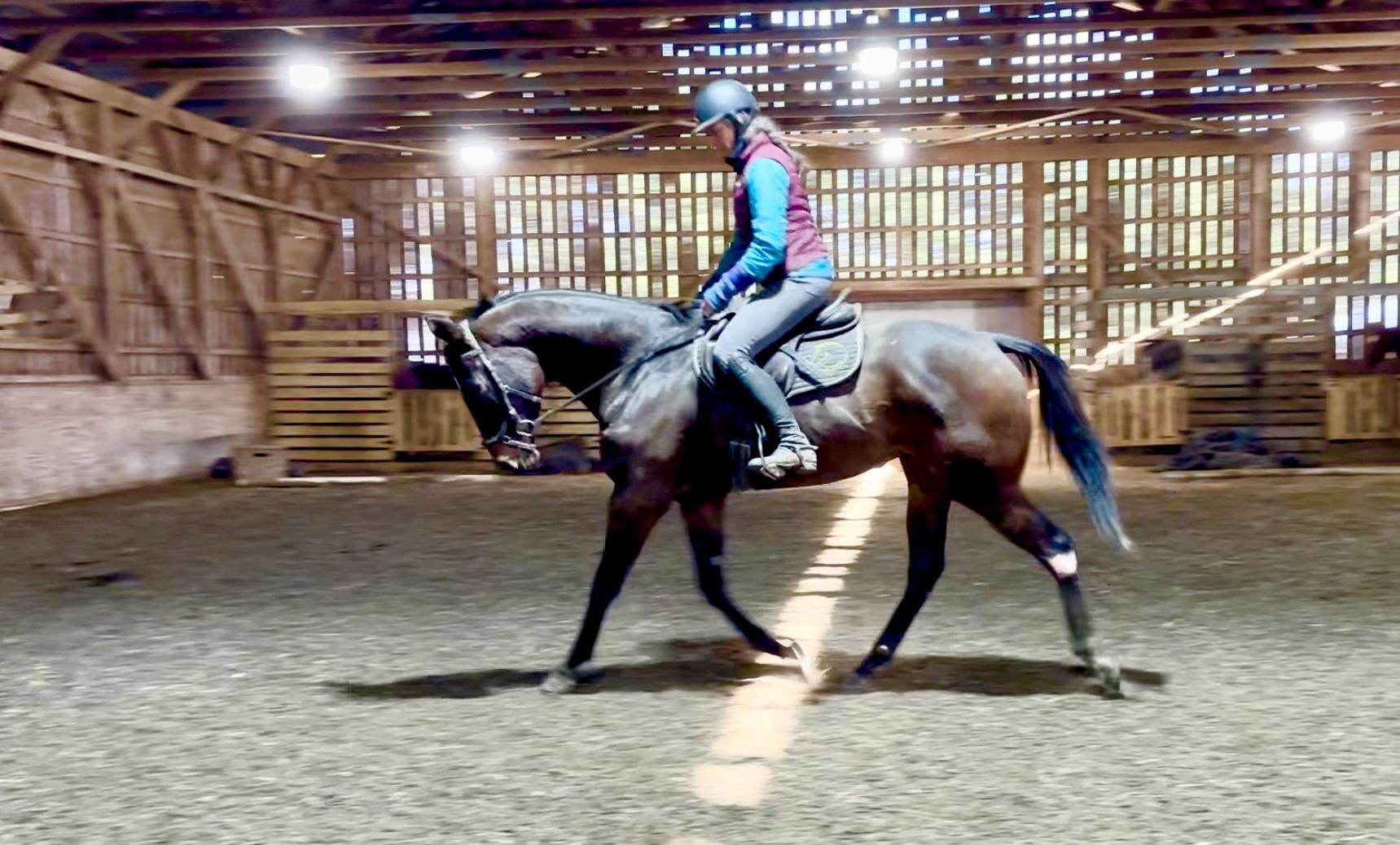
In three rides, this filly has figured it out and is ablate stay round and soft without such a deep bend. Photo by Lily Drew.
The act of setting/deepening the bend to nix those antics is annoyingly simple:
- Keeping a light bend sets you up to ride confidently and have the tools to knock out shenanigans without getting thrown (literally and figuratively) by them.
- Open the outside rein (with contact) to make space for their shoulder to move over.
- Increase inside leg pressure.
- Use the inside rein (heading towards the outside of your inside hip, NOT the wither) to bring the nose and neck in and wrap the horse around your inside leg. Their ribs must move away from your inside leg or it isn’t a bend and this won’t work.
This effectively is a more pronounced version of inside leg to outside rein with a bit of inside rein to help shape and deepen the bend as needed. As you’re doing this, keep kicking on and going forward. The more they stay in front of your leg, the better everything goes. Large circles are the easiest to work with while you get them to steady into the outside rein and everyone gets to take a breath.
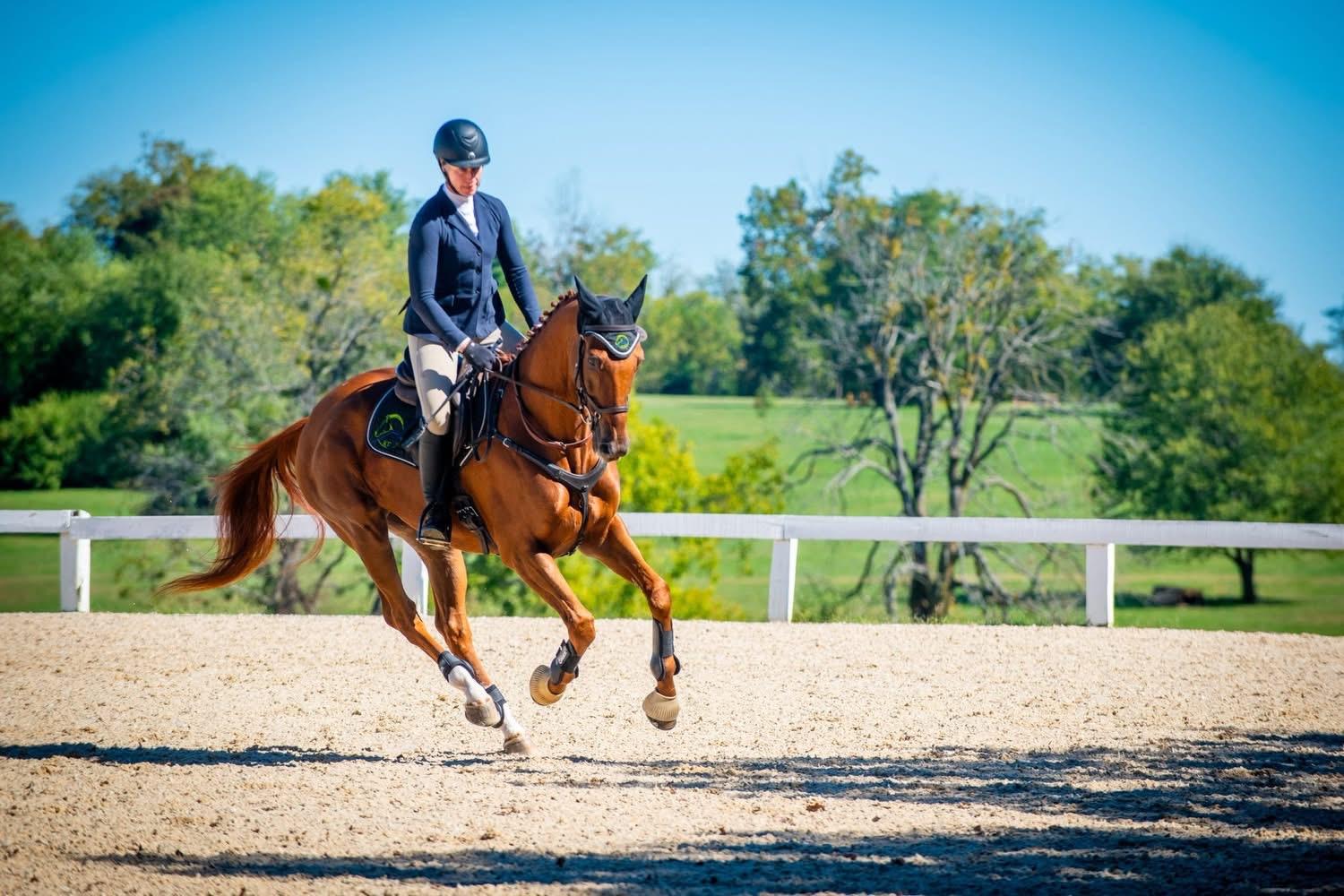
Artie (Reunion Tour) packing in a powerful canter before a jump round at this year’s RRP Makeover. The bend keeps him over that outside hind and enables me to make riding in a busy warmup arena less stressful. Photo by Lauren Kingerly.
Increasing the bend just a bit when the wind starts howling or the snow might just slide off the roof at any moment helps prevent a literal straight-forward disaster. But more than prevention, it asks your horse to keep going, move their feet and put their body in a shape that feels pretty darn OK.
So they move off the inside leg and balance on the outside hind. They stay soft and supple despite a potential pulse-raising environment. And they go forward and keep all four legs respectively near the ground. And when they take that “NOPE” breath and try to blast through you, you simply keep hands low, add a little more of all of the aids already in play to deepen the bend, and then immediately soften and carry on like nothing happened.
When we ride dragons like this, it creates a positive feedback loop. On one hand, it takes only a couple times around before they figure out that they’re not going to rattle the rider so the behavior dims. On the other, with a softer, more confident rider in the irons, they gain the confidence (and no longer feel like they need to send you lawn darting and get the hell out of Dodge). And there is nothing rough or untoward here — just a steady bend that helps them keep moving their feet where you want them and not lifting into airs above ground.
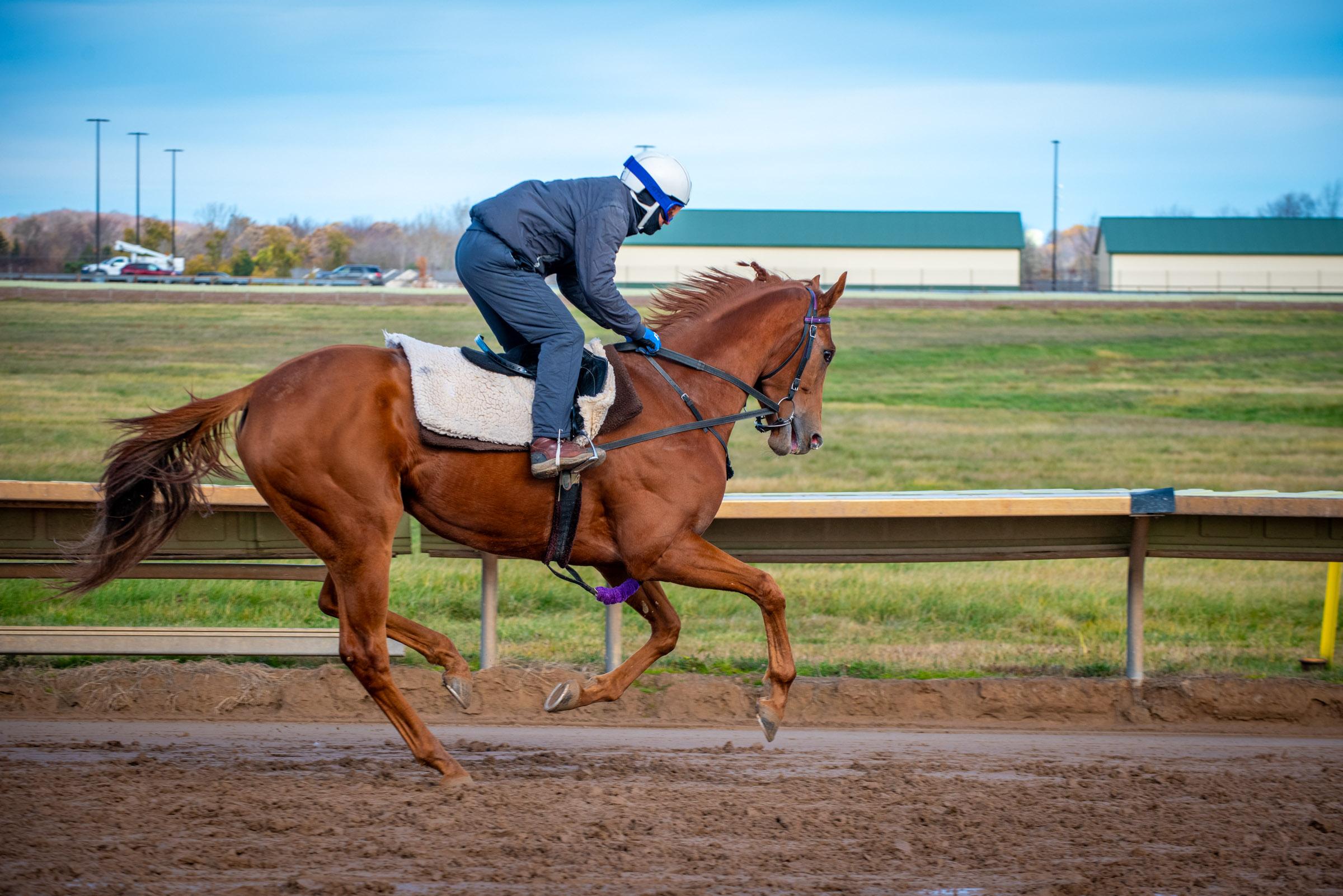
Bend (of sorts) is also used at the track to keep control of the more powerful runners during workouts. JC Good As He Gets is also in draw reins, which for better or worse nonetheless cuts down on the ability to bolt. Photo by author.
A couple of extra hints:
- Having a particularly wild or bouncy ride? Grab a little mane with the outside rein to stabilize it, sit up and kick on. Keeping hands low near the neck helps stabilize the rider and maintain balance when the ride gets jolty.
- The outside rein and inside leg must come first — never grab the inside rein and spin them into a tiny circle at speed. This throws them off balance, undermines their confidence in the rider and can simply be dangerous for horse and human.
- If it doesn’t feel like it’s working, check to make sure the outside rein holds more tension than the inside. Make sure it is steadying back towards your hip, not following forward around the shoulder (I call that “bicycling”). You almost want to feel like you’re setting them up to counter bend from the outside rein, then add inside leg move them over, and then finesse the inside rein to hold and or deepen the bend.
- Make sure the inside rein creates bend, not flexion. Bend involves the whole body which will in this case be the thing that keeps you safe. Flexion involves the tilt of the poll and the TMJ area on a horse — it does not bend their body or move their shoulder or ribs. If your inside hand crosses the neck or pulls to the wither… or if your inside wrist folds over with your knuckles facing their neck, you’re asking for flexion. Because it does not reach through their whole body, getting flexion in the stead of bend means you might not be safe from any of the above antic
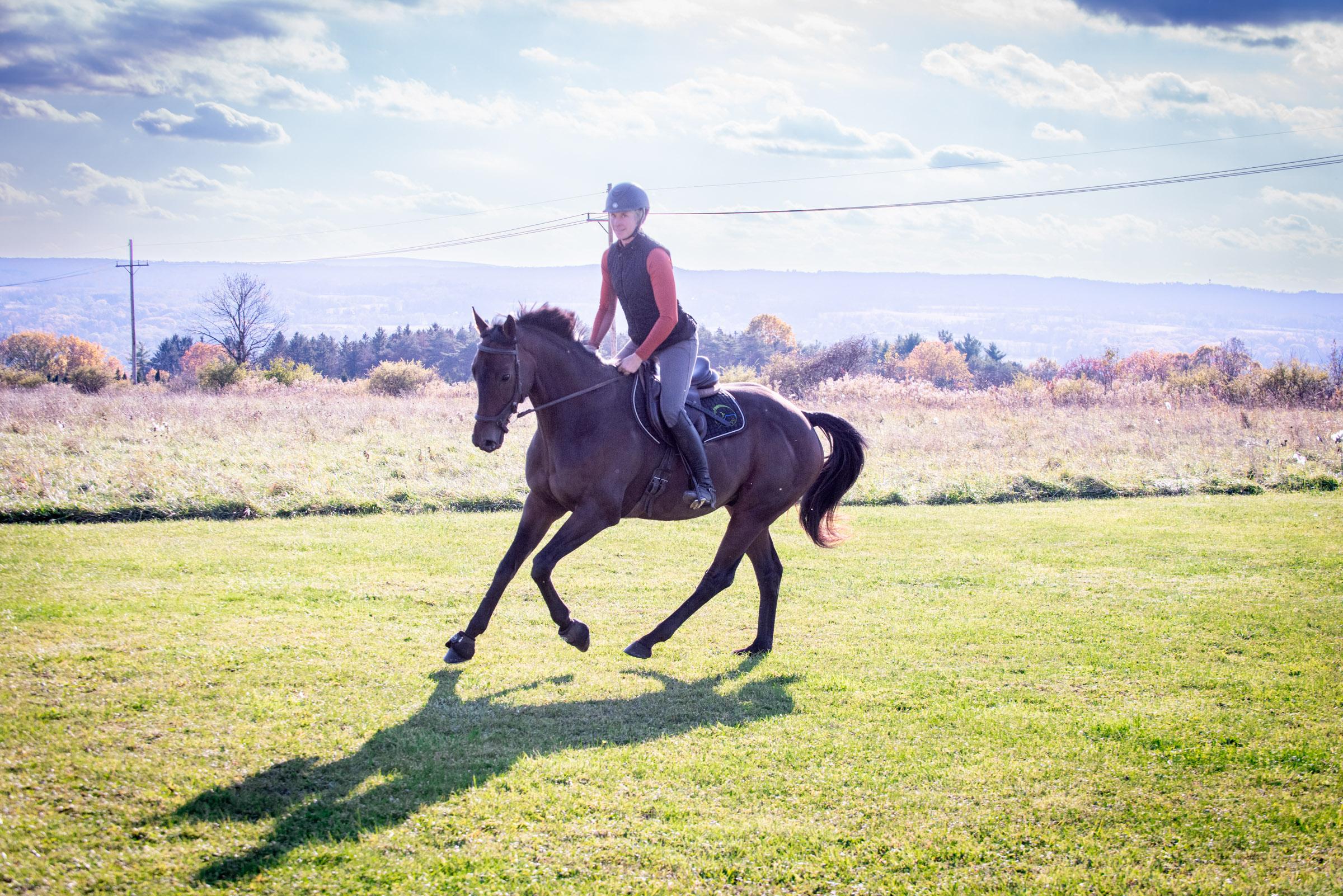
When the bend tactic allows you to create the positive feedback loop, it’s no problem to ride forward and play with power and speed. Iago (Camino De Santiago) my potential 2026 Makeover entry enjoys showing off that freedom outside. Photo by Lily Drew.
So go ride folks. As the air gets crisper and Thoroughbreds of all ages remember their days of breaking out of the start gate, sit up, stay confident and ride the bend as much as you need to to craft a positive cycle of trust and confidence. Get it right and you might actually have fun learning to fly your dragon.
About Kentucky Performance Products, LLC:
Is your horse suffering from digestive tract issues, such as diarrhea, colic or hindgut imbalances? Does he need a high-grain diet? Is he under stress? Neigh-Lox® ADVANCED can help.
Neigh-Lox ADVANCED is a scientifically formulated blend of ingredients that works synergistically to maintain a healthy stomach, small intestine, and hindgut. It contains long-acting gastric buffers and coating agents to maintain a normal stomach pH. It provides an effective probiotic to support complete digestion of starch and sugars in the foregut, helping maintain a healthy hindgut. And it supplies broad-spectrum prebiotics to sustain a healthy balance of beneficial microbes and well-balanced microbiome.
The horse that matters to you matters to us®. KPPusa.com
The Idea of Order: ‘Tis the Season… 19 Nov 2025, 9:00 am
For cookies … and maybe cognitive dissonance.
Presented by:




EHV-1 Outbreak Linked to Texas WPRA Event Prompts Multi-State Biosecurity Measures 19 Nov 2025, 8:23 am
Inside the EHV crisis: how one event sparked a nationwide warning.
An Equine Herpesvirus-1 (EHV-1) outbreak, including several cases showing neurological involvement, has been traced to a major WPRA event in Waco, Texas, prompting urgent action from state animal health officials, veterinarians, and event organizers. The multi-day competition, held in early November, drew horses from across the region. Since the event concluded, multiple horses have tested positive for EHV-1, and several have developed the more severe form known as Equine Herpes Myeloencephalopathy (EHM).
The Texas Animal Health Commission (TAHC) is leading the epidemiological investigation, coordinating with private veterinarians and the management of the event facility. Although the total number of exposures is still being evaluated, officials have confirmed that several horses showing clinical signs were present at the event, making it a primary point of transmission. More cases have been confirmed in As the virus does not infect humans, no human health concerns have been reported, but consequences for the equine community are significant.
EHV-1 is a highly contagious virus that circulates widely in the horse population, but certain strains can cause severe illness. While some horses exhibit only fever or mild respiratory signs, others develop neurological symptoms such as hind-end weakness, incoordination, loss of tail tone, and difficulty rising. Horses may also shed the virus without outward symptoms, making detection and containment more challenging.
The neurologic form, EHM, is especially dangerous. Once the virus affects the spinal cord or brain, horses can deteriorate rapidly. Some may recover with intensive care, but others may experience lasting deficits, or be unable to stand without assistance.
Symptoms of EHV
Clinical signs of EHV vary. Some horses may show no outward symptoms, while others develop severe respiratory or neurological disease. Common symptoms include:
- Fever (often the earliest and most consistent sign)
- Nasal discharge
- Cough
- Depression or lethargy
- Difficulty urinating
- Hind-limb weakness or incoordination
- Stumbling or ataxia that may progress to all four limbs
- Loss of tail tone
- Head tilt
- Recumbency (down and unable to rise)
- Abortion in pregnant mares
Because the early signs can be subtle, consistent temperature monitoring and prompt veterinary evaluation are critical during an outbreak. When EHM appears in a multi-horse environment such as a show or race, the risk of widespread transmission increases dramatically.
Investigators believe that the virus likely spread through a combination of direct and indirect transmission routes common at equine gatherings. Horses frequently share warm-up areas, alleyways, stalls, wash racks, and equipment, creating ample opportunities for exposure. EHV-1 spreads through nasal secretions, aerosolized droplets from coughing or sneezing, contaminated surfaces and tools, and even via human handlers who inadvertently carry the virus on clothing, boots, or hands.
Because some horses attended the event while incubating the virus, or possibly shedding without symptoms, exposure may have occurred before clinical signs became apparent. The size and pace of the event meant that many horses came into close proximity, heightening the chance of transmission.
Once positive cases were confirmed, affected horses were placed under quarantine following TAHC protocols. The premises that housed exposed horses are now subject to movement restrictions, and veterinarians have been advising owners on strict monitoring procedures, including twice-daily temperature checks. A temperature of 101.5°F or higher is considered a red flag and should prompt immediate veterinary evaluation.
Veterinary clinics across Texas have increased diagnostic testing capacities, particularly PCR testing for EHV-1. Horses exhibiting abnormal gait, fever, nasal discharge, or behavioral changes are being tested and isolated pending results. Farms and boarding facilities that have horses returning from the event have also been asked to implement on-site isolation for at least two to three weeks.
All equipment and shared spaces, stalls, buckets, tack, trailers, grooming tools, and even high-touch surfaces like stall latches and door handles, are undergoing aggressive cleaning and disinfection. Many barns have implemented personnel-level biosecurity measures, requiring handlers to wash hands between horses, sanitize boots, and avoid sharing supplies.
The outbreak has placed the broader Texas equine community on alert. Barrel racing, like other high-traffic equine sports, relies heavily on travel and close contact among competitors. A single positive case can have ripple effects across multiple states as horses return home or continue on to other competitions.
While vaccination cannot completely prevent EHV-1 or EHM, it may reduce viral shedding and lessen the severity of symptoms. Veterinarians are urging horse owners to review vaccination schedules and maintain overall herd health to minimize risk factors.
Stress is also a known trigger for viral reactivation. Horses traveling long distances, competing frequently, or transitioning between different environments are more vulnerable. This outbreak has renewed calls within the industry for increased planning around horse movement, improved hygiene protocols at events, and better isolation practices—especially at shows that draw participants from large geographic areas.
Horse owners whose animals attended the event, or who have been in contact with exposed horses, are encouraged to take the following precautions immediately:
- Isolate returning or exposed horses to prevent contact with the rest of the herd.
- Check temperatures twice daily and log any changes.
- Limit horse movement until monitoring periods have passed.
- Disinfect gear and trailers thoroughly.
- Wear dedicated clothing and boots when handling isolated horses.
- Consult a veterinarian promptly if any clinical signs appear.
Even owners with horses that did not attend the event are being urged to strengthen routine biosecurity, as outbreaks can spread beyond their original clusters.
The TAHC will continue providing updates as tracing, testing, and monitoring progress. Event organizers have pledged full cooperation with the investigation and are reviewing procedures to enhance biosecurity at future gatherings.
This outbreak serves as a pointed reminder that equine health relies heavily on proactive management. While EHV-1 is not new, the speed with which it can spread, and the severity with which EHM can strike, make vigilance essential. With coordinated action, transparent communication, and strict adherence to preventive measures, the Texas equine community aims to contain the current outbreak and reduce the likelihood of future incidents.
Companion Choices: Making Sure Your Horse Thrives 19 Nov 2025, 6:45 am
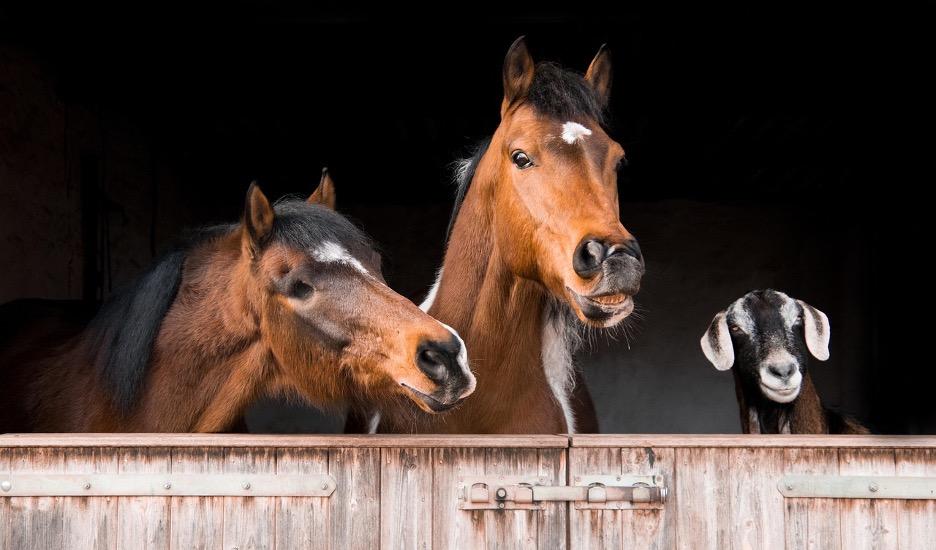
Image by Rebecca Scholz. Pixabay/CC
Some horses bond best with another horse, while others feel calm with a smaller buddy like a goat, donkey, or pony. As such, the key is understanding what your horse needs and matching them with a companion that fits their temperament, energy level, and routine. Below, you will learn how to make the best companion choice.
Understanding Your Horse’s Personality and Needs
A horse’s emotional well-being depends strongly on connection and herd structure. Even confident or independent horses feel safer when they can see, smell, or interact with another animal. Here are the key aspects of your horse’s personality and needs to consider when choosing a companion.
Health Status
Older or senior horses often benefit from a calm, predictable companion who won’t push them beyond their comfort level. Further, horses with chronic conditions, rehabilitation needs, or anxiety may require a bond with an animal that mirrors their pace rather than challenges it. Parasite control matters when choosing a companion because a horse struggling with parasites may feel tired, uncomfortable, or irritable.
Thus, create a reliable deworming routine. For instance, you can eliminate equine parasites using a consistent parasite-management plan that includes regular fecal checks, veterinary guidance, and supportive products designed to help keep the digestive system clear.
Age and Energy Level
A young, playful gelding may frustrate an older, calmer partner who prefers quiet grazing over wrestling or running. Likewise, pairing two high-energy horses can create constant competition or tension. Horses that share similar rhythms usually build trust faster because neither feels overwhelmed or ignored. Watching your horse’s daily habits gives clues about whether they need a lively buddy to engage them or a steady companion that keeps the peace.
Temperament and Social History
A dominant or defensive horse may feel threatened or competitive when paired with another strong-willed animal. However, it may do better with a gentle companion who gives it space and doesn’t escalate tension. Social history also plays a role. Horses that grew up in herd environments usually understand body language and hierarchy, which helps them adapt more quickly. In contrast, horses that lived alone or had bad herd experiences may struggle with social cues.
Companion Options to Consider
Several animals can make great companions for horses, but each has different benefits, care requirements, and compatibility challenges. Below are the most common companions.
Dogs
Dogs can be loyal companions and create a lively barn atmosphere, but they require careful introduction and training. For instance, a dog must learn boundaries around hooves, feeding spaces, and pasture behavior.
If you have never raised a dog before, consider how manageable the breed will be. Dog training, exercise level, and temperament matter. Therefore, consider the best dogs for first time owners, such as Labrador Retrievers, Golden Retrievers, and Cavalier King Charles Spaniels.
Another Horse
The most natural choice is another horse. Horses instinctively understand each other’s signals, routines, and boundaries. It often leads to the healthiest emotional balance. However, cost doubles when you add another full-sized horse, so feed bills, farrier visits, veterinary care, and space requirements must be realistic before committing.
Ponies or Miniature Horses
Ponies and minis offer many of the benefits of bringing another horse, but with lower feed and space demands. They often bond well with full-sized horses, especially if their temperaments align. However, some ponies can become overly dominant, so introductions should be slow and supervised to ensure balance rather than competition.
Donkeys
Donkeys can form deep bonds with horses and provide a calm, steady presence. Their slower, thoughtful nature can help anxious horses feel secure. Since donkeys communicate differently, it may take longer for the bond to form, but once it does, it’s often strong and lasting.
Livestock (Goats, Sheep, Llamas, Alpacas, Cattle)
Livestock can be suitable companions for horses when their temperament and space needs align with the farm environment. Goats are the most common choice since they are adaptable, playful, and comfortable living around horses. However, not every horse appreciates their energy, so early supervision helps ensure the dynamic feels calm rather than overwhelming.
Sheep tend to coexist quietly and offer companionship through proximity rather than interaction. Llamas and alpacas can provide a steady presence and sometimes act as natural pasture guardians, which may benefit nervous or easily startled horses. Cattle may also share space with horses.
Conclusion
A well-chosen companion helps a horse feel calm. It helps reduce stress and encourages natural behaviors such as grazing, movement, and rest. A compatible partner also supports confidence during training and new experiences because the horse feels less alone. Careful pairing prevents tension, resource guarding, or anxiety and creates a calm, stable environment where both animals can thrive.
Training in the Right Way: Using the Lower Leg 18 Nov 2025, 7:32 pm
You can do so much more than simply “kick to go”…
Dressage training is supposed to be the process of training ANY horse to be a better riding horse. The more the horse learns, in theory, the easier it is to communicate with and therefore complete more complex tasks with. Although competition dressage training often is more focused on training for the dressage test, that is not what the original intention (and original judging requirements) were for competitive dressage. Initially, it was designed to give riders and trainers a way to determine how their training measured up to the theoretical ideal of the training process. That said, it is critically important to understand the meanings and reasons for some of the terms we use to describe dressage training and what to look for when observing training and competition (and videos and photos), regardless of whether you intend to compete or just train your horse to be a better whatever you do with him. That, ultimately, is the main purpose of my articles. To provide education and knowledge for riders to understand and improve their eye and understanding of what dressage training is supposed to be. While there will always be some differences in practice and theory, good horse training is always recognizable to the educated eye. That said, it absolutely is necessary that we remember and understand that limited knowledge is limited judgment.
* * *
Often, when I’m teaching new students, I find that they have not been taught how to use the lower leg beyond two legs means go and one leg means go sideways. But when used in the right way, the rider’s lower leg can have multiple different effects on the horse’s body and way of going beyond those basics. (Of course, if you do not use the leg in an effective way already, this nuance will be lost on your horse. Although creating and preserving the correct response to the rider’s leg is a different article).
So, let’s discuss. Have you ever thought about why a horse goes forward from the leg aid? Horses do have to learn that response early in their training life, but it does (pretty much) always work. Two legs bumping or lightly squeezing the side of the horse inspires them to move forward (the direction). To be completely honest, I do not know the scientific explanation of what nerve-endings are along the horse’s side that create that response to the rider’s leg, but I do know that there is an area where the leg works, and then there is a lot of space where the leg does not work. Also, different parts of the “target” area for the rider’s leg can have specific results that we can then create more nuanced, trained results from.
Rarely do I see a rider who consistently uses their leg too far forward. It’s far more common to see it too far back. One very important reason to have the lower leg in the right place is the rider’s balance. And, fortunately, that area is the same area that horses respond to the leg the best! If you look at a picture a rider with an excellent position, you will notice that their head is vertically aligned with their shoulders, their shoulders are aligned with their pelvis, and their pelvis is aligned with their feet. The bottom of the rider’s feet should be parallel to the ground, or have a slightly lower heel positioning. This is how our brain aligns the body to maintain balance, and this is how physics work to keep (or lose) our balance. Once this alignment is lost, we are at the mercy of physics (and the horse’s movement).
So, the rider’s lower leg in its most commonly go-forward-with-the-rider-in-balance placement, should hang down from the knee slightly behind the girth. This assumes that the horse and rider are appropriately sized for each other. This is the moment that you should be thinking, “Wait a second, does the size of the rider on the horse matter partially because of where the lower leg hangs on the horse’s side?” Um. YES. There are many reasons for the horse and rider to be matched by size. One of the reasons is how the rider’s leg hangs on the horse’s side. One of the other really big reasons this is important is that balance thing again — but I digress. Perhaps I will make an article about that some day (Size matters?).
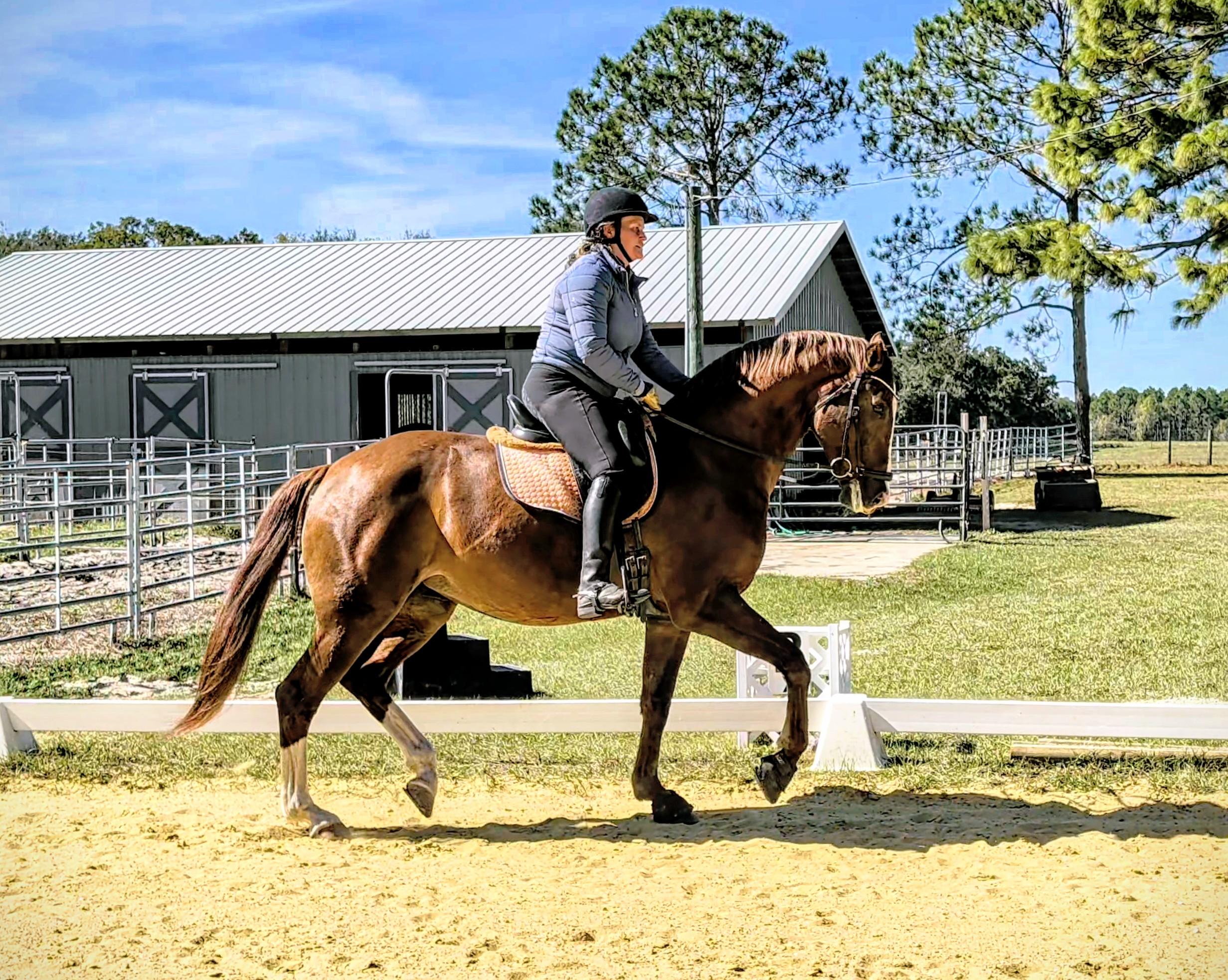
Yes, I am leaning forward in this picture. I am patting Milona for having done something well. Regardless, my body is balanced over my feet and my lower leg is in an effective and balanced position. Photo (c) Morgane Schmidt.
When the rider’s leg is in this area (slightly behind the girth) it reaches the target area that the horse is most likely to respond with a “go forward” response. If the leg is used there to produce a leg yield, most often the horse will respond with moving his whole self sideways away from the leg. To create a good leg yield, your supporting aids (all the other ones I didn’t mention – the other leg, seat, and both hands) need to do the things that direct the horse to leg yield at a specific angle and trajectory. However, that leg position is the position the produces that response. If you put the leg closer to girth (again with the caveat that the other aids are doing supportive things for the leg yield) the rider will effect the horse’s shoulders more.
So, if your horse’s haunches are leading in the leg yield, you can use your leg slightly forward from the standard normal position and put the shoulders in front of the haunches (don’t forget the other aids have to be doing the things that allow this). If your horse’s haunches are trailing, putting the leg slightly further back will help correct this.
I would like to take this moment to remind everyone that when I talk about leg placement and aids, I do NOT mean that you slap the leg on and hold it there until the exercise is over. I mean, in the moment, of those possible alignment issues, you can give AN AID in the position to help correct it. An aid lasts one stride. It can be repeated the next stride, or possibly modified to effect the horse’s body differently, but it does not stay on indefinitely. So, no, you do not just stick your leg in one of these positions and squeeze or kick with all your strength until the end of the exercise. Riding an exercise, any exercise, is done through giving aids in the rhythm of the gait that adjust to what the horse’s response and balance is in the moment. Sorry guy, it’s not “Set it and forget it.”
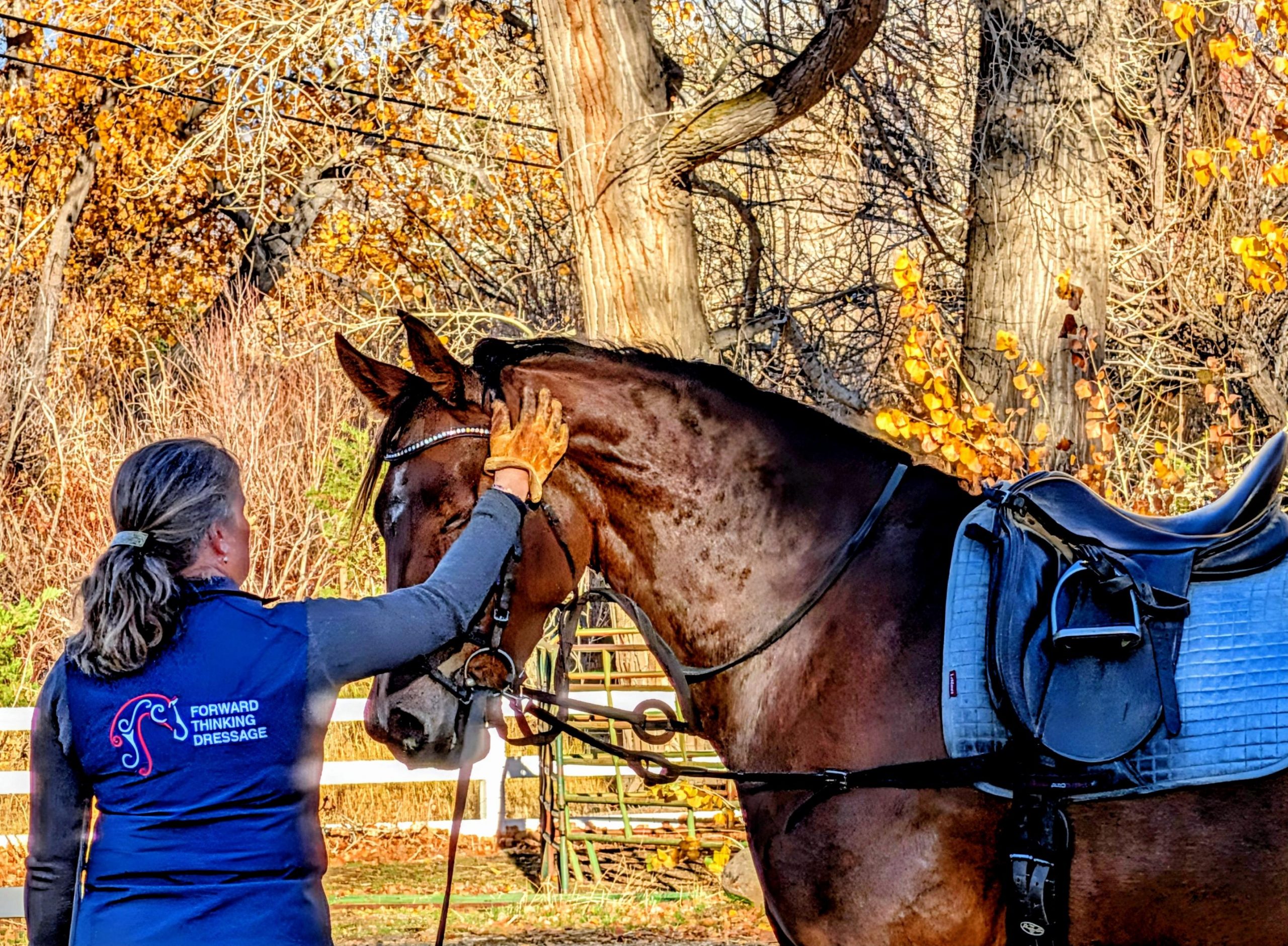
Training is simply repetition of the same expectations over days, weeks, months and years with a systematic approach to introducing new concepts. Photo (c) Morgane Schmidt.
Though I use this example, the intent of this article is not to give a tutorial on how to ride a leg yield. Rather, the intent is to use the leg yield as an example of how the rider’s lower leg placement can have different effects on the horse’s response to the leg. There are many other situations and exercises where the rider would employ similar placements to create similar results in different exercises. Primarily, I would like readers to come away with the understanding that the lower leg of the rider MUST be in the right area for the rider to be balanced on the horse, and for it to have the intended effect of the aid, and that careful placement of the lower leg in specific ways will provide nuance to the horse’s reaction. Because training is simply repetition of the same expectations over time, careful placement and usage of the lower leg over days, weeks, months, and years, will create a better (more on the aids) response from the horse which is the basis of developing self-carriage (which is, of course, ultimately what dressage is all about).
Remember: limited knowledge is limited judgment.
Gwyneth McPherson has over 35 years experience competing, training, and teaching dressage. She began her education in in the late 1970s, riding in her backyard on an 11 hh pony. Her first instructor introduced her to Lendon Gray (1980 and 1988 Olympian). who mentored Gwyneth for a decade during which she achieved her first National Championship in 1984, and her Team and Individual Young Rider Gold Medals in1987.
In 1990 Gwyneth began training with Carol Lavell (1992 Olympian) who further developed Gwyneth as an FEI rider and competitor. Gwyneth achieved a Team Bronze in 1991 and a Team Silver in 1992 in the North American Young Riders Championships, and trained her stallion G’Dur to do all the Grand Prix movements while riding with Carol.
In 2008, while Head Trainer at Pineland Farms, Gwyneth began training with Michael Poulin (Olympian 1992). Michael was trained by Franz Rochowansky (Chief Rider for the Spanish Riding School 1937-1955). Michael has shared much of Rochowansky’s knowledge and wisdom with Gwyneth, completing her education as a Grand Prix rider, trainer, and competitor.
Gwyneth’s teaching and training business, Forward Thinking Dressage,is based in Williston, FL. In addition to teaching riders and training, Gwyneth also loves sharing her knowledge of the sport and art of dressage as well as discussing relevant topics pertaining to the training itself and the current competitive landscape.
The Puddle Monster Ghost Case, Part I: A Pony Detective story 18 Nov 2025, 11:25 am
What starts as a sloppy-track spill quickly turns into a case of fog, folklore, and a missing favorite.
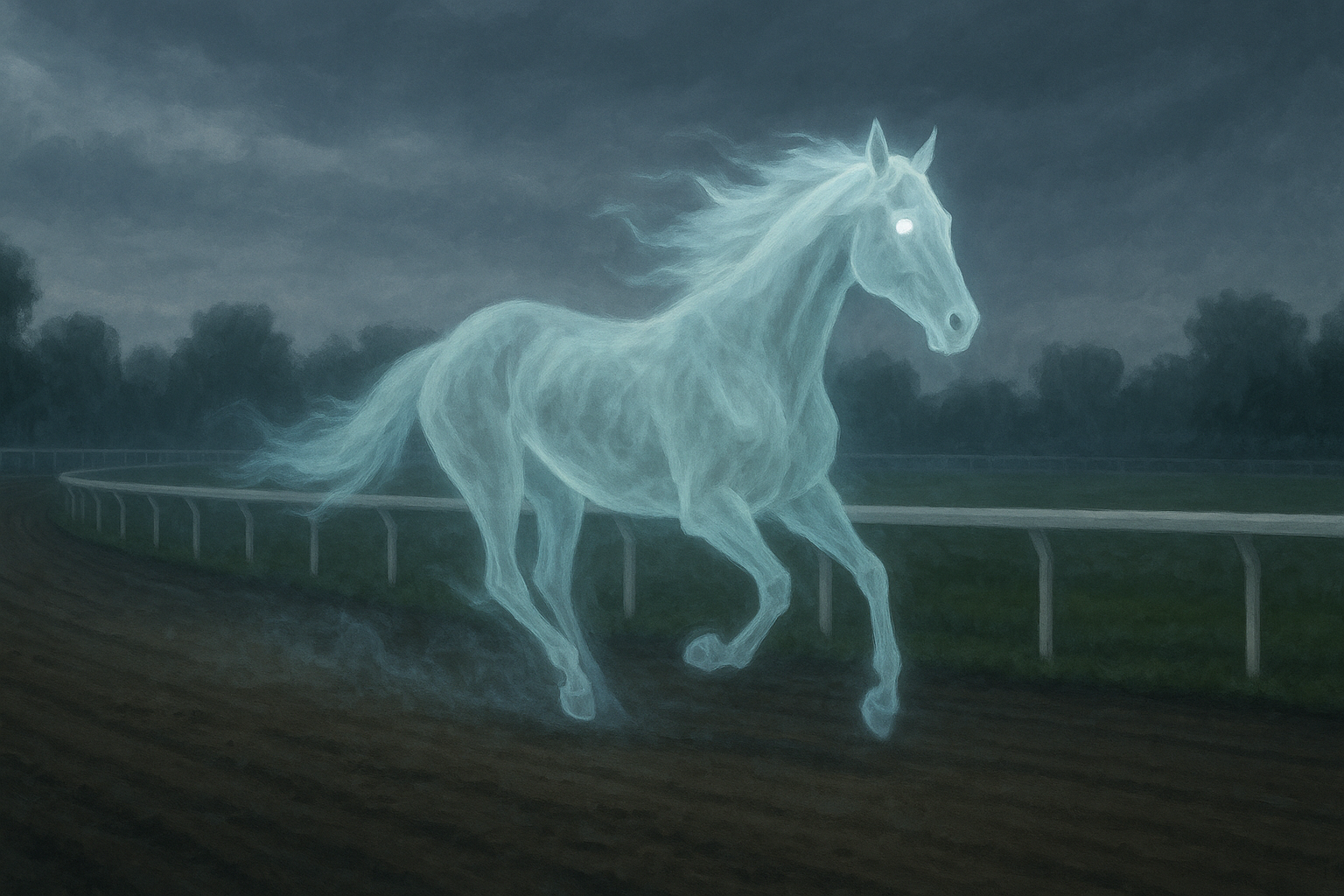
by N.A. Souer
“Run, Charmie, run!” Sasha yelled at the TV on the tack room wall.
“Be careful,” Mama Kitty called. “The track looks slick.”
“Go Charmie, go!” Tweak added.
Mud flew as hooves thundered by on the sloppy track.
Everyone nervously watched.
The announcer’s voice trilled with excitement. “Charm Bracelet is in the lead, Zina Lite is coming up on the outside, followed by Battle Cry and Sandman at the first turn.”
The view on the TV screen switched to an overhead drone, it showed all four horses at top speed. Suddenly there was a pile up, a tangle of legs, hooves and mud. The TV camera switched to a different view at the far turn.
“Charmie’s down!” Sasha screamed. “I saw her go down.”
“Jeepers Gone charges for the lead,” the announcer went on. ”And at the wire it is Jeepers Gone, with a three lengths lead for the win.”
“Show the far side,” M yelled at the TV, just as his cell phone began to ring back in his stall.
“I’m afraid Charmie is hurt,” Mama Kitty said.
Sasha nodded. “Running on a sloppy track is so dangerous,” she said.
The TV picture finally switched back to show the far backstretch, where a horse ambulance blocked the view. The announcer’s voice came back on with a solemn tone. “The track’s veterinarian staff has informed us the favorite, Charm Bracelet, has pulled a tendon and is being transported to the hospital.”
“Poor Charmie,” Sasha said. “She worked so hard to qualify for this race.”
“That’s not the real story,” M said, coming out of his stall. “Let’s go. The track manager wants us down there fast.”
“Why?” Mousy asked.
“Because,” M said with a smirk, “they think Charmie has been swallowed by a puddle monster!”
***
Twenty minutes later the staff of the M&T Pony Detective Agency arrived on the scene. The group was met by track manager, Sollie Joe, a big TB who was also the majority shareholder of the real estate group which owned the property.
“Thank you for coming on such short notice,” he said.
M nodded.
“What happened?” M asked “We watched the race on TV, but it was not clear how bad Charmie was hurt.”
“Well,” Sollie Joe began, after a nervous clearing of his throat, “the official story is that the favorite in the race, Charm Bracelet, tore a tendon and had to be rushed off the track.”
“And, the unofficial story?” M pressed.
The track owner shrugged. “We don’t know,” he said. “All we know is Charm Bracelet has disappeared and we don’t have a clue how or why.”
“What do you mean?” Tweak asked. “We watched her run on TV.”
“Yes,” he answered, “and that’s the last time anyone saw your friend.”
“Come on,” M said. “Racehorses don’t just vanish during a race, especially a contender for the State’s Fall Charity Derby.”
Sollie Joe looked down at M. “That is why I called you,” he said.
M smirked again.
Since retiring from his job as a special agent for NPSS, aka the Northland Pony Secret Service, M had started his own business with his fellow miniature paddock mate, Tweak. The original plan was to do private security and simple case work, but things did not go to plan when the Covid 19 Pasture Virus hit and the economy took a downturn. There were some lean times, but M was determined and thankful for whatever work they got. Over the years the M&T Pony Detective Agency had become known for solving odd cases, even some supposedly paranormal ones. While it was not a reputation M wanted to capitalize on, he humored the clients who were sure they had a ghost problem. Most of the time it was bunk and M knew it, but he was game for any work that paid the bills and allowed him to make payroll each month.
“What else can you tell us?” M asked.
“Well,” he began, “I am not sure if this is connected or not, but a couple months ago we had a similar thing happen on the same part of the track. Several race runners said afterwards it was like they were suddenly in a cloud-like fog and they piled into each other. Fortunately, no one was hurt.”
“What about this puddle monster you mentioned on the phone?” M asked.
Sollie Joe blushed with embarrassment. “Please forgive my lapse of professionalism,” he said. “I was so distraught after witnessing what happened.” He paused, and then offered more explanation. “Three years ago, when a track out in California had so many runners hurt due to footing conditions, the board of directors here decided to be pro-active and initiate changes to our track. As soon as funding was approved, a large improvement project was started. The construction crew had just broke ground to install a new drainage system when equine skeletal remains were found. DNA tests determined it was native equine bones, and work came to a standstill while the racing foundation battled in court with the Appaloosa Horse Tribe over whether or not the land the track sits on is part of the original 1880s Land Treaty.”
“And how did it turn out?” Tweak asked.
“In the end it was determined the border for the 1880s Land Treaty was ten miles south of here,” he went on. “The Racing Foundation offered to section off the area where the remains were found as a sacred site and work around it, but leaders from the Appaloosa Council voted to remove the remains and conduct a ceremonial burial on native land. However, not all members of the Appaloosa Horse Nation agreed with the council’s decision, and claimed we would suffer the wrath of the Great Puddle Monster Spirit for disturbing the site.” Sollie Joe paused and glanced at M. “It all sounds like nonsense, I know. This track has been here twenty-five years. Imagine what a legal nightmare it would be to bull-doze this whole facility and return land ownership to the local native pony tribes.”
“Interesting,” M said, then tried to tactfully change the direction of the conversation. “I’d like to head over to where Charmie was last seen.”
Sollie Joe led the group to the far side of the track.
“It sure is a sloppy day,” M said on the way, as another burst of rain poured down.
“Yes it is,” Sollie Joe said. “We considered cancelling today, but everyone looks forward to the charity race every year.”
“Charmie entered the race in memory of her grandfather, who died of colic,” Sasha said. “She planned to donate any prize money she got to the colic research project at the university.”
As they approached the backstretch, Tweak asked, “So what did you see here at the track when it happened?”
“I don’t know, really,” the big TB said. “Basically, the same thing you did on TV. Four horses were leading the race, suddenly they went down in a pile up, and only three got up.”
“And, you said something weird happened another time?” Mousy questioned. “Was the track in the same condition it is today?”
“No, it was really hot,” Sollie Joe said. “When the rain fell, it was like drops of water on a frying pan.” He paused by the gate, leading out onto the track. “We had this covering put up to preserve the scene,” Sollie Joe said, motioning to a large tent over where the pile up had occurred, “and we cancelled the remaining races for the day.”
“Good thinking,” M said, as yet another shower fell from the sky. “Otherwise, all this rain would wash away any evidence there was.”
“That’s strange,” Mousy said, dodging some good sized puddles to get over to where imprints of several scrambling horses could still be made out in the mud. “It looks like one of the horses had some kind of bar shoe.”
“That’s Charmie,” Sasha said. “She was still having a tendon issue and her farrier said a bar shoe would help reduce the concussion on her heels.”
“But no one races with that type of shoe,” big Sollie Joe said. “It wouldn’t give enough traction to run fast.”
“She looked fast enough to take the lead in the first part of the race,” M said. “Charmie has always been a strong runner,” Sasha said.
“Running a race in bar shoe is not the norm,” Sollie Joe said, shaking his head. “That’s more of a therapy shoe.”
“Maybe so,” Mousy said, “but look at this.” He glanced over at M, and then pointed a paw at a place in the sloppy mess. “The imprints of the bar shoe come this far, then stop here,” he said, motioning to a bulging ridge of sloppy footing. “Beyond this weird bulge of mud, there are no more bar shoe hoof prints.”
M turned to Sollie Joe, and asked,” What about the other horses in the pile up?” Has anyone talked to them?”
“They were pretty shaken up,” Sollie Joe said, “but I’m sure someone from track security got their statements.”
“I’d like my team to talk to them as well,” M said.
“What for?” Sollie Joe asked. “I’m sure they told security everything they knew.” “They saw Charmie last,” M pressed, “so I’d like to get their story first hand.”
***
A half an hour later, Tweak and Sasha stood under an overhang on the back stretch as another shower burst from the sky.
“Here it is,” Tweak said, motioning toward a stall name card that read, Battle Cry, in bold lettering.
The big, chestnut TB came to the stall door and looked out at them. “Yeah,” he said, obviously put out by visitors so soon after a race. “What do you want?”
Tweak began timidly, “We’re from the M&T Pony Detective Agency,” he said. “We’ve been hired by the track’s management to look into what happened today.”
The big horse’s demeanor changed.
“It was horrific,” he said. “We were going all out and the next thing I knew I was flat down in the mud.”
“Did you see what happened to the leader, Charm Bracelet?” Sasha asked.
The big TB scowled at her, then said with irritation, “Lady, I couldn’t see anything except fog and mud.”
“Do you remember anything else?” Tweak asked.
He looked down at Tweak, then seemed to recall something. “There was one stride that felt odd,” he said.
“How so?”
“Well, it felt like my feet hit something hard, like metal.” He paused, then added “Like I said, next thing I knew I was in the mud.”
***
On the other side of the barn, M and Mousy talked to Sandman.
“It was the strangest thing,” the big dapple gray TB said. “We were going along and I was getting ready to come around the outside. Next thing I knew, Battle Cry went down in front of me and I tumbled over him.”
“What about the leaders?” M asked, “Charm Bracelet and Zina Lite?”
“The girls were several lengths ahead,” he said. “It was hard to see them through the fog and mud.”
M thought a moment, then said, “The track was sloppy but it didn’t look foggy.”
The big horse looked down at M.
“It wasn’t at first, just wet mud,” he said, “but when we got to the back stretch it became foggy.”
“Did you see what happened to Charm Bracelet?”
He shook his head.
“It was hard to see anything,” he said. “I heard Zina Lite scream just before I fell. Later, she told me the great puddle monster ate Charmie.” He paused, looked down at M, and then added, “You know how mares are, always dramatic.”
M nodded. He understood.
***
Back at the barn, everyone gathered in the tack room.
“Why would Battle Cry say his feet hit something hard?” Sasha asked.
Tweak shrugged.
“Has anyone talked to the other horse in the race?” M asked
“I tried,” Mama Kitty answered, “but the vet gave Zina Lite a tranquilizer immediately after the race.” Mama Kitty paused, then added “I did talk to one of the track ponies, and he said Zina Lite was extremely upset and kept screaming a giant puddle monster had swallowed Charmie.”
“Anything else?” M asked
“Yeah,” Mousy said. ”I was curious why it was so muddy on that side of the track if the new drainage system had been installed. I went online and looked at the permit filed with the county for the work.”
“And?” Tweak pressed.
“There are some big discrepancies.”
“How so?” M asked.
“Well, not all the measurements submitted for the permit match what actually is out there. I’m going to see the head of track maintenance later today. He indicated on the phone there’s some kind of underground control area near the backstretch.”
“I’d like to see that,” M said, then looked over at Tweak, Mama Kitty, and Sasha. “In the meantime, talk to Charmie’s friends, family, and anyone she’s been around. See if anyone wanted to hurt her.”
“I take it you don’t believe a puddle monster swallowed her?” Mama Kitty asked.
“No,” M said with a disgruntled huff, “cuz I don’t believe in puddle monsters or ghosts.”
…
Tune in tomorrow for Part II.
N.A Souer (Nancy) got talked into submitting the first Pony Detective story by her miniature horse, M&M, who fancies himself a writer. When Nancy explained to M that no one would believe a miniature horse could write, he told her if she did not submit his stories under her name he’d dump her out of the cart on the next trail drive. LOL M (and Nancy) live in the south-metro area of MLPS-St. Paul. Although semi-retired now at age 26, when he is not writing M enjoys an occasional trail drive, but mostly these days he takes Nancy out on walks because the “people vet” told him he should exercise her more.

The real M. Photo by N.A. Souer.
Understanding Horse and Greyhound Racing for Beginners 18 Nov 2025, 9:04 am
Horse and greyhound racing offer excitement and speed, attracting many to the world of betting. For newcomers, grasping the basics is essential to make informed and responsible betting decisions.
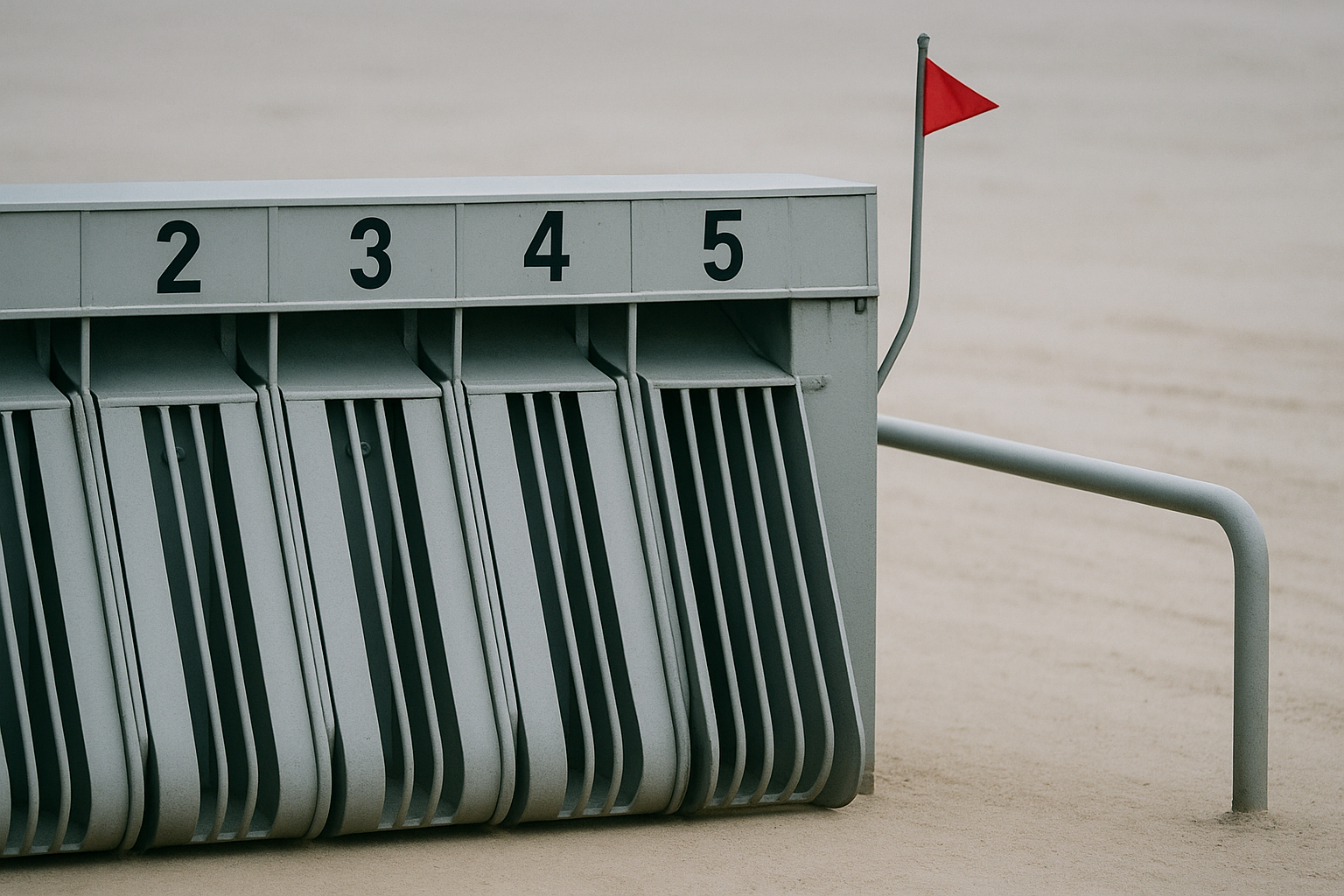
Horse and greyhound racing are thrilling sports that captivate audiences with their fast-paced action. Betting on these races adds an extra layer of excitement, allowing participants to engage more deeply with the events. As interest in these sports grows, so does the appeal of greyhounds betting as a way to participate. For beginners, understanding the fundamental concepts of horse and greyhound racing is crucial. Embracing responsible practices ensures that betting remains an enjoyable activity.
Key concepts in horse and greyhound racing
Before placing bets, it’s important to become familiar with the basic terms used in horse and greyhound racing. In horse racing, terms like “handicap,” “furlong,” and “jockey” are commonly used. A handicap race involves horses carrying different weights to level the playing field. A furlong measures distance, typically an eighth of a mile. The jockey is the rider who guides the horse to victory.
Greyhound racing uses different terminology such as “trap,” “grade,” and “trial.” The trap is the starting position for the dogs, which can influence their performance based on track position. Grades categorize races based on the ability of the dogs, affecting odds and potential payouts. Trials are practice runs that help trainers assess a dog’s form before official races.
While both sports involve speed and strategy, key differences lie in track layout and race length. Horse races vary from short sprints to endurance challenges, while greyhound races are shorter sprints around oval tracks. Despite these differences, similar betting principles apply, such as understanding odds and assessing form, which are crucial for making informed bets.
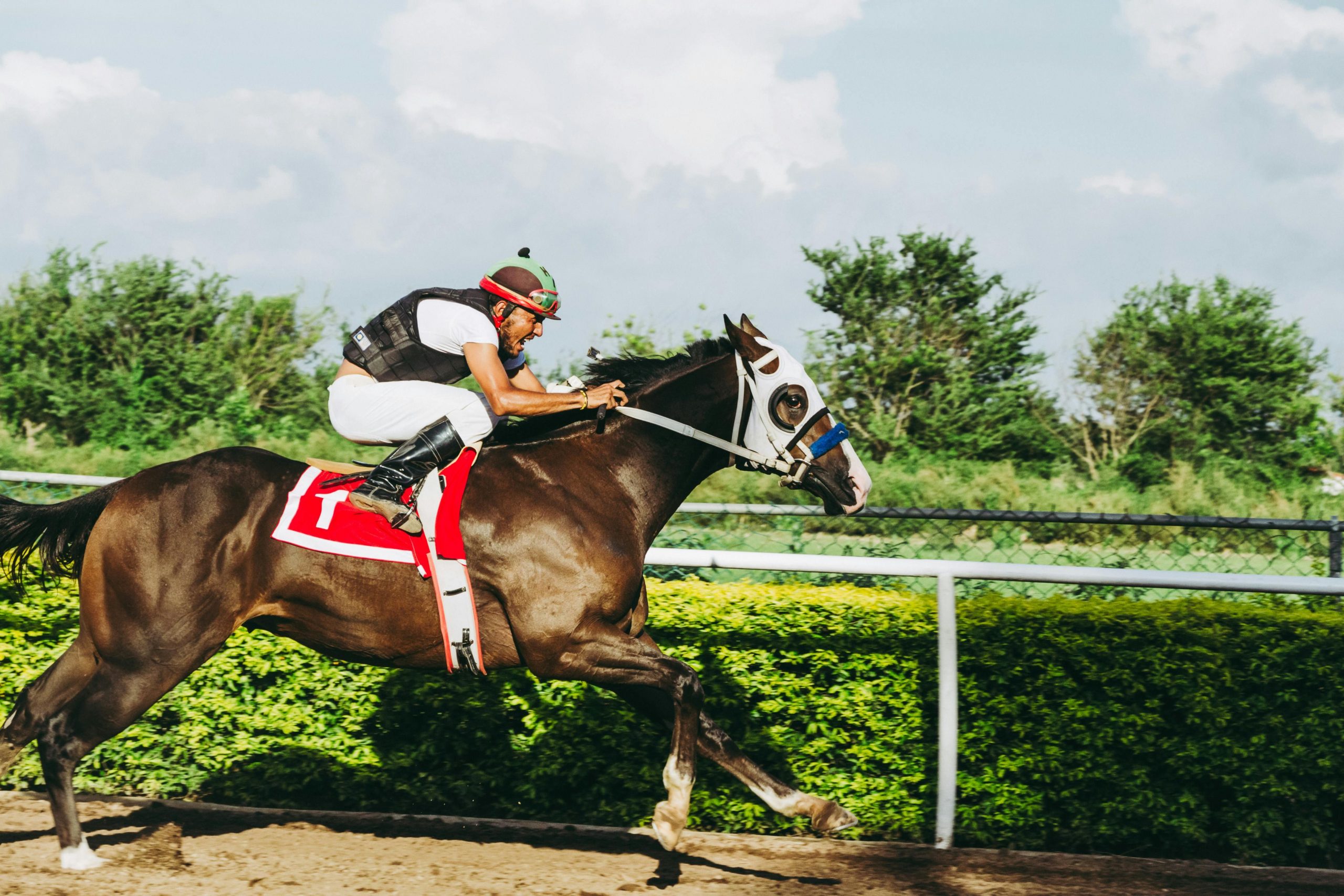
Photo by Jose Ricardo Barraza Morachis. Pexels/CC
Starting your betting journey
To begin betting on horse or greyhound races, you’ll first need to choose a reputable platform or venue that offers these options. Look for platforms with easy navigation and clear explanations of available bets. Registering an account typically involves providing some personal details and setting up a payment method for transactions.
Once registered, explore the range of races available to bet on. Horse racing events often feature multiple races in a single day, while greyhound meetings may offer several races within a few hours. Study past performances by analyzing form guides that provide insights into past results and current condition of horses or dogs.
Understanding odds is crucial; they indicate the potential payout relative to your stake. Odds can be displayed in fractional or decimal formats depending on regional preferences. Selecting races with favorable odds requires balancing potential returns against perceived risks based on your research.
Strategies for informed betting decisions
Successful betting relies heavily on well-researched strategies rather than relying solely on luck. Begin by studying trends within the sport—track conditions, weather forecasts, and recent performance records all contribute valuable insights into likely outcomes.
Staying updated with current information is vital; follow expert analyses through reputable sources for timely advice before placing any bets. This ensures you’re aware of any late-breaking news affecting participants’ performances or changes in race conditions.
Developing an analytical approach helps you spot value bets—situations where you believe the bookmaker’s odds don’t reflect true probabilities accurately. By consistently identifying value opportunities over time while managing risk effectively through varied bet sizes based on confidence levels, you can increase your chances of success.
Maintaining responsible betting habits
While engaging in horse or greyhound racing bets can be exhilarating, maintaining responsible habits is paramount. Set limits beforehand regarding how much money you’re willing to wager each session—this prevents financial strain from overshadowing enjoyment derived from participating in this activity.
Recognize signs indicating when gambling may become problematic; if it affects personal relationships or finances negatively beyond what was initially intended as entertainment purposes only, then immediate action should be taken either through self-exclusion options provided by bookmakers or seeking professional help if necessary.
Ultimately, responsible gamblers view wagering not just as potentially profitable but also inherently risky recreational pursuit where losses are accepted as part of the overall experience. This approach adds thrill without compromising long-term well-being or financial stability, ensuring continued participation remains a healthy balance between fun and reward.
Tuesday Video: Lesson Horses are the Real MVPs 18 Nov 2025, 8:53 am
Many of us were fortunate enough to have great teachers in horses.
If lesson horses had resumes, they’d list “professional babysitter,” “mind reader,” and “unpaid therapist.” They put up with so much and still meet us with soft eyes and steady hearts. Truly worth their weight in gold. Enjoy this week’s dose of pure cuteness!
Grab your lesson horse and go riding, Horse Nation!
Barn Fire Safety: What Every Horse Owner Needs to Know This Winter 17 Nov 2025, 10:20 am
Prevention is key, but have a plan. Because barn fires are devastating and they happen fast.
Key insights courtesy of Dr. Kyle Jonson of Texas A&M University School of Veterinary Medicine and Biomedical Sciences
When winter rolls in, we all start migrating into the barn like horses to a feed bucket. Heat lamps, closed doors, extension cords, hay stacked everywhere… it’s cozy until it isn’t. Barn fires are fast, devastating, and often preventable — and protecting our horses means getting ahead of the danger before the first cold snap hits.Embed from Getty Images
Horse Nation rounded up the must-knows from Dr. Kyle Johnson, clinical assistant professor at the Texas A&M College of Veterinary Medicine and Biomedical Sciences, to help you fire-proof your barn and prep a solid emergency plan.
Why Barn Fires Happen (And Why They’re So Dangerous)
Barns are basically giant tinderboxes full of hay, shavings, dust, and wood — and according to Texas A&M:
Over 80% of barn fires start because of electrical issues or human error.
Common culprits:
- Cigarettes tossed where they shouldn’t be
- Space heaters too close to hay
- Hot equipment left on combustible surfaces
- Lightning strikes are another major cause — especially in rural, open areas.
And because barns are often far from town, emergency response can be delayed, meaning prevention becomes critical.
Fire Prevention 101: What Every Barn Needs
To cut down on ignition sources and fire fuel, Dr. Johnson recommends:
 No smoking in or near the barn (ever).
No smoking in or near the barn (ever).
 Check all electrical wiring regularly and fix issues fast.
Check all electrical wiring regularly and fix issues fast.
 Don’t overload outlets or run a spaghetti mess of extension cords.
Don’t overload outlets or run a spaghetti mess of extension cords.
 Avoid welding or torch-cutting in or near the barn.
Avoid welding or torch-cutting in or near the barn.
 Store hay, straw, diesel, and gasoline separately — not piled together.
Store hay, straw, diesel, and gasoline separately — not piled together.
 Remove cobwebs and dust often (they catch fire fast).
Remove cobwebs and dust often (they catch fire fast).
 Install a professional lightning protection system to divert strikes safely.
Install a professional lightning protection system to divert strikes safely.
Important note: regular smoke detectors don’t work well in barns due to dust and humidity. Instead, use:
- Carbon monoxide detectors
- Commercial fire-detection systems tied to a security company or local fire department
These can drastically improve response time.
If a Fire Starts: Seconds Matter
Barn fires move fast. How fast?
- Hay and shavings can hit 300°F in under five minutes.
Once flames take hold, your priority is getting out and getting your animals out — safely.
Dr. Johnson stresses:
- Call 911 immediately.
- Do NOT go back inside — smoke and toxic fumes can kill before the flames reach you.
- Heat and structural damage make barn collapse likely.
Always have fully charged ABC fire extinguishers mounted at every barn entrance — and make sure everyone knows how to use them.
Evacuating Horses: Your Step-By-Step Plan
When the clock is ticking, you need a plan you’ve practiced — not one you’re making up on the fly. Dr. Johnson recommends:
- Keep a halter and lead rope at every stall (not buried under blankets, not “somewhere in the tack room”).
- Stay calm and lead horses quickly away from smoke and flames.
- Move them to a pre-selected paddock or pasture far from the fire zone.
- Hose them off thoroughly to remove embers and soot.
Why hose them?
- Soot contains toxins harmful to humans and horses.
- Embers can stay hot and reignite bedding or hair.
Once evacuated, every animal should be checked by a veterinarian, even if they look fine. Smoke inhalation injuries can take 12–24 hours to appear and can be life-threatening.
Write the Plan. Practice the Plan. Post the Plan.
A barn fire plan isn’t something you store digitally in the “I think I saved that somewhere” folder.
Dr. Johnson’s advice:
- Write it down.
- Go over it with everyone — boarders, barn help, family, kids, the neighbor who feeds when you’re away.
- Practice it just like a fire drill.
In an emergency, adrenaline takes over — and training saves lives.
A barn fire is every horse owner’s nightmare — but preparation can mean the difference between tragedy and everyone walking out safe. With smart prevention, a clear plan, and the guidance shared by Texas A&M University, your barn can stay warm this winter without becoming a fire hazard.
Stay safe, Horse Nation. Your horses (and your peace of mind) will thank you.
About Texas A&M University
Established in 1876 as the state’s first public university, Texas A&M University is one of the largest universities in the nation yet remains grounded in its military roots and Aggie Core Values of Excellence, Integrity, Leadership, Loyalty, Respect and Selfless Service. As a research powerhouse and a land-, sea- and space-grant institution, Texas A&M seeks to solve the issues facing Texas, the nation and the world. Named by Fast Company Magazine as one of the world’s Most Innovative Companies in 2025, Texas A&M counts seven Fortune 500 CEOs as former students and was named by The Wall Street Journal as the best in Texas and No. 11 public institution in the U.S. for 2025. Texas A&M was named the most recognized university in the state of Texas and No. 2 among all U.S. public universities in the latest Global University Visibility (GUV) rankings compiled by higher education research and consulting firm American Caldwell.
‘Oh Crap’ Monday: Gravity Always Wins 17 Nov 2025, 9:46 am
Monday already is the crappiest day of the week…
so it only makes sense that we make things official. Here’s our latest “oh crap” moment.
You know that feeling when you march into a new week full of confidence, ready to take on challenges like the unstoppable, hyper-competent adult you pretend to be? Yep. That was the energy heading into this “no-hands mounting challenge.” Big plans. Big ambition. Big “I’ve watched one TikTok and am now basically a stunt rider” energy.
And then… reality.
Because nothing humbles a person faster than attempting to hop onto a horse with no hands, only to immediately tumble off the other side like a sack of potatoes being pushed off a shelf. One minute you’re channeling elite equestrian ninja vibes, the next you’re looking at the ground, questioning life choices, gravity, and possibly your chiropractor.
To Instagrammer pfcs1990: thank you for your service. You’ve reminded us that horses keep us grounded… sometimes literally.
Happy Oh Crap Monday, everyone. May your week be filled with fewer unplanned dismounts and significantly more dignity.
Go forth and tackle your Monday, Horse Nation.
Have an “Oh Crap” moment to share? Email your photo/video and a brief explanation of what is going down to deann@horsenation.com. Instagram users, tag your moments with #OhCrapMonday (your photos need to be set to public or we won’t see them!).
The Lasting Influence of a Skilled Trainer 17 Nov 2025, 7:34 am
“Selecting the appropriate trainer is not a matter of choosing the most prominent name or the highest price point… You are not just paying for a set number of training rides. You are investing in your horse’s cognitive and emotional framework.”
When starting a young horse under saddle, no decision has a more lasting influence on its trajectory than the choice of trainer. An effective trainer does far more than simply “get a horse broke.” They establish the cognitive, emotional, and physical framework upon which the horse’s entire future performance and behavior will rest. Those initial 30, 60, or 90-plus days of training are not merely a period of acquiring basic cues; they represent a critical developmental window in which the horse’s neurological patterns, perceptions of pressure and release, and responses to the environment are formed. In essence, early training does not just teach a horse what to do, it shapes how the horse will interpret the world and engage with it for the remainder of its life.
When a horse is first being started under saddle, every stimulus they encounter becomes a formative reference point. Each sound, visual cue, tactile sensation, and movement contributes to the horse’s developing framework for how human interaction is interpreted. Skilled trainers recognize the developmental significance of these early exposures and utilize them with deliberate intention.
Equine learning theory underscores that horses acquire patterns and habits primarily through repetition, association, and the consistent application of pressure and release principles. When a trainer approaches a young horse with calmness, patience, and fairness, the animal begins to encode humans as predictable partners, to perceive pressure as a manageable signal rather than a threat, and to approach novel challenges with reduced fear reactivity. Conversely, research indicates that rushed, inconsistent, or force-based handling can elevate stress hormones, impair learning, and condition the horse to view humans as unpredictable sources of pressure, often resulting in heightened vigilance, resistance, or panic responses.
The cognitive and emotional imprint formed during this early period influences a wide spectrum of later behaviors, including how a horse accepts tack, loads into a trailer, responds to aids under saddle, and processes environmental stressors. Although behavioral modification is possible later in life, the foundational neural pathways established during a horse’s initial training phase are notably resilient. Early experiences contribute to synaptic wiring that becomes increasingly difficult to reshape as the horse matures. The quality of early training does not merely shape behavior, it shapes the horse’s entire perception of the world, establishing a mental and emotional baseline that will follow her throughout her lifetime.
When a horse is confronted with pressure, it must make the decision whether to yield, lean into the stimulus, freeze, brace, or flee. These responses are rooted in the horse’s natural ethological repertoire, but they can be shaped significantly through early training. A well-started horse learns to cognitively process pressure rather than respond with reflexive reactivity. This capacity to think instead of react stems from consistent, intentional, and well-timed handling. An effective trainer does more than teach mechanical responses; they cultivate the horse’s decision-making processes. The distinction between reactivity and responsiveness is one of the defining markers of quality foundational training.
Equine learning research highlights that predictability, clarity, and the timely release of pressure are central to developing confident, regulated behavior. When a young horse learns from the outset that human cues are trustworthy and that correct responses consistently lead to the release of pressure, it begins to engage with tasks as a problem-solver. Such horses demonstrate improved emotional regulation, lower cortisol reactivity, and a greater tendency to seek guidance rather than avoidance.
Conversely, a horse started with excessive pressure, inconsistent cues, or fear-inducing methods may encode humans as sources of chaos. In these environments, the sympathetic nervous system becomes dominant, and survival-based responses, flight, fight, or freeze, are reinforced. Over time, this shapes not just isolated behaviors but the horse’s entire decision-making architecture. Early training effectively influences the patterns of neural activation that dictate how the horse evaluates stimuli, interprets pressure, and chooses its responses. the initial training period teaches a young horse actions but also conditions the way they think, perceive, and engage with the world.
Every horse, regardless of temperament, inevitably encounters moments of fear or uncertainty, a flapping tarp, a voice on the loudspeaker, or the unfamiliar atmosphere of a new arena. The critical factor is not whether the horse experiences these stressors, but how its prior conditioning has prepared it to interpret and respond to them.
Effective trainers introduce young horses to novel stimuli in a manner that promotes confidence rather than trauma. Instead of overwhelming the animal they use incremental exposure, allowing the horse to remain within a tolerable arousal range. This approach supports the horse’s ability to stay soft, to remain cognitively engaged, and to maintain connection with the rider even when sympathetic activation, such as elevated heart rate or adrenaline release, occurs. Research in equine stress physiology demonstrates that controlled exposure combined with predictable handling reduces the likelihood of maladaptive fear responses and facilitates long-term emotional resilience.
In contrast, trainers who force rapid exposure or apply excessive pressure risk pushing the horse beyond its coping threshold. Horses subjected to such methods may learn to internalize fear, suppress behavioral responses, or escalate into explosive reactions when overwhelmed. These maladaptive patterns can manifest as chronic spooking, bolting, heightened startle responses, or complete shutdown. Such outcomes underscore that early exposure is not merely about desensitization, but about shaping the horse’s capacity to manage stress throughout its life.
The fight-or-flight response is a deeply ingrained physiological mechanism in horses, rooted in evolutionary pressures that favored rapid escape behaviors for survival. While the instinct is universal across the species, the way it manifests under saddle is significantly influenced by the shaping that occurs during a horse’s early training.
A horse started with calm handling, consistent reassurance, and fair, well-timed pressure develops the capacity to remain cognitively engaged even when startled. Such horses may momentarily flinch or hesitate, but they rapidly reorient their attention back to the rider. Through repeated positive associations, they internalize the rider as a source of safety and guidance rather than unpredictability or fear. Equine behavioral studies show that this type of early experience strengthens the neural pathways associated with emotional regulation and reduces the horse’s baseline reactivity to environmental stressors.
Conversely, a horse that is rushed, exposed to unclear cues, punished unfairly, or forced to operate in a state of confusion often learns that it must rely on its own survival instincts when pressure arises. In these cases, the sympathetic nervous system dominates, triggering flight-based behaviors such as bolting, spinning, or bucking. The brain reverts to instinctual survival mode because the horse has learned through experience that human interaction under stress does not lead to relief or clarity. Research on equine stress conditioning indicates that these early experiences can heighten startle responses and create long-term patterns of avoidance and panic.
Once such reaction patterns are established, they require considerable time, consistency, and patient retraining to modify. While trust can be rebuilt and responses softened, the deep neural pathways formed during early training remain influential. The first trainer shapes the horse’s fundamental stress-response architecture for years to come.
Another critical indicator of high-quality foundational training is the horse’s ability to adapt to new riders, particularly its long-term owner. Not all training programs cultivate this flexibility. Some horses return home technically broke, yet responsive only to the cues, timing, and body language of a single trainer. The horse has learned a narrow, trainer-specific communication system, and any deviation from that system results in confusion or anxiety.
A thoughtful trainer, however, teaches the principles behind the cues rather than merely conditioning rote responses. They emphasize conceptual learning, pressure and release, softness, balance, and attentiveness, so the horse can generalize these ideas across different riders and contexts. This mirrors well-established learning theory, which shows that animals capable of generalization exhibit greater behavioral flexibility and lower stress when confronted with novel situations. A horse trained in this way is not tied to the subtleties of one person’s riding style; instead, it understands the underlying logic of human signals. That adaptability is where the true value of foundational training lies.
When a horse is overly patterned to a single trainer’s highly specific style, the owner may struggle for months or even years to form a connection. The horse is not being defiant; it is simply attempting to operate within a communication framework that no longer aligns with the cues it receives. From the horse’s perspective, the rules have changed without warning. Skilled trainers anticipate this eventual transition and deliberately prepare the horse to succeed beyond their own hands, creating an animal that is confident, versatile, and capable of forming new partnerships with clarity and trust.
It is not always a matter of cruelty or incompetence; sometimes a trainer is simply an incompatible match for a particular horse. Equine temperament research shows that different horses have distinct sensory thresholds, coping styles, and learning speeds. Some require a slow, quiet introduction with ample reassurance to build confidence, while others thrive under clear structure, consistency, and well-defined boundaries. When a horse’s innate temperament does not align with the trainer’s methods, the mismatch can produce confusion, frustration, or even fear.
A horse that is rushed, overfaced, or handled in a way that does not align with its emotional capacity may never fully regain the trust eroded during those early experiences. This often manifests as anxiety under saddle, inconsistent or contradictory responses to cues, or learned helplessness sometimes appearing as shutdown behavior. Physically, such horses may carry chronic tension, stiffness, or guarded movement patterns that reflect underlying emotional dysregulation. Cognitively, they begin to approach interactions with hesitation and doubt, having learned to question rather than trust human guidance.
This does not mean these horses are beyond recovery; with time, patience, and a handler who understands their individual needs, meaningful rehabilitation absolutely is possible. Yet the process is often lengthy and requires careful rebuilding of both confidence and clarity. Much of that hardship could have been avoided with a more suitable trainer that honored the horse’s temperament and supported its psychological development from the beginning.
Selecting the appropriate trainer is not a matter of choosing the most prominent name or the highest price point. Rather, it requires identifying a professional whose methods align with your horse’s individual temperament, learning style, and emotional needs. Effective foundational training is inherently personalized; what works for one horse may be counterproductive for another.
Before sending a young horse to a trainer, it is essential to consider the following questions:
- Does this trainer take the time to read the horse in front of them?
- Do they value communication and softness over speed and control?
- Are they willing to adjust their methods based on the horse’s feedback?
- Do they involve the owner in the process to ensure a smooth transition home?
You are not just paying for a set number of training rides. You are investing in your horse’s cognitive and emotional framework, the way they will interpret human interaction, process pressure, and navigate the world for the rest of their life.
A properly started horse demonstrates more than refined movement; it exhibits enhanced cognitive engagement and emotional resilience. Such a horse seeks collaboration rather than evasion, approaches novel experiences with curiosity rather than apprehension, and maintains composure under pressure. These qualities manifest consistently across all disciplines, whether in flatwork, trail riding, or competitive arenas, shaping every subsequent interaction and performance.
When considering the placement of a young horse for initial training, it is crucial to recognize that this decision extends far beyond selecting a set of technical skills. You are, in essence, choosing the foundational cognitive and emotional framework that your horse will carry throughout its life.
Mud Season Is Here (And This Is Why We Can’t Have Nice Things) 14 Nov 2025, 10:43 am
Or: How Your Light-Colored Horse Destroyed Your Sanity
Some people have an autumn filled with beautiful foliage, crisp mornings, and cozy sweaters. Horse people might have those things, but we also have mud season — that magical time of year when the world hasn’t frozen yet, but the leaves are off the trees, and the pre-wintry mix of rain/slush/sleet turns into a brown soup and your light-colored horse takes it as a personal challenge to become the same shade as a swamp monster.

If you own a gray, a paint, a palomino, or heaven help you, a cremello… this one’s for you. Solidarity. Thoughts and prayers. May your laundry detergent be strong and your sanity stronger.
Here are eight sure-fire signs you’re in the thick of mud season with a light-colored horse:
Sign #1: Your Horse Awakens Each Morning With One Goal — Destroy All Cleanliness
You spent hours grooming yesterday. You curry-combed. You brushed. You bathed. You prayed. You even used the expensive whitening shampoo that smells like angel tears and crushed lavender.
Your horse?
He woke up, walked straight outside, made eye contact with you across the field, and sat down in the only mud puddle big enough to swallow a SmartCar.
He didn’t roll. He marinated.

The infamous pony named Pony after a good roll in the mud. Photo by DeAnn Long Sloan.
Sign #2: The Science of Mud Magnetism (You Didn’t Ask, but Here We Are)
Light-colored horses possess an extraordinary and totally unstudied natural phenomenon called Gravitational Mud Attraction.
How else do you explain that:
- Their legs attract mud from six feet away
- Their tails drag through muck even when they’re tied up
- Their manes sponge up dirt from the air
- Every other horse in the pasture looks… fine?
It’s physics, probably. Or spite.
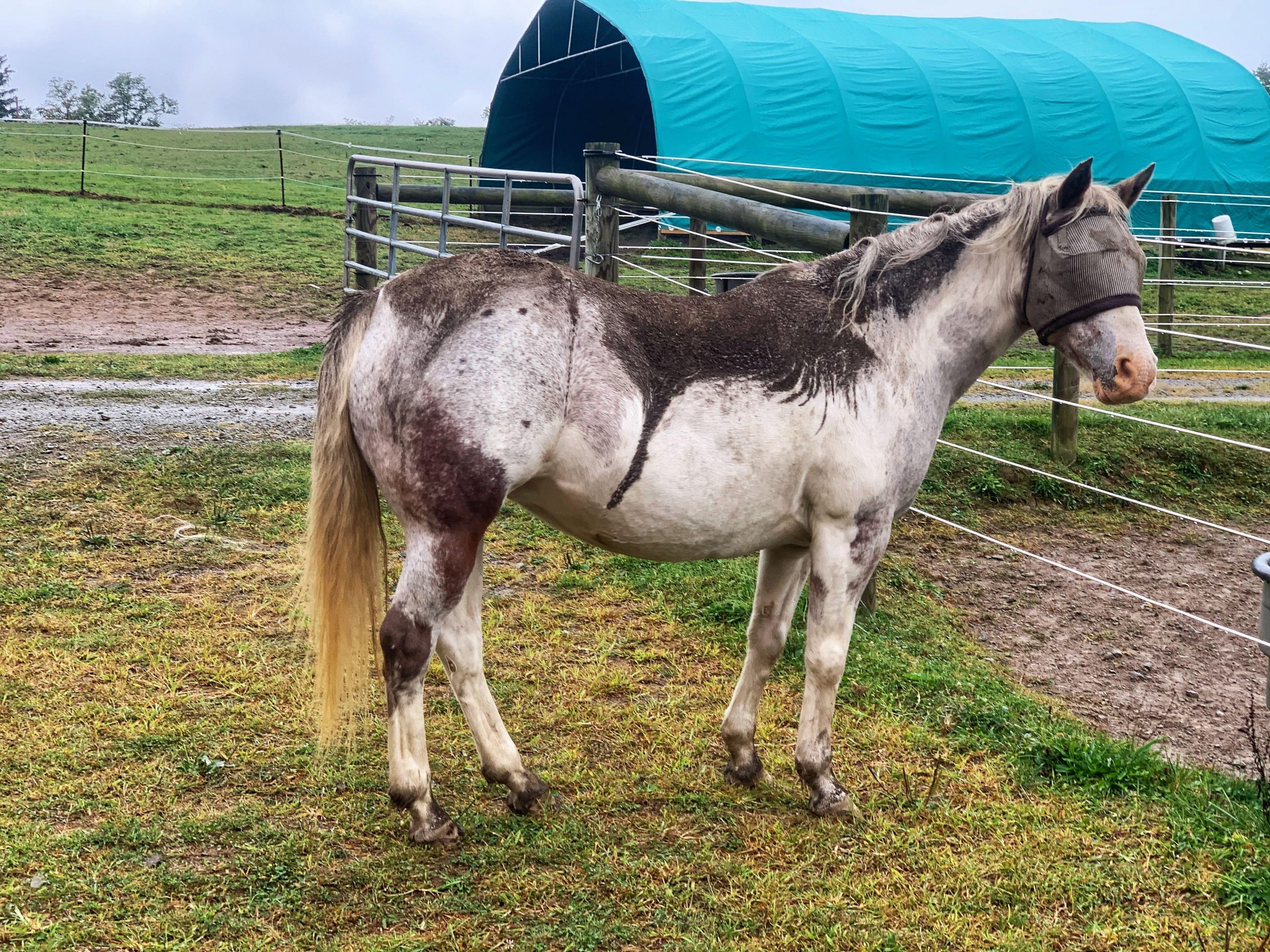
She’s not at all sorry. Photo by DeAnn Long Sloan
Sign #3: The Futility of Grooming Becomes a Core Personality Trait
You begin the season optimistic: This year will be different. This year I’ll stay ahead of the mud.
Then you walk into the barn and your once-white horse looks like a Jackson Pollock painting done entirely in brown.
You:
- Curry for 15 minutes
- Brush for 20
- Get out the detangler
- Try a damp rag
- Try a stiff brush
- Try making bargains with the universe
- Consider shaving the horse
- Consider shaving your own head just to feel in control of something
And after all that?
He still looks “vintage beige.”

Tequila sporting her version of “vintage beige.” Photo by DeAnn Long Sloan
Sign #4: The Tail That Never Dries
There is no wet object on earth wetter than a dirty, soaking, mud-saturated horse tail in November (except maybe a dirty, soaking, mud-saturated horse tail in March).
You can wring it out like a mop.
You can blow-dry it (don’t lie, we’ve all tried).
You can threaten it.
You can braid it.
It won’t matter. At some point, that tail is going to slap you across the face and baptize you in the waters of your own poor life choices.
Sign #5: Whitening Shampoo Season Begins
This is when your barn aisle becomes a crime scene of purple stains and ruined shirts.
Your horse looks like a deity after a long day at the spa. You look like Barney the dinosaur had an allergic reaction on your hands.
Sign #6: Your Tack Becomes an Accessory to Chaos
It doesn’t matter that your saddle is dark brown.
It will come away from the ride covered in mud smudges shaped like your horse thought about being clean and then changed his mind.
Also, there will be mud on your reins.
On your gloves.
On your breeches.
Inside your boots somehow.
In your truck.
On your dog.
On your soul.
Sign #7: Acceptance
Somewhere around week three you stop trying to fight it.
Your horse is filth.
You are filth.
The world is filth.
You realize the only way to win is to embrace it.
You start using phrases like:
“He’s clean for November.”
“This is his natural ombré.”
“I’m going for a rustic look.”
“That’s not mud — it’s just aggressive shadowing.”
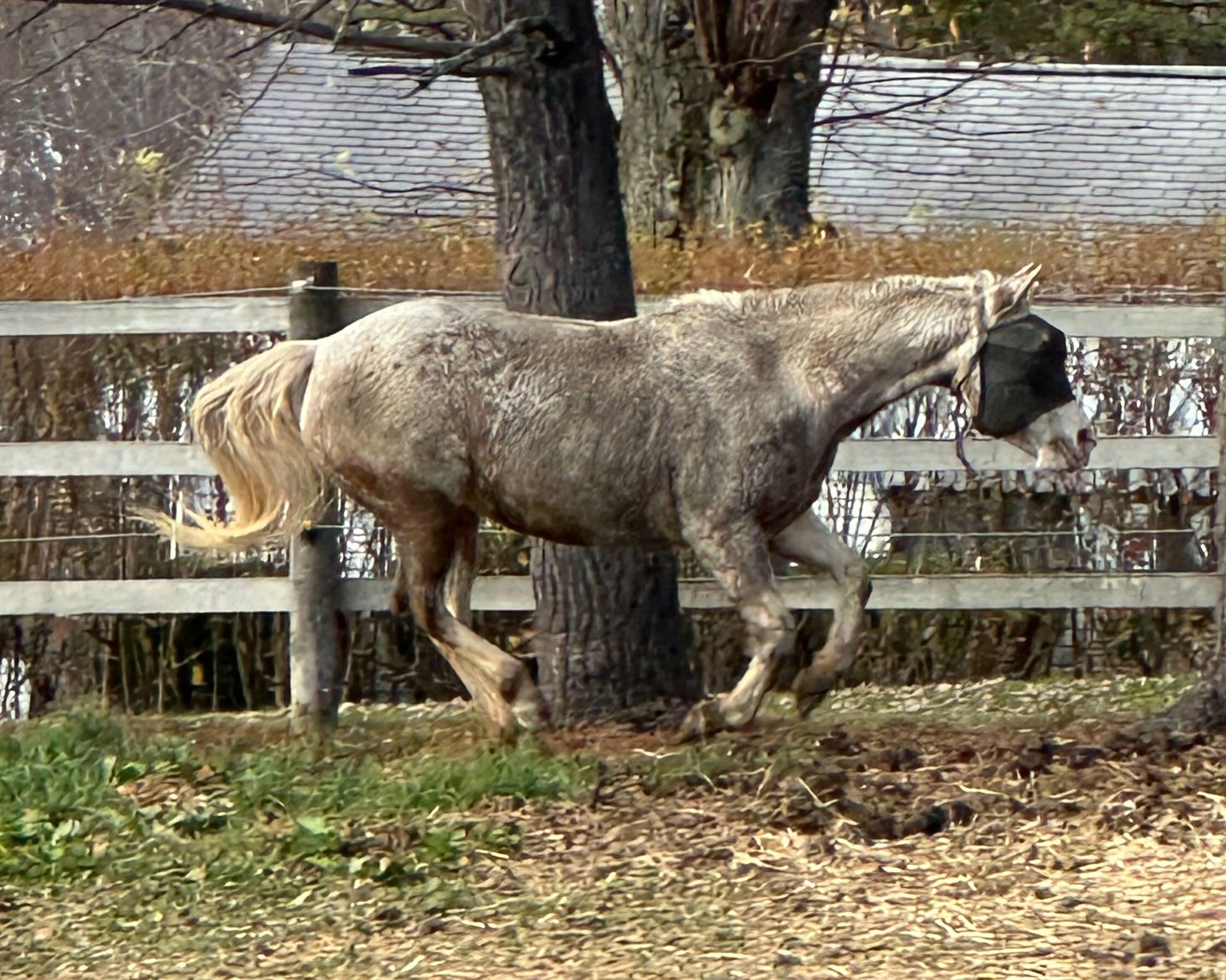
Pony with the zoomies following a mud bath. Photo by DeAnn Long Sloan
Sign #8: The Triumph (Temporary, Fragile, Beautiful)
One glorious day, the mud dries. Or freezes (it doesn’t really matter — it’s not mud anymore).
Your light-colored horse finally turns back into the majestic creature you vaguely remember.
You take pictures.
You post them online.
You say things like “He’s SO white right now!”
And then he walks to the largest pile of manure he can find and lies down.
And So, We Ride On
Mud season is a yearly battle that none of us win, but all of us survive. Barely. Your light-colored horse will look like a disaster. Your grooming tools will live in a state of emergency. Your blood pressure will rise every time it rains. And your muck boot? Lost somewhere in the muck and mire next to the run-in shed.
But hey — at least we’re all in this muddy, messy, beige-tinted chaos together.
May your horse stay (sort of) clean, your sanity hold strong, and your mud puddles be shallow.

Atlanta BEST Academy Polo Team Makes a Winning Debut (and Some Serious History) 14 Nov 2025, 8:03 am
The nation’s first all-Black high school polo team just stepped onto the field and into the record books.

The Atlanta BEST Academy Polo Team at the 2025 Black-Tie Soul Symphony. Photo by Phil Jackson.
The Atlanta BEST Academy Polo Team just swung into the spotlight — and straight into the winner’s circle. At their competition debut during the 8th Annual Atlanta Polo Party (part of the 2025 Soul Symphony Weekend), the team of Caleb Choice-Sanchez, Syncere Poole, Declan Fitzpatrick, Ryland Hammond, Mikel Banks, and Quinn Ramsey edged out the Starr Creek Polo Club 4–3 in a nail-biter match that had spectators cheering like they were at the Kentucky Derby.
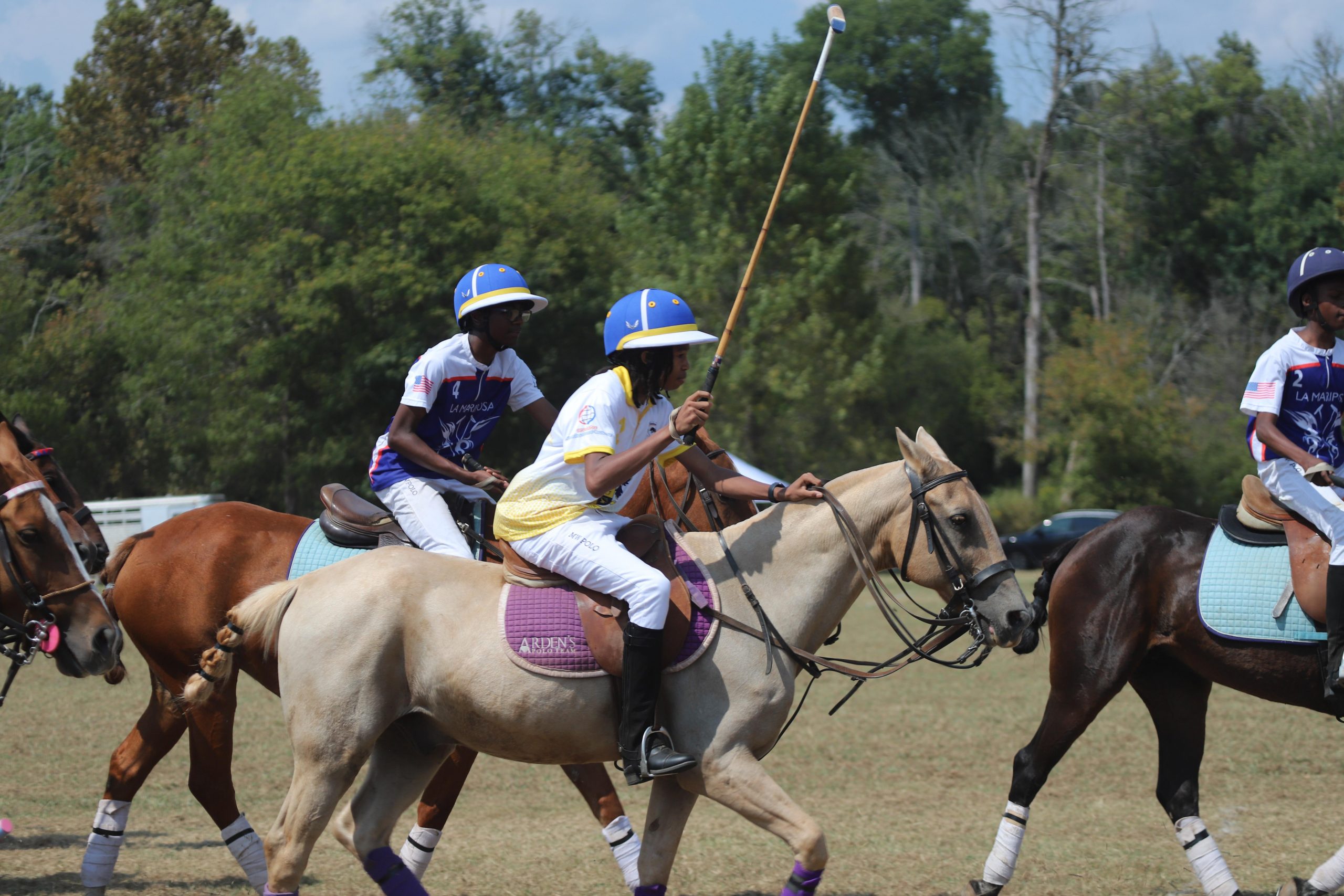
Atlanta BEST Academy Polo Team vs the Starr Creek Polo Club at the 2025 8th Annual Atlanta Polo Party. Photo by Darrell Stoney.
Pretty impressive… especially when you learn that just two years ago, most of these young riders had never even sat on a horse.
The Atlanta BEST Academy squad exists thanks to celebrity fashion designer and equestrian trailblazer Miguel Wilson, who co-founded the team through his nonprofit, the Ride to the Olympics Foundation. Created in partnership with the 100 Black Men of Atlanta and Atlanta’s BEST Academy, the program launched the nation’s first all-Black high school polo team — with the goal of chipping away at the financial and cultural barriers that have long kept many Black riders out of the sport.
“We’re making history, and these young men are blazing a trail that we hope others will follow,” Wilson said. “It’s about more than just a game; it’s about leveling the playing field.”
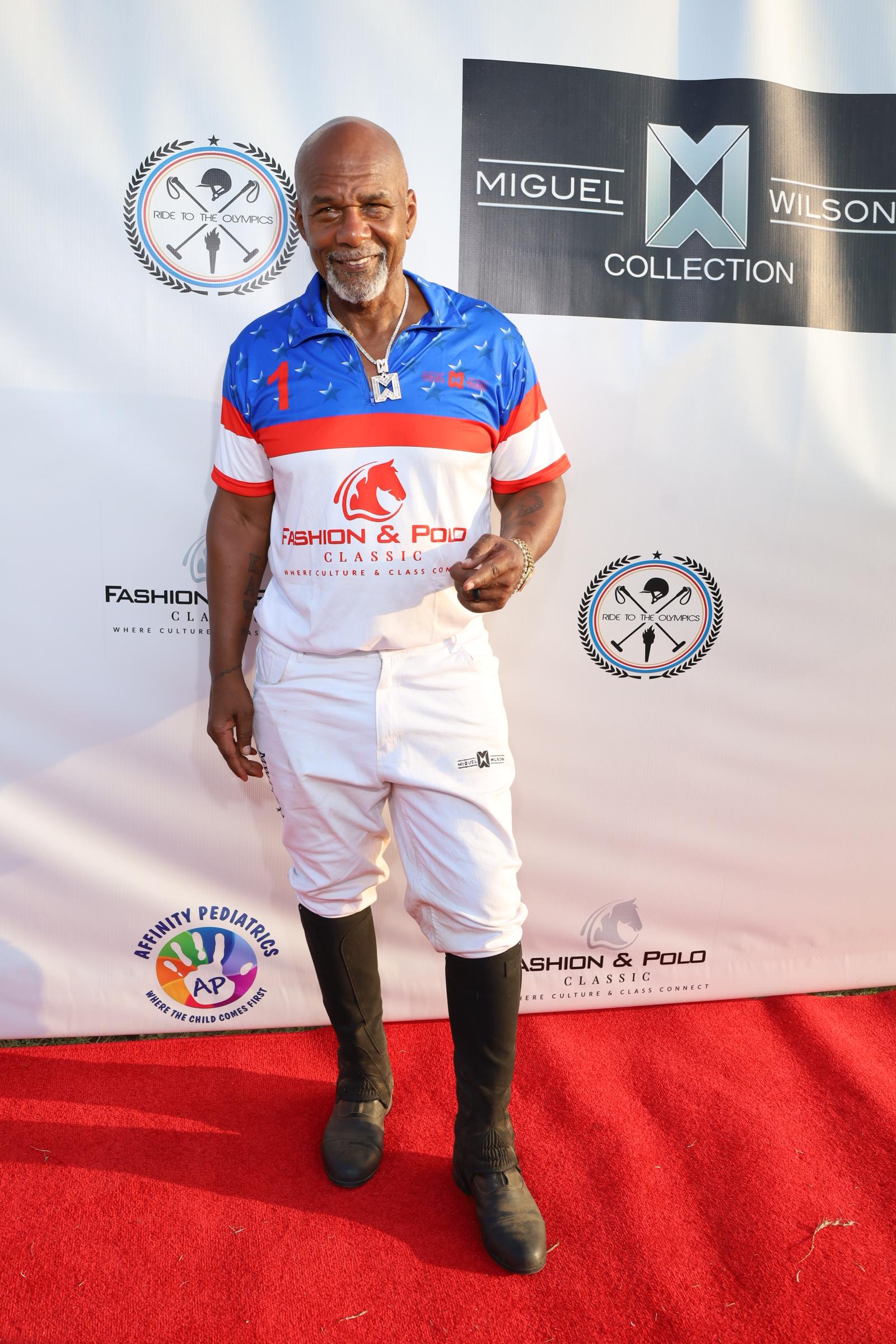
Miguel Wilson, cofounder of the Atlanta BEST Polo Team at the 2025 8th Annual Atlanta Polo Party. Photo by Phil Jackson.
And he means it. Wilson’s foundation covers everything — lessons, horse rentals, gear, uniforms, equipment, you name it — ensuring students can focus on learning, competing, and growing, both in and out of the saddle.
Soul Symphony Weekend: Fashion, Polo, Big Names, Bigger Purpose
This year’s Soul Symphony Weekend (the glam reboot of the Atlanta Fashion & Polo Classic) ran September 19–21 and brought out a seriously star-studded crowd. Between the black-tie gala, the fashion show, and a lineup of fast-paced polo matches, guests mingled with Governor Wes Moore, Atlanta Mayor Andre Dickens, and a long roster of TV personalities, actors, musicians, and community leaders.
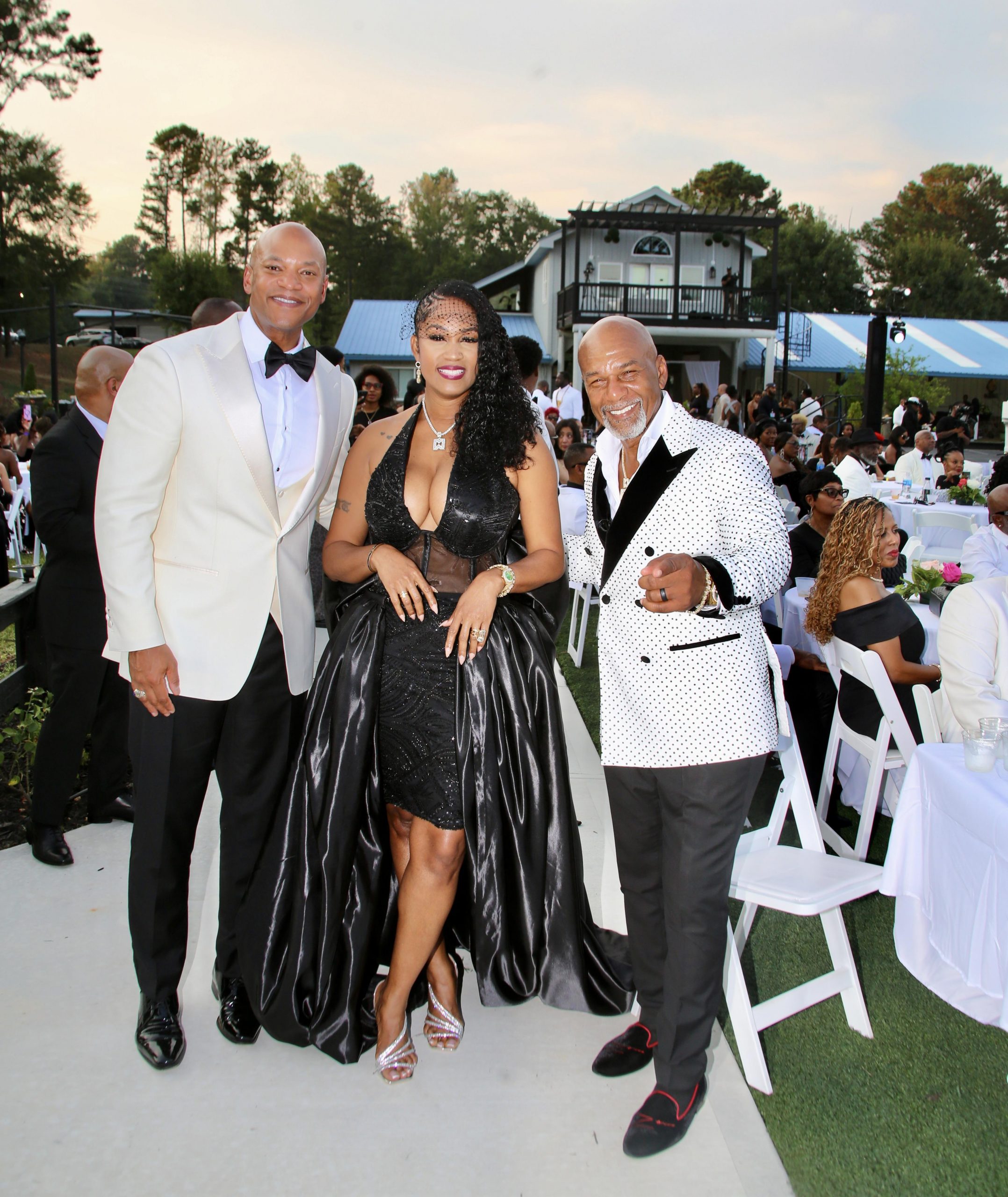
Maryland Gov. Wes Moore with Chancey and Miguel Wilson at the 2025 Black-Tie Soul Symphony. Photo by Darrell Stoney.
But at the heart of all that glitz? Raising funds for the Ride to the Olympics Foundation — and celebrating the young riders who are redefining what the future of polo looks like.
Building Riders, Leaders, and Opportunity
BEST Academy principal Robert Williams said the polo program has done more than teach students how to tack up and make a clean neck shot.
“The students have grown as leaders on campus and have really strived for excellence both on the field and off,” he shared. “When the opportunity came to partner with Miguel Wilson and the 100 Black Men of Atlanta, we knew it was something special.”
Wilson isn’t new to breaking ground in the sport. Back in 2019, he co-founded the Morehouse Polo Club — the first polo team at an HBCU (Historically Black Colleges and Universities) — and he’s continued to expand youth access to the sport ever since.
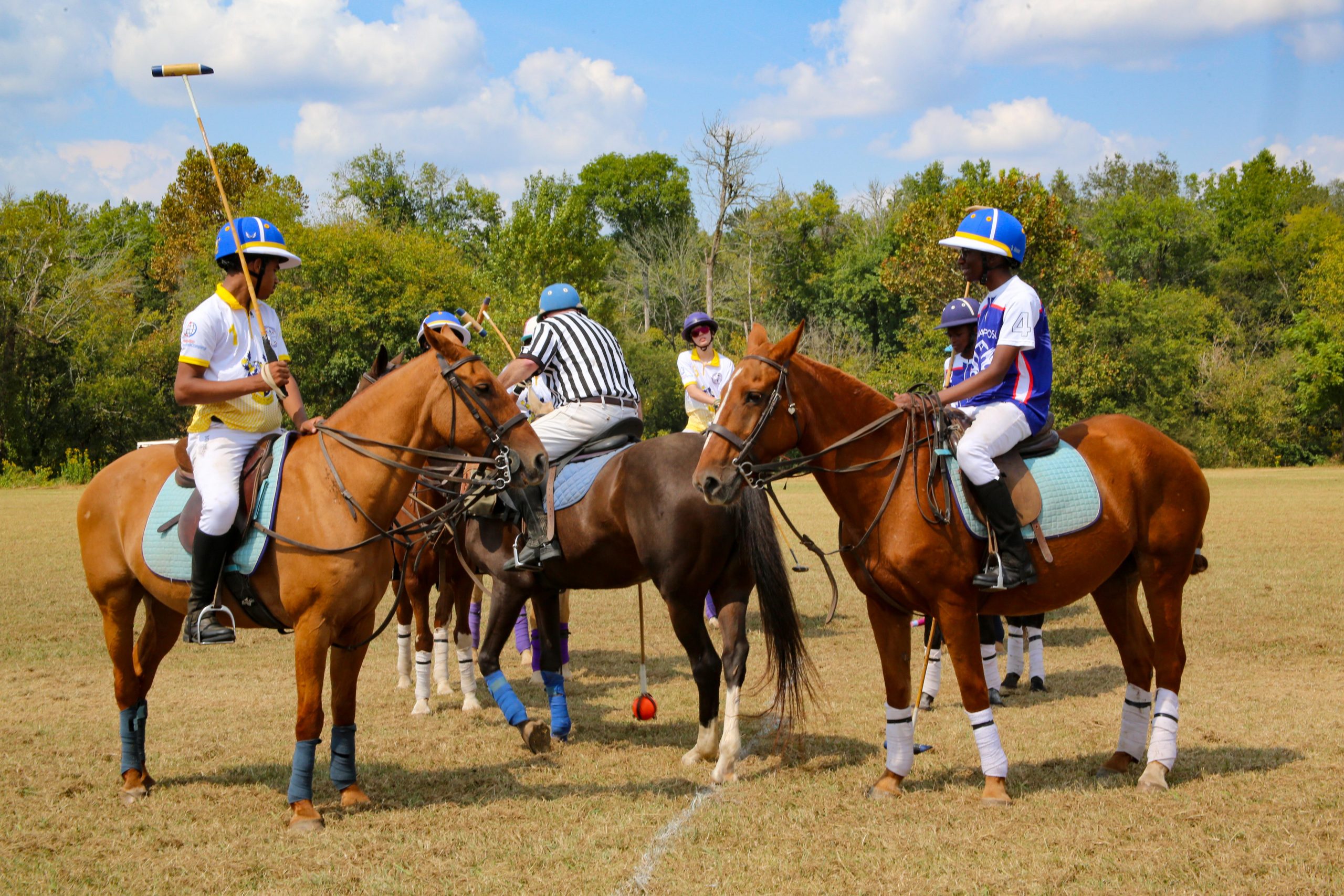
Atlanta BEST Academy Polo Team vs the Starr Creek Polo Club at the 2025 8th Annual Atlanta Polo Party. Photo by Darrell Stoney.
What’s Next?
All proceeds from the Soul Symphony Weekend go directly to the Ride to the Olympics Foundation, helping keep the Atlanta BEST Academy Polo Team galloping forward while supporting new youth polo programs around the country.
Want to learn more or support their mission? Check out ridetotheolympics.org.
Because this is the kind of equestrian future we love to cheer for.
About the Ride to the Olympics Foundation
Founded in 2017, the Ride to the Olympics (RTO) Foundation is a nonprofit organization that provides underprivileged youth access to equestrian sports, fashion, and leadership development. The foundation is dedicated to increasing awareness and participation in polo, showjumping, and dressage while fostering diversity and community engagement. Founder Miguel Wilson believes that equestrian sports, having played a pivotal role in his life and achievements, can provide youth with access to similar or greater opportunities.
Giving Back to the Horses That Give Us Everything 13 Nov 2025, 9:05 am
They may not understand that they are champions, but I do and that knowledge guides every decision I make in their service.
Every time I enter the show pen, I am aware that beneath me is a horse who gives everything they have: every ounce of trust, measure of strength, and fragment of effort. They do not understand they are chasing buckles, checks, or titles. They are indifferent to ribbons, prizes, and points. They are there because I have asked them to be. That realization is profoundly humbling.
Horses do not comprehend the concept of victory. They do not cross the timer line or execute a flawless pattern with an awareness of success. What they understand is far simpler and deeper: they gave their rider what was asked of them. They give everything, every single time, and in return, they ask for almost nothing. For that reason, giving back to them is an ethical responsibility.
When I reflect on it, I recognize that horses owe us nothing. They do not choose the life of an athlete, nor do they volunteer to travel, compete, or perform at an elite level. Yet they show up, time and again, with a willingness and heart that cannot be taught. They give us their trust, effort, and partnership freely. The least I can do is ensure that every aspect of their care reflects the gratitude and respect they deserve.
I strive to give back to them through thoughtful, consistent care and intentional acts of comfort and appreciation. My goal is not simply to maintain them, but to help them thrive: to ensure they love what they do rather than merely endure it. I want my horses to step into the arena feeling their best, both physically and mentally, and to know, through the way they are treated, that their worth extends far beyond any score, title, or buckle.
It begins with something simple: hay.
My horses always have free-choice hay available, especially when we are traveling or showing. It is far more than mere sustenance. It provides comfort, consistency, and a sense of stability in environments that can otherwise be stressful and unpredictable. Continuous access to forage helps buffer the stomach against the acid buildup that often accompanies the anxiety, exertion, and confinement of competition settings.
From a physiological standpoint, a horse’s digestive system is uniquely designed for near-constant grazing. In the wild, horses spend up to 16 – 18 hours per day consuming small amounts of forage. Their stomachs continuously secrete gastric acid, whether or not food is present. Without consistent access to hay or pasture, that acid can accumulate and damage the stomach lining, increasing the risk of gastric ulcers; a condition reported to affect an estimated 60–90% of performance horses. Beyond the physical discomfort, gastric pain can manifest as behavioral changes: irritability, reduced appetite, girthiness, or even reluctance to perform.
Providing free-choice hay helps mimic a horse’s natural feeding rhythm, keeping the digestive tract active and buffered throughout the day. The simple act of chewing also stimulates saliva production, which naturally neutralizes stomach acid. In addition to its physiological benefits, the steady availability of forage offers psychological comfort, giving horses something familiar and grounding in the midst of travel and competition.
If I can offer something that keeps their bodies balanced and their minds at ease, I will always do so. In the end, ensuring constant access to hay is one of the most effective and meaningful ways to support their overall wellbeing.
During the summer months, one of the simplest yet most rewarding routines I maintain is hosing my horses down at the end of the day. After hours of exertion under the sun, there are few things more restorative for them than the comfort of a cool bath. They earn every one of those moments. While on the surface I am rinsing away sweat, dust, and grime, what I am truly offering is care, gratitude, and relief.
As I run the hose along their coats and rinse their legs, I take the time to reflect on the day; their effort, willingness, and the countless moments they could have resisted but chose to give instead. These baths are a quiet ritual, a physical act of appreciation that acknowledges the hard work they have done.
From a physiological standpoint, bathing after intense exertion serves several important functions. The evaporation of cool water helps lower the horse’s core body temperature, reducing the risk of heat stress and aiding recovery after physical performance. Rinsing sweat and debris from the skin also supports healthy thermoregulation and helps prevent irritation or bacterial buildup, particularly in areas where tack has been in contact. Clean skin and hair allow for proper pore function and improved coat health, supporting circulation and overall comfort.
Beyond the physical, there is a psychological benefit as well. Many horses visibly relax during a bath. The rhythmic motion of water and gentle scrubbing can release tension and promote calm after the sensory stimulation of a busy show environment. It becomes a transition from work to rest, signaling that the day’s demands are over.
In the height of summer, I believe they deserve that small reprieve. A bath is not just about cleanliness, it is a simple yet profound gesture of gratitude for the partnership and effort they give so freely.
When we are on the road, I always make time to hand graze. It’s a small act that holds tremendous value. Hand grazing offers my horses a small return to normalcy; a brief moment to simply be horses again.
Competition environments can be inherently stressful. Horses that are accustomed to regular turnout and open movement often find the confinement of a stall, combined with the sensory overload of showgrounds, to be physically and mentally taxing. Their routines are disrupted, their social interactions limited, and their opportunities for natural behaviors, like grazing, walking, and exploring, become scarce. Even 10 or 15 minutes of quiet grazing can restore a sense of calm and familiarity in an otherwise artificial setting.
From a physiological standpoint, the act of grazing has measurable benefits. The natural, low head position promotes healthy drainage of the respiratory tract and proper alignment of the spine and poll, something that prolonged stalling or intensive work can compromise. The slow, rhythmic chewing stimulates saliva production, aiding digestion and buffering stomach acid, much like the role free-choice hay plays in maintaining gastric health. But perhaps most importantly, hand grazing nurtures the horse’s mind. It gives them autonomy, a rare and gentle freedom amidst the structure of competition.
Hand grazing serves as a reminder that these remarkable animals are not machines designed for performance. They are living, breathing, feeling partners who experience stress and relief, anticipation and rest, just as we do.
Nutrition is one of the most essential ways I can give back to my horses. The work they do demands strength, stamina, and resilience, and meeting those needs begins with what goes into their feed bowls. My go-to is Triple Crown Senior Gold, a formula that keeps them strong, gleaming, and well-fueled for the physical and mental challenges that accompany travel and competition. It is balanced, nutrient-dense, and gentle on the digestive system, qualities that are critical for horses whose performance depends on internal harmony as much as external conditioning.
Proper nutrition extends far beyond maintaining appearance; it is foundational to every system within the horse’s body. Performance horses expend considerable energy not only during their events, but also in the stress of hauling, adapting to new environments, and maintaining muscle tone through consistent training. Diets rich in high-quality fiber, fats, and amino acids provide sustainable energy and support the repair and development of muscle tissue. In particular, Triple Crown Senior Gold includes added prebiotics and probiotics, which help maintain a stable gut microbiome; vital for digestion, nutrient absorption, and immune function.
The horse’s gastrointestinal system is highly sensitive to change, and nutritional imbalances can manifest as both physical and behavioral symptoms, ulcers, weight loss, dullness, or decreased performance. By prioritizing a feed program that supports steady energy release and digestive health, I can protect them from many of these issues and ensure they feel their best, inside and out.
I ask a great deal of my horses, and it is my responsibility to ensure they are equipped, nutritionally, physically, and emotionally, to handle what I ask of them. A well-fed horse is not only a stronger and more capable athlete but also a happier, more content partner. Providing the right nutrition is one of the most tangible ways I can express gratitude for all they give. It is an everyday act of care that translates directly into their well-being, their longevity, and ultimately, the joy they bring each time they step into the arena.
And then, of course, there are the treats…a lot of them.
I’ll admit, I have an 11-year-old kiddo who insists on generous treat distribution, and she may have created a few four-legged connoisseurs. The horses now recognize the routine with an almost comical precision. The moment they hear the faint crinkle of a peppermint wrapper or the unmistakable rattle of a treat bag, an entire personality parade begins.
My geldings transform into models of enthusiasm, ears perked, eyes bright, and expressions of pure delight. My mare, on the other hand, operates on a slightly different motivational system: ears pinned, a pointed glare, and a clear message that we are not delivering the goods quickly enough. It’s a dynamic that never fails to amuse me, even as I wonder who is really training whom.
While treats may appear to be a simple indulgence, they serve a genuine behavioral and psychological purpose. From a learning perspective, they provide positive reinforcement, strengthening the association between effort and reward. Beyond that, the ritual of sharing treats fosters connection. It is a small but meaningful exchange that says, “You did well.”
And as for my 11-year-old co-trainer? Her joy in offering treats has become its own kind of reinforcement, for kindness, patience, and the understanding that appreciation, even in the smallest form, matters deeply to the creatures who give us their all.
Just as humans require time to rest and recover, so do horses. Mondays are almost always reserved as their day off, and occasionally Tuesday joins it. After a weekend of hauling, showing, and giving every ounce of effort in the arena, my horses have earned a complete reprieve. They deserve the freedom to roll, nap, stretch, and reset without a saddle, schedule, or expectation.
It is easy, in the rhythm of training and competition, to overlook the fact that horses are true athletes. Their muscles experience fatigue, their joints bear repetitive stress, and their minds endure the same emotional demands that any competitor might face. Just as rest days are essential in human athletic conditioning to promote muscle recovery and prevent burnout, equine athletes benefit from deliberate downtime. Adequate rest supports muscle repair, replenishes glycogen stores, and helps prevent overuse injuries that can develop from continuous strain.
Equally important is the mental recovery that rest provides. Horses thrive on routine but also on balance; time to simply exist as horses, free from performance pressure or human direction. Granting them these unstructured days preserves not only their physical health but also their willingness to engage, their curiosity, and their overall soundness of mind.
Rest is not a luxury; it is an integral component of responsible horsemanship. Those quiet days are what allow them to return to their work fresh, eager, and ready to give their all once again.
And then, of course, there are the kisses because, truly, who can resist the soft, velvety nose of a horse who has carried you through it all?
Each day, I make a point to share a small moment of affection with every horse. Sometimes it’s a kiss on the muzzle, sometimes a well-aimed scratch in that one elusive favorite spot, and other times it’s simply standing together in quiet companionship. These gestures may seem small, but they speak volumes.
Research in animal behavior suggests that positive physical contact reinforces trust and reduces stress for both horse and human. So while it’s entirely possible that these affectionate moments benefit my stress levels more than theirs, I like to think they understand. In the end, a kiss may not improve performance or conditioning, but it strengthens the bond that makes everything else worthwhile.
Sometimes, after a run, I will pat my horse’s neck, still catching my own breath, and reflect on the reality that they have no awareness of the accomplishment we have just achieved. They do not comprehend that they may have clocked a personal best or that we are leading the standings. What they do understand is that I asked for their utmost effort, and they delivered it. This perspective is profoundly humbling and grounding. These animals entrust us with their hearts, their energy, and their wellbeing. The least we can do is ensure that the hands guiding them are kind, patient, and consistently filled with gratitude.
For anyone who competes, rides, or simply cherishes their horse, it is essential to recognize that equestrian performance is inherently a partnership. Success in the show pen is rarely the product of talent or training alone; it is the culmination of mutual trust. Trust is cultivated in the quiet, routine practices that sustain their physical health and mental well-being when no one is observing.
Provide them with access to hay and proper nutrition. Ensure they are bathed and groomed. Allow them moments of grazing, play, and rest. Reward them with treats, gentle affection, and intentional time. These consistent, seemingly small gestures sustain their spirit, maintain their willingness, and reinforce the partnership on which all achievement depends. While ribbons fade, buckles tarnish, and wins come and go, the foundation built through attentive, thoughtful care endures.
Every time I enter the arena, I take a deep breath and remind myself that my horses owe me nothing. They are not motivated by titles, prizes, or recognition. Their presence is an act of trust, loyalty, and, perhaps, affection.
Thus, I continue to give back through hay and nutrition, grooming and baths, grazing and rest, patience and kisses, and unwavering gratitude. This care is both a moral responsibility and a profound expression of appreciation. They may not understand that they are champions, but I do and that knowledge guides every decision I make in their service.
Thursday Video: A Hallowed Horse 13 Nov 2025, 8:27 am
Pope Leo XIV received an October surprise of the four-legged variety.
In a symbolic and equestrian-rich gesture, on October 15, 2025, Pope Leo XIV received an Arabian stallion named Proton from Polish breeder Andrzej Michalski, founder of the Michalski Stud Farm in Kołobrzeg-Budzistowo, Poland.
Proton’s pedigree is a nod to international equestrian heritage: born in the distinguished Janów Podlaski (Poland’s historic Arabian horse centre), his sire’s lines go back to the U.S. and his dam was bought from Jordanian royalty. Michalski said he chose a white stallion (but it’s really grey, right? we know this horse is grey…) because the color echoes the Pope’s white cassock — and because the Holy Father, during his missionary work in Peru, had been photographed on horseback, inspiring the gift.
Beyond its ceremonial value, the gift carries deeper purpose: Michalski’s stud farm is not only about breeding elite Arabians, it also operates a hippotherapy centre for children with motor or cognitive disabilities — showing that for Michalski, horses are tools for healing and hope.
The Vatican notes that Proton will take residence at the Vatican’s equestrian facilities in Castel Gandolfo.
Reader Photo Challenge: Farm Dogs 13 Nov 2025, 7:37 am
Enjoy these nine photos of farm dogs!
This week we asked to see the canines be-bopping around the farm. Enjoy these nine photos of farm pups.
Keep an eye out for next week’s photo challenge! We announce challenge subjects on Monday around the end of the day on both Instagram and Facebook.
Tradition Meets Technology: How Horse Racing Is Evolving in 2025 13 Nov 2025, 7:29 am
From real-time betting to immersive fan experiences, cutting-edge technology like WebRTC and 5G is revolutionizing horse racing — transforming it from a centuries-old tradition into a fully connected, interactive, and global sport.
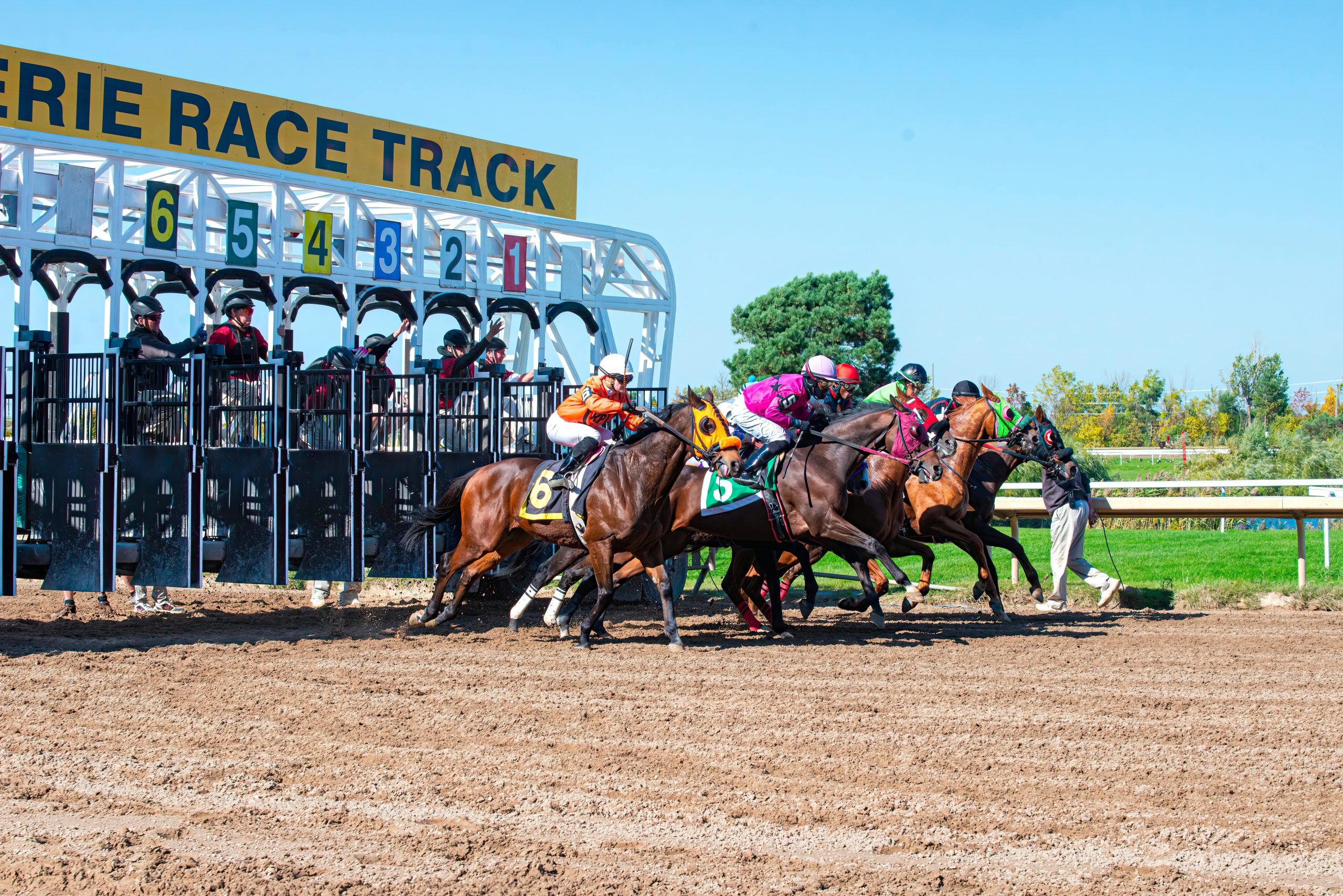
ColdBeer/Canva/CC
When it comes to horse racing, it’s all about its long history and rich culture. For a long time, this has been the case, until technology took root deeply in this industry, especially in live streaming. One might think that the only thing that will change in horse racing is how it is watched, but in reality, technology will fully transform the horse racing industry. Let’s delve in deeper.
WebRTC and 5G
The marriage between horse racing and live streaming is literally a match made in heaven. At the forefront of this endeavour, WebRTC and 5G serve as the foundation. Not only are they meeting the demand for instantaneous feeds, but they are also providing enhanced viewer experience by using high-definition imagery and sound.
Real-time technology is not just a leap for the horse racing industry; it’s also a business strategy that creates a much more enjoyable viewing experience for race fans. Nowadays, with sub-500ms becoming more commonplace, online bookmakers can host pre- and in-play bets for their users, encouraging high volume for these markets. Not only that, it’s a hit particularly for Gen Z viewers who value the quick-fire nature of these bets, which is both entertaining and exciting for them.
Profitable for Operators
Taking advantage of the current livestreaming state is not just about making an enhanced viewing experience to create loyal players, it’s also about looking into different revenue streams for platforms to take advantage of.
The in-the-moment engagement that live streaming and microbetting can transform casual viewers into loyal fans and because of this, operators can have multiple revenue streams, such as in-game betting, subscription services, horse racing promotions, virtual horse racing games, ads and sponsorships, simulcasting and data sharing, and even merchandising.
Fair Betting for Global Viewers
To add to the last section, real-time streaming is crucial for live horse racing betting because the race can change at any moment. A good bettor must always be ready to bet depending on what’s currently happening in the race, which is important for last-minute informed betting decisions, which usually have a lot of value.
This precision isn’t just about convenience; it’s also about giving bettors assurance that their bets are based on real-time data, not historical or delayed data. This is especially true for horse racing fans overseas. As we all know, delays are very common when covering a live broadcast outside our borders.
This is also very good for overseas bettors, since, as we all know, betting on horses beyond our borders can be wrought with difficulty, and the main problem is usually the delay in broadcast. However, given the current state of live streaming, this is no longer a problem. Nowadays, international bettors can comfortably bet even in-play games, making the playing level for them
What’s Next for Horse Racing?
The possibilities are practically endless. However, it’s also likely that most of the advancements in horse racing will centre on live streaming and on how platforms can profit from it creatively while also standing out from competitors.
- Better Fan Engagement. Platforms can use streaming to feature discussions with horse racing experts, owners, trainers, and jockeys. This will create an immersive experience and a closer look for horse racing fans around the world.
- Responsible Betting. Horse racing fans can also watch interviews with experts on responsible betting through streaming, becoming better educated and more aware of the problems it might entail.
- Expansion to Other Industries. It doesn’t have to centre around horse racing events. Platforms could also use other media, such as movies, TV shows, and even books about the history of horse racing and horses. This will not only generate more profit for platforms but also create buzz for horse racing outside of events.
Culture and Technology Combined
Gone are the days of going to the stadium and standing in line for tickets. With the technological advancements of today, one can even do a lot more than pre-racing bets, but also in-play bets that rely on precise live streaming infrastructure. This makes it exciting for bettors and experts alike.
